
Shrink That Footprint

Discover Ecotourism in Mexico: A Comprehensive Guide to Sustainable Travel
By: Staff Writer
Introduction – Ecotourism In Mexico
Ecotourism represents a mindful travel approach, considering both environmental impact and unique cultural experiences. This guide aims to introduce you to the ecotourism in Mexico, uncovering a path to sustainable travel.
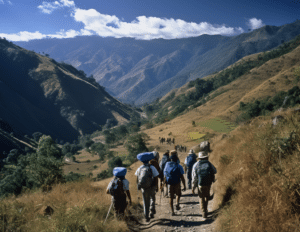
What is Ecotourism in Mexico?
Ecotourism in Mexico revolves around sustainable travel that considers the environment and benefits local communities. This concept germinated in the 1980s when Mexico started promoting sustainable tourism to conserve its diverse ecology and rich cultural heritage.
Top Ecotourism Destinations in Mexico
Mexico offers vast ecotourism destinations promising physical beauty and immersive experiences. Visit the whale nurseries in the Baja California Peninsula, the monarch butterfly reserves of Michoacán, or the pristine beaches of Tulum. Among its hidden gems is Xochimilco, a UNESCO World Heritage site, known for its extensive system of canals and floating gardens.
Eco-Friendly Resorts in Mexico
Playa Viva is an eco-lodge made entirely from natural materials. Located in Juluchuca, the resort offers yoga sessions, locally-sourced meals, and unspoiled beachfront views. It truly epitomizes the spirit of sustainable living while offering pure relaxation and peace.
Situated within a massive nature reserve, Cuixmala presents a luxurious take on eco-tourism. The resort, inspired by Moorish architecture, offers organic farms, turtle conservation projects, and a variety of outdoor activities with minimum environmental impact.
Ecotourism Activities in Mexico
Ecotourism in Mexico extends beyond sightseeing – it’s about engaging with nature and culture. Try bird-watching in Sierra Gorda, jungle trekking in Lacandon, or assist a turtle conservation project in Puerto Vallarta. We tell you a bit about each activity here.
Bird-watching in Sierra Gorda
Sierra Gorda , located in the heart of Mexico, is one of the most ecologically rich and diverse places in the country.
It is home to hundreds of bird species, some of which are endemic and can’t be found anywhere else in the world, making it a paradise for bird watchers.
Guided tours led by knowledgeable locals or professional ornithologists provide an excellent way to learn about these birds and their habitats.
Observing these birds in their natural environment is a deeply enriching experience, and it also contributes to the local economy, helping fund conservation efforts in the region.
Jungle Trekking in Lacandon
The Lacandon Jungle , located in the state of Chiapas in Southern Mexico, is one of the last remaining rainforests in North America.
It’s home to a rich diversity of plant and animal species, some of which are endangered.
Jungle trekking in Lacandon offers a unique opportunity to explore this dense and beautiful rainforest, providing a firsthand encounter with nature’s magnificence.
Tourists can hike through lush vegetation, see breathtaking waterfalls, visit ancient Mayan ruins, and learn about the traditional lifestyle of the indigenous Lacandon people, who have lived in harmony with the jungle for centuries.
Turtle Conservation Project in Puerto Vallarta
Puerto Vallarta , situated on the Pacific coast of Mexico, is known for its beautiful beaches, and is also an important nesting site for several species of sea turtles.
Each year, between June and December, turtles come ashore to lay their eggs.
The turtle conservation projects in Puerto Vallarta invite tourists to participate in a variety of conservation activities, such as night patrols to protect the turtles, collecting and relocating eggs to safe hatcheries, and releasing baby turtles back into the sea.
This hands-on involvement not only provides a unique and memorable experience, but also raises awareness about the importance of marine conservation.
Why Ecotourism in Mexico Makes Sense
You might be wondering whether you’re really supporting something meaningful for preserving natural ecosystems or is this a tourism gimmick.
Actually, ecotourism in Mexico makes sense for several reasons, especially considering the country’s unique geographical features, rich biodiversity, cultural diversity, and the current global trend towards sustainable travel.
- Rich biodiversity and unique geography : Mexico is one of the 17 megadiverse countries in the world, recognized by the United Nations for their exceptionally rich biodiversity. It is home to a variety of ecosystems, ranging from deserts and mountains to tropical rainforests and coral reefs, providing a plethora of opportunities for nature-based tourism.
- Cultural heritage : In addition to its natural attractions, Mexico is rich in cultural heritage, with numerous indigenous communities and historical sites. Ecotourism can provide a platform for these communities to preserve and share their culture, and create economic opportunities.
- Sustainable Development : As a part of its commitment to sustainable development, Mexico has an interest in promoting practices that balance economic growth with environmental protection. Ecotourism, by definition, involves low-impact, responsible travel that conserves the environment and improves the well-being of local people. It can serve as a tool for both conservation and sustainable development.
- Existing Protected Areas : Mexico has numerous protected areas and biosphere reserves, which are ideal settings for ecotourism. These protected areas are designed to conserve the country’s unique biodiversity, and ecotourism can provide the financial support needed for their maintenance and management.
- Global Trends : There is a growing global trend towards more sustainable and responsible travel. More and more travelers are seeking experiences that are environmentally friendly and that benefit local communities. Mexico’s commitment to ecotourism puts it in a good position to tap into this market.
- Economic Opportunities for Local Communities : Ecotourism often emphasizes local involvement and benefits. It can provide new job opportunities for local people, fund conservation efforts, and contribute to local economies in regions where other forms of economic development may be less feasible.
- Education and Conservation : Ecotourism often involves an educational component, promoting awareness and understanding of environmental and cultural issues. This can contribute to conservation efforts and foster a culture of respect for nature and indigenous cultures.
Carbon Reduction and Sustainability
Travel, though enriching, can inevitably contribute to the carbon footprint. Ecotourism in Mexico, however, is a conscious effort to reduce this environmental impact.
Consider using EcoBici , Mexico City’s public bicycle sharing system. It’s designed to promote sustainable urban transport and reduce CO2 emissions.
Sustainable Travel Tips
Sustainable travel means reducing your environmental impact while enriching the local economy and respecting traditions.
Buy locally made products, avoid single-use plastics, and use public transportation when possible. Also, consider resources like “Lonely Planet,” renowned for its responsible travel tips and guides.
Conclusion – Ecotourism In Mexico
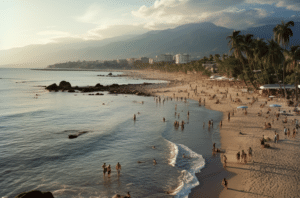
Exploring Mexico through the lens of ecotourism represents an effortless conservation effort, providing an unforgettable experience.
Your conscious travel choices will help protect Mexico’s vibrant natural and cultural heritage for generations to come.
Before setting off, be sure to delve into other practical resources like green travel guides and eco tourism handbooks.
Staff Writer
- Staff Writer #molongui-disabled-link Estimating Pool Pump Electricity Costs
- Staff Writer #molongui-disabled-link Empowering Your Journey: Navigating the World of Range-Extended Electric Vehicles
- Staff Writer #molongui-disabled-link Choosing And Installing An Alexa Compatible Light Switch
- Staff Writer #molongui-disabled-link Average Microwave Wattage: How Many Watts Does A Microwave Use
Leave a Comment Cancel reply
Save my name, email, and website in this browser for the next time I comment.

Epicure & Culture
Food, wine & culture for the ethical traveler
5 Best Places For Eco-Tourism In Mexico (Itineraries Included!)
This post contains affiliate links to trusted partners. If you purchase through these links, we earn a commission at no extra cost to you. Thank you!
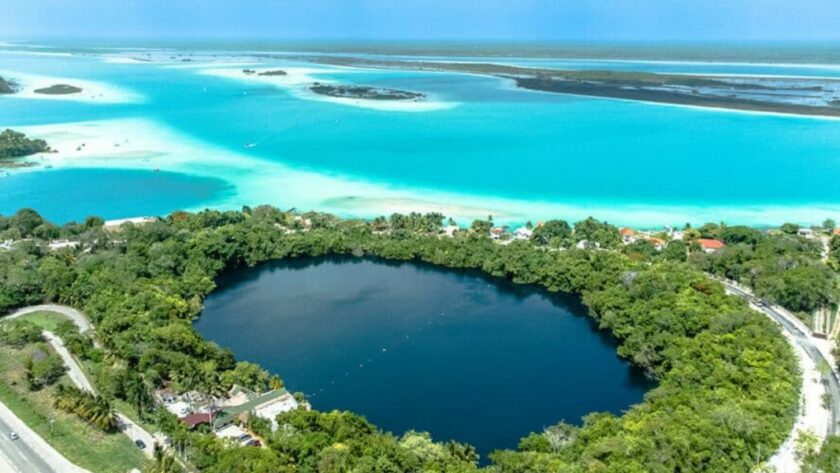
Looking for the best places for eco-tourism in Mexico ?
Then you’re in the right place!
When planning a trip to Mexico, you have limitless booking options for tours, hotels, and other experiences. And while having choices can be a good thing, it’s important to realize that not all of these options are ethical.
That being said, there are tour operators and accommodations that go above and beyond to help preserve the country’s natural wonders and promote responsible tourism in Mexico.
To help you have a positive impact through your trip, we’re sharing five eco-friendly itineraries in Mexico.
Additionally, you’ll snag important tips for how you can travel sustainably in Mexico and help to protect the environment.
Table of Contents
Defining Eco-Tourism In Mexico
But, first, what does “eco-friendly” actually mean?
While the definition varies slightly depending on who you ask, the Global Sustainable Tourism Council explains it as a niche segment of tourism in natural areas that particularly focuses on ethical, low-impact, locally-oriented trips.
It’s easy to confuse eco-friendly tourism with sustainable travel, as they’re similar; however, sustainability refers to “sustainable practices in and by the tourism industry, it is an aspiration for the impacts of all forms of tourism – all forms of tourism should be sustainable.”
So with that in mind, while we’re discussing how to plan an eco-friendly Mexico trip, the goal is really to be an all-around sustainable traveler — whether you’re visiting Mexico or somewhere else.
Remember, too, that small actions can have a huge impact, negative or positive. As travelers, let’s try to make our impact positive in the places we are so fortunate to get to visit.
On that note, let’s dive into our guide to green and responsible tourism in Mexico.
5 Best Places For Eco-Tourism In Mexico
Mexico currently has 40 UNESCO-designated biosphere reserves, which are defined as “learning places for sustainable development.”
This international label comes with a number of benefits, like access to funding resources for local conservation programs as well as education on the best eco-friendly practices for local authorities and the local population.
However, even with this label, there are still biosphere reserves where eco-friendly practices have sadly not been institutionalized by authorities, and so it is up to locals to step up and preserve the natural environment without the help of the law.
And while this guide to eco-tourism in Mexico focuses on some of the places where ecological practices are in place, we also aim to bring attention to areas that need help from locals and visitors to conserve the fragile environment.
On that note, let’s dive into our eco-friendly Mexico itineraries and tips.
1. Baja California Sur

When it comes to sustainable tourism in Mexico, Baja California has four areas that are labeled as biosphere reserves, and two of them particularly stand out as tourist destinations:
- The Sierra de la Laguna , located in the south of the peninsula, which has a spectacular contrasting ecosystem made of woodlands and scrub, including a lot of endemic vegetation. There are great hikes that you can do in the Sierra de la Laguna that are organized with full respect for the environment.
- The Gulf of California , with its hundreds of islands, islets, and coastal areas — not to mention a wealth of underwater creatures for which the Sea of Cortez earned the nickname of the “Aquarium of the World.”
Not only can enjoy unforgettable hiking in Baja California , but amazing tours organized by eco-friendly companies (mentioned below) are available all around Baja in places like Loreto, La Paz, Todos Santos, and Cabo on the Pacific Coast.
The local tour agencies that operate in these reserves must follow certain ecological practices in order to preserve the environment, including:
✓ When visiting Espiritu Santo Island you are not allowed to swim with the sea lions from July through September in order to leave the creatures alone during their breeding season. You can only watch them from a 50-meter distance from the boat and go swimming in other nearby areas.
✓ Swimmers are encouraged not to use sunscreen before jumping in the water. Instead, you can use practical rash guards for sun protection.
✓ Whale shark swimming tours are limited to a certain number of visitors, and swimmers must jump in the water in turns to avoid disturbing the whales’ routine.
✓ The blue whale watching tours in Loreto keep a safe distance from the whales to avoid disturbing them in their natural environment. Local tour guides also take part in educational programs to learn best practices for protecting these graceful giants.
Eco-Friendly Baja California Sur Activities
► Hike in the Sierra de la Laguna with Baja Sierra Adventures , a company offering low-impact experiences to small groups of visitors while providing locals with a source of income.
► See humpback whales in Cabo Pulmo Marine Park with El Cardumen , a plastic-free tour company committed to conserving natural resources while providing a unique, fun, and safe experience for visitors.
► Swim with whale sharks in La Paz with La Paz Divers , a company founded by two biologists who are passionate about marine life and its preservation.
► Swim with the gray whales in San Carlos with Todos Santos Eco Adventures , whose entire adventure team is Leave No Trace certified.
► Take a blue whale watching tour in Loreto with Loreto Sea & Land Tours , a small family-owned operator dedicated to offering conscious, quality experiences.
► Dive in the marine life-rich Sea of Cortez with La Paz Divers (mentioned above).
Getting Around Baja California Sur
To get around Baja California Sur, having a car is recommended as public transportation is not reliable and doesn’t reach many of the most interesting spots. You can use a platform like Discover Cars to quickly and easily price compare your options.
The other possibility is joining local tours organized by eco-conscious travel companies, a few of which are mentioned above.
Best Eco-Friendly Hotels In Baja California Sur
White Lodge Baja (Los Cabos). This eco-luxury wellness retreat features an onsite spa as well as 10 private cottages built in total harmony with nature. It’s located 45 minutes from the Historic Center of San Jose del Cabo.
Hotel Baja Club (La Paz). This historic mansion turned hotel is now one of the most luxurious properties in La Paz. Its architect, Max von Werz, is a fervent advocate of sustainable architecture. In fact, his team rescued original timber beams and recovered as much of the original materials as possible to create this beautiful hotel. The property’s onsite Greek restaurant also serves sustainable seafood.
Camp Cecil de la Sierra (Todos Santos). This luxury tent camp offers glamping on a local ranch in the Sierra Laguna Mountains. Along with gorgeous views, guests can enjoy homemade food, opportunities for cultural immersion, and organized tours around the local reserve. Check out a 2-night itinerary they offer here .
Baja California Sur is also home to some of Mexico’s best vegan hotels , like Marquis Los Cabos and Esperanza, Auberge Resorts Collection .
2. Campeche
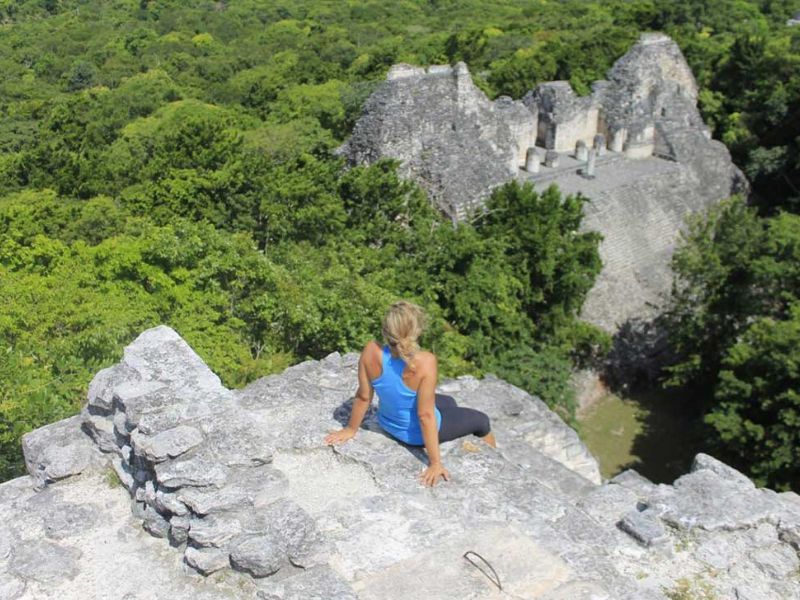
In the often underrated Mexican state of Campeche, you’ll find many incredible natural wonders, among which the spectacular Calakmul Biosphere Reserve particularly stands out. Visiting is one of the best things to do in Campeche .
Calakmul is the largest forest reserve in Mexico and, if you include the bordering countries of Guatemala and Belize, it becomes the second biggest forest in Latin America, after the Amazon.
Calakmul is also home to one of the most important and largest Maya ruins whose majestic temples peek out of the thick tropical jungle.
A visit to Calakmul requires some time and a car, which you can rent through Discover Cars , as there is much to explore inside the biosphere and in the surrounding areas.
The closest airports are in Chetumal as well as in Campeche, but you can also fly into Cancun or Merida and rent a car from there .
Honestly, Calakmul is a great addition to a Cancun itinerary , and if you have time you can plan a fantastic road trip on your way to the biosphere reserve and enjoy numerous cultural activities in the Yucatan Peninsula .
To explore Calakmul and its Maya ruins, you will need a full day — though if you also want to view wildlife, you’ll need to hire a local guide to take you inside the biosphere early at 6am. This is the best time to see the many bird species and other animals living there.
Note that only certified guides working for the Calakmul visitor center are authorized to enter this early with guests.
The visitor center is located in the small town of Xpujil and is a 45-minute drive from the Calakmul Biosphere Reserve. You should arrive a day early and book your guided tour for the following day.
That being said, if you have time, stay a couple of extra days in Xpujil to explore the local communities and their incredible artisan wares, from textiles to jewelry and home decor.
If you’re looking for authentic souvenirs from your eco-friendly trip to Mexico, consider purchasing these quality artisan goods, which also allows you to put money directly into the local economy.
The area is also full of fascinating archaeological sites hidden in the thick jungle as well as caves, pepper fields, and a lagoon.
Best Eco-Friendly Hotels In Calakmul
Chicanna Ecovillage Resort . Located on the road between Xpujil and Calakmul, this is a great option thanks to its convenient location and great value for money.
Hotel Puerta Calakmul . Located at the entrance of Calakmul, this resort is basic but very eco-friendly, and you will wake up surrounded by colorful birds — including toucans!
Rio Bec Dreams Hotel . This hotel has comfortable cabañas immersed in the tropical jungle at only a few minutes drive from Calakmul. The owners are also committed to eco-friendly practices, like collecting and using rainwater for the property as well as using greywater from the washing machine to flush the toilet.
3. Quintana Roo
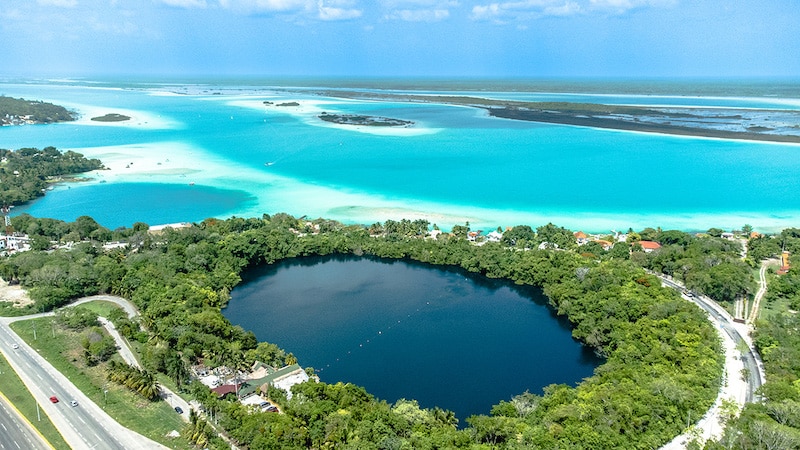
Quintana Roo is probably the most visited state in Mexico. Because of this, it’s more likely to see a significant impact on its fragile environments.
There are many interesting natural wonders in Quintana Roo, including the Sian Ka’an Reserve and the spectacular cenotes .
That being said, in this eco-tourism in Mexico guide, we’re focusing on the beautiful Bacalar Lagoon — often called the “Maldives of Mexico.”
Bacalar Lagoon is a clear example of how conscious practices by local people can make an enormous positive impact on the environment where government institutions haven’t yet done the work.
UNESCO has not denoted Bacalar as a reserve; however, it very much needs to be protected as one if we want to keep enjoying its pristine blue waters.
In fact, it’s called the “Lagoon of Seven Colors” for its spectacular seven shades of blue, which is what makes it so special. Here, you can swim, kayak, paddleboard, and bird-watch. Additionally, nearby you can visit a cenote, Maya ruins, and more.
The local operators that handle the sailing boat tours and non-motorized water activities have created an association called Agua Clara to promote the preservation of the lagoon and its fragile ecosystem, including the delicate stromatolites — layered sedimentary formations known as the Earth’s oldest living lifeforms .
Agua Clara members are trying to capture the attention of the public to ultimately get the support of local authorities, but with little success, unfortunately.
If you ask them, there are political reasons and economic interests that keep Bacalar Lagoon from becoming a natural reserve.
And while it’s understandable that finding a balance between preserving the environment and making a living can be challenging, one can’t ignore that the increasing number of motorboats is a threat to the lagoon’s ecosystem.
On top of that, local authorities have recently given authorization for jet skis, which were prohibited before, to operate. And because it’s lucrative for business, jet ski operators have quickly multiplied, which is another obstacle in keeping the lagoon clean and healthy.
Since the government is not helping, it is up to locals and visitors to step up and do the right thing.
Here are a few ways you can help preserve Bacalar Lagoon:
- Do not book tours on motor boats or jet skis
- Join sailing, kayaking, and paddleboarding tours instead
- Do not walk on the stromatolites or touch them in any way
- Do not use sunscreen, even if it’s reef-safe, before getting in the water
- Do not take anything from the lake, like sand
- If visiting Isla de los Pajaros (Bird Island) to see birdlife like parrots, parakeets, and green jays, it’s recommended to kayak there and not get too close to the shoreline to avoid disturbing the birds
Best Eco-Friendly Hotels In Bacalar
Casa Lamat . This is a stylish eco-friendly hotel on the lagoon that has developed its own system for the correct use of water, trash, and electricity. They also promote non-motorized activities and use low-flow showerheads, low-flush toilets, and biodegradable soap, among other things.
MIA Bacalar . This high-end eco-friendly hotel in Bacalar keeps their energy to a minimum by using an intelligent system while their water is recycled and treated to irrigate the gardens. These are just a few of the many steps this property takes to operate sustainably.
4. Queretaro
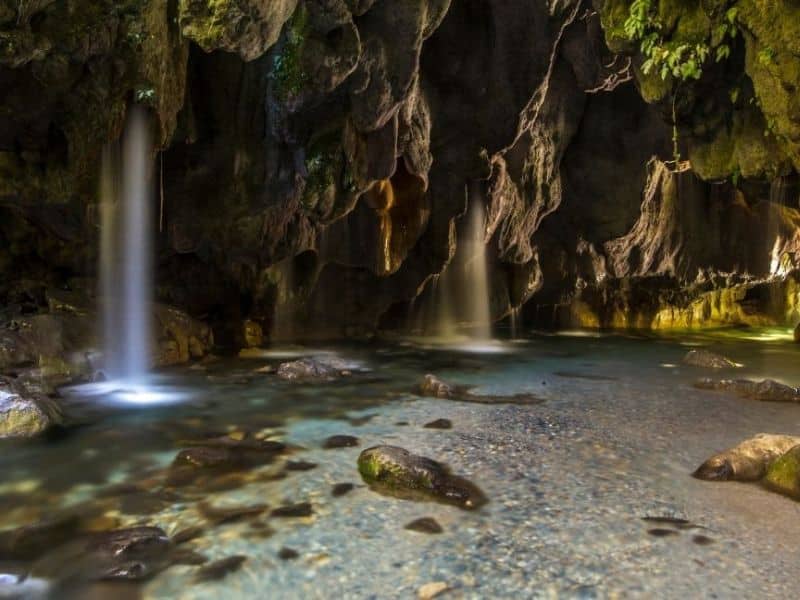
Queretaro is one of the smallest states in Mexico and yet has some of the country’s most diverse ecosystems — such as the Sierra Gorda , a UNESCO Biosphere Reserve.
Much of the credit for this goes to a woman named Martha Isabel “Pati” Ruiz Corzo who, in 1987, co-founded GrupoEcologico Sierra Goxrda (GESG) with Roberto Pedraza Muñoz and local residents. Their goal: to get people caring about the biodiversity of the region.
To do this, she built alliances with other local organizations committed to the preservation of the reserve.
There are actually 10 reserves within the Sierra Gorda Biosphere dedicated to the preservation of local wildlife and forestation, as well as to fighting poverty and climate change, supporting biodiversity, and aiding the regeneration of natural infrastructure.
The best way to enjoy the Sierra Gorda is by spending a few days in Pinal de Amoles or Jalpan de Sierra and taking tours with local guides.
One recommended local guide is Bernardo Resendiz. He’s a certified bilingual guide based in Pinal De Amoles and organizes tours in Spanish and English in the Sierra Gorda. You can view his Facebook page and YouTube channel , or email him at [email protected] .
Alternatively, you can stay in one of the local Sierra Gorda ecolodges and book your tours directly with them.
Eco-Friendly Sierra Gorda Activities
► Hike to El Chuveje Waterfall , which offers a spectacular trek along a river until you get to the beautiful waterfall surrounded by lush vegetation.
► Hike along the Cañón de la Angostura in Pinal de Amoles, a spectacular trail in a canyon that leads you to a natural pool with small waterfalls.
► Head to the Cuatro Palos lookout to admire spectacular views of the mountainous landscape from above the clouds.
► Check out some of the old missions (churches) — especially Bucareli , which is located in the middle of a deserted area surrounded by hills and canyons.
Eco-Friendly Hotels In The Sierra Gorda
Sierra Gorda Ecotours offers sustainable lodging around Jalpan de La Sierra, a Mexican Pueblo Magico , and you can also book eco-friendly tours with them to explore the amazing biodiversity of the Sierra Gorda.
5. The State of Mexico

In the State of Mexico, you can enjoy many unique experiences in nature — like witnessing up to 1 billion monarch butterflies do their annual migration from Canada and the USA to this area of Mexico.
The Monarch Butterfly Biosphere Reserve , a UNESCO World Heritage site that borders the State of Mexico and Michoacán, is one place to witness this natural phenomenon. This reserve aims to protect the butterfly species and its habitat, as it’s home to many important overwintering sites for the monarch.
From the lovely colonial town of Valle de Bravo , you can visit the reserve by car or taxi (which should cost around 200 MXN each way). You’ll need to get to Piedra Herrada , which is about a 40-minute drive.
Once you arrive, you can spend an entire day hiking the onsite trails and watching thousands of these beautiful butterflies flying around you. While there, it’s vital that you watch your step to avoid stepping on any.
Actually, it is required to have a local guide with you while visiting. Guides not only share important information about the local flora and fauna, but also help to ensure visitors follow best practices and avoid harming the butterflies.
Guides can be booked right at the entrance of the reserve, and will take you either on a short hike or on a horseback ride, depending on the kind of tour you want to take. The entrance fee is included in the tour.
Eco-Friendly Hotels In Valle de Bravo
Rancho El Reencuentro Eco-Hotel . This rustic chic hotel nestled in the countryside, just outside Valle de Bravo, offers stylish and spacious rooms as well as interesting activities like horseback riding, culinary workshops, and the opportunity to learn about their permaculture projects.
Hotel Rodavento . This luxury property in Valle de Bravo showcases 35 spectacular private suites scattered around the forest and overlooking a lake. Guests will enjoy relaxing by the pool, getting pampered with organic spa treatments, or doing onsite adventure activities like ziplining and climbing.
General Tips For Eco-Tourism In Mexico
Whether you’re aiming to plan an eco-friendly Mexico itinerary or a trip to another destination, here are a few best practices to keep in mind:
✓ Stay in a small locally-run hotel instead of an all-inclusive one.
✓ Use biodegradable mosquito sprays and sunscreens (when allowed).
✓ Do not use sunscreen or mosquito spray in Bacalar Lagoon, cenotes, and other places where it is not allowed (instead opt for rash guards ).
✓ Respect local eco-friendly guidelines that are shared with you.
✓ Do not touch or damage the local flora and fauna, including coral reefs and stalactites and stalagmites in caves and cenotes.
✓ Avoid motorized watersports when possible.
✓ Do not support animal-related attractions that keep animals in captivity. A great example is swimming with the dolphins, which is an irresponsible wildlife tourism option that promotes animal cruelty . Instead, follow ethical wildlife tourism guidelines .
✓ Don’t buy souvenirs that include shells or parts of living organisms.
✓ If you find trash on the beach or in the water, take it with you. You can use this free trail cleanup game to gamify the cleanup, too.
✓ Follow Leave No Trace principles by respecting local wildlife, not taking any natural elements you find like shells or rocks, and taking your waste with you.
✓ Avoid bottled water as much as possible by using a reusable water bottle and asking for a refill where available.
✓ Eat in locally-run restaurants and shop local to put money directly back into the local economy.
✓ Choose tour operators with a clear commitment to the environment as well as local people and wildlife. Typically, conscious operators will have a page sharing how their experiences promote responsible tourism, though don’t be afraid to email or call them to ask your own questions, such as the ones listed in this guide to avoiding greenwashing .
Eco-Tourism In Mexico: Final Thoughts
Traveling responsibly in Mexico is possible not only in protected areas where eco-tourism is ingrained in local policy and culture, but everywhere we go.
As travelers, we have the opportunity — and obligation — to ensure our impact is positive in the destinations we visit.
This is especially important to keep in mind when visiting places that are not officially designated as protected, as eco-friendly guidelines aren’t as clearly spelled out. Instead, it is up to us to maintain awareness and help to create necessary change.
What would you add to this list of best places for ecotourism in Mexico?
Bonus mexico travel resources:.
Artisanal Tequila Distilleries In Mexico You Need To Visit
6 Authentic Cultural Activities In Mexico’s Yucatan Peninsula
Vegan & Vegetarian Food In Mexico: The Ultimate Guide
Exploring Mezcal & Mushrooms In The Land Of The Zapotec
Isabella Biava
Isabella Biava is a relentless nomad who travels for the sake of traveling and photographing places. On her blog Boundlessroads.com she aims to inspire other women to travel solo, while on Letstraveltomexico.com she shares her knowledge of Mexico, where she has lived for the past 15 years.
You may also like...
5 fascinating tours that support locals in nyc.

The Wheel Deal: The Secret To Navigating Public Transportation With A Disability

5 Unique South African Tours That Benefit Local Communities

10 Awesome Ways To Celebrate Earth Day In The USA

Leave a Reply Cancel reply
Your email address will not be published. Required fields are marked *
This site uses Akismet to reduce spam. Learn how your comment data is processed .
- Meet the Team
- Our Manifesto
- Work with Us
- Budget Travel
- Personal Development
- Work & Travel
- United Kingdom
- More of Europe
- Philippines
- More of Southeast Asia
- More of South America
- More of Central America
- South Korea
- More of Asia
- More of North America
- New Zealand
- Pacific Islands
- More of Oceania
- South Africa
- More of Africa
- More of the Middle East
- Travel Essentials
- Travel Gear
Home » North America » 15 STUNNING Eco Resorts in Mexico [2024 Edition]
15 STUNNING Eco Resorts in Mexico [2024 Edition]
Mexico is a traveller’s dream. It’s hard to think of another place that offers this level of diversity. It will leave you will your heart full, and your belly even fuller.
It offers dry deserts, tropical jungles, white sand beach resorts, ancient ruins, and so much more; the list is endless. Because of this, Mexico is one of the most popular places to travel in the world . From spicy Mexican cuisine to snorkelling in the Caribbean sea, the opportunities for a relaxing retreat in Mexico are endless.
That’s why we’re pleased that Mexico is making such a good effort with their sustainable tourism. Many are understanding that preserving their local community with eco-friendly is vital.
Although hotels are fairly easy to find, considering eco-friendly and unique accommodation options in Mexico for your trip brings a new experience with it. For a peaceful and sustainable travel experience, check out some of Mexico’s best eco resorts.
There are loads of amazing eco-friendly resorts on offer, so how do you pick the best one? Well, we’ve done the dirty work to help you decide exactly what to look for, and what to expect from an eco resort in Mexico.
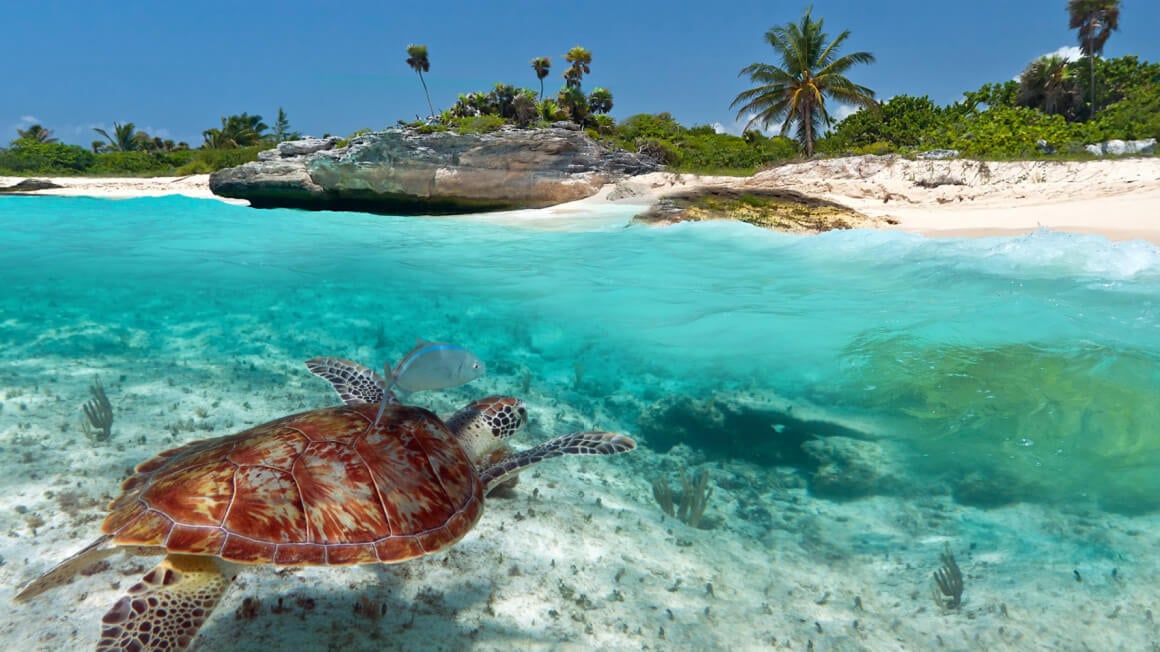
The Broke Backpacker is supported by you . Clicking through our links may earn us a small affiliate commission, and that's what allows us to keep producing free content 🙂 Learn more .
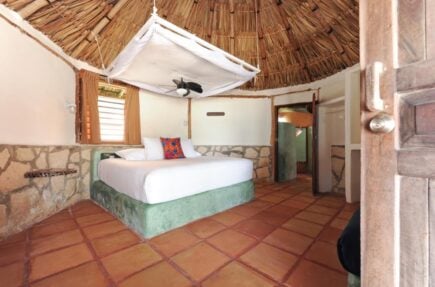
Zamas Hotel
- > Swimming pool
- > Beachfront location
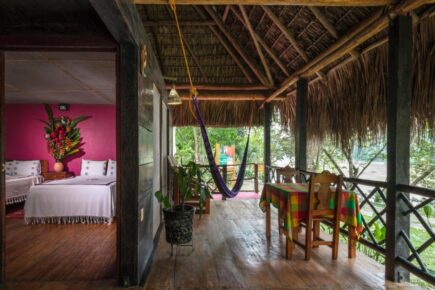
Las Guacamayas Lodge Resort
- > 1-5 guests
- > Room service
- > On-site restaurant
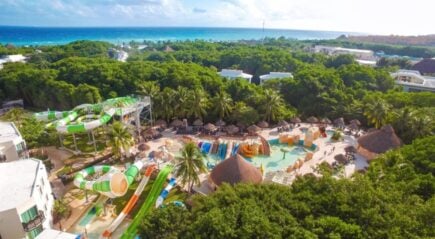
Sandos Caracol Eco Resort
- > Onsite waterpark
- > Numerous restaurants

Unlock Our GREATEST Travel Secrets!
Sign up for our newsletter and get the best travel tips delivered right to your inbox.
Staying in an Eco Resort in Mexico
The top 15 eco resorts in mexico , faqs about eco-friendly resorts in mexico, final thoughts on the best eco resorts in mexico .
Mexico is pretty large, and eco resorts tend to be in a more secluded setting, often close to stunning beaches or tucked away in jungle scenery. No need to worry about loud city noises.
Staying at an eco resort also means a unique Mexico travel experience . You’ll be removed from the main tourist scene so you can appreciate the country’s natural gems.
Eco hotels and resorts vary greatly from luxurious high-end spiritual retreats to smaller down-to-earth spots. However, you can always expect natural surroundings, a focus on environmental sustainability, and eco-friendly practices.
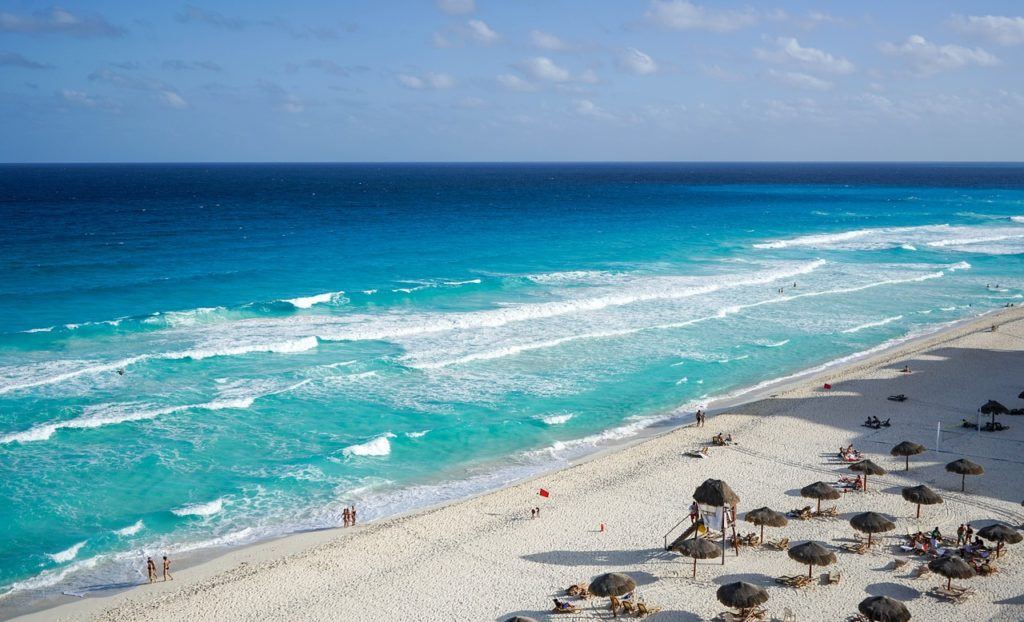
Thanks to Mexico’s diverse landscape and intriguing history, eco resorts offer a range of activities. You can enjoy palm trees, morning yoga, snorkelling, boating, or hiking activities. You’ll have the opportunity to choose somewhere that fits your travel style.
Eco resorts mostly offer private rooms, while some budget eco-friendly hostels follow traditional dorm-room models. Others have private bungalows, luxury tents, treehouses, or even cabanas.
Healthy food is also often included, dining is available onsite, or self-catering options. Most importantly, food waste is taken care of correctly.
So let’s take a look at the best options for you.
Now that you have an idea of what to expect at an eco resort, read on to discover our picks of the top 15 eco-friendly resorts in Mexico! Each of these places offers the chance for a relaxing escape from daily life amid peaceful, natural surroundings.
1. The Overall Best Eco Resort in Mexico – The House in the Woods
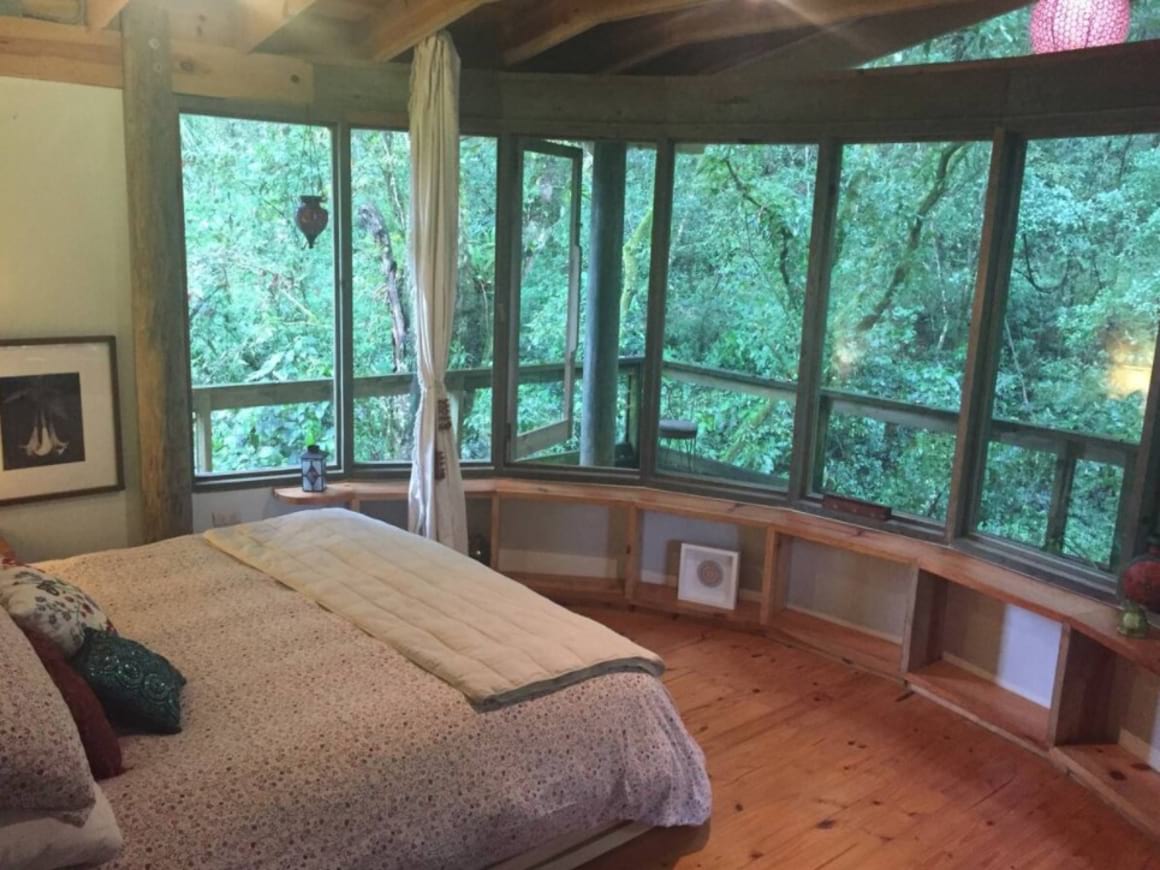
Located just outside of Xalapa, Veracruz, this beautiful woodland eco lodge is the perfect place to relax and take a break from it all. There’s a nature spa offering Temazcal and yoga sessions within walking distance. Alternatively, you might just want to stay at the lodge to enjoy the scenery.
There’s a deck with outdoor seating where you can admire the views. The cabin also has some modern comforts including a full kitchen, TV, and Wi-fi. You’ll feel right at home within this quiet and nature-loving local community, where you can appreciate the beauty and wildlife of the Mexican jungle.
Want to save money on accommodation?

We got you. For reals.
2. The Best Budget Eco Resort in Mexico – Las Guacamayas Lodge Resort
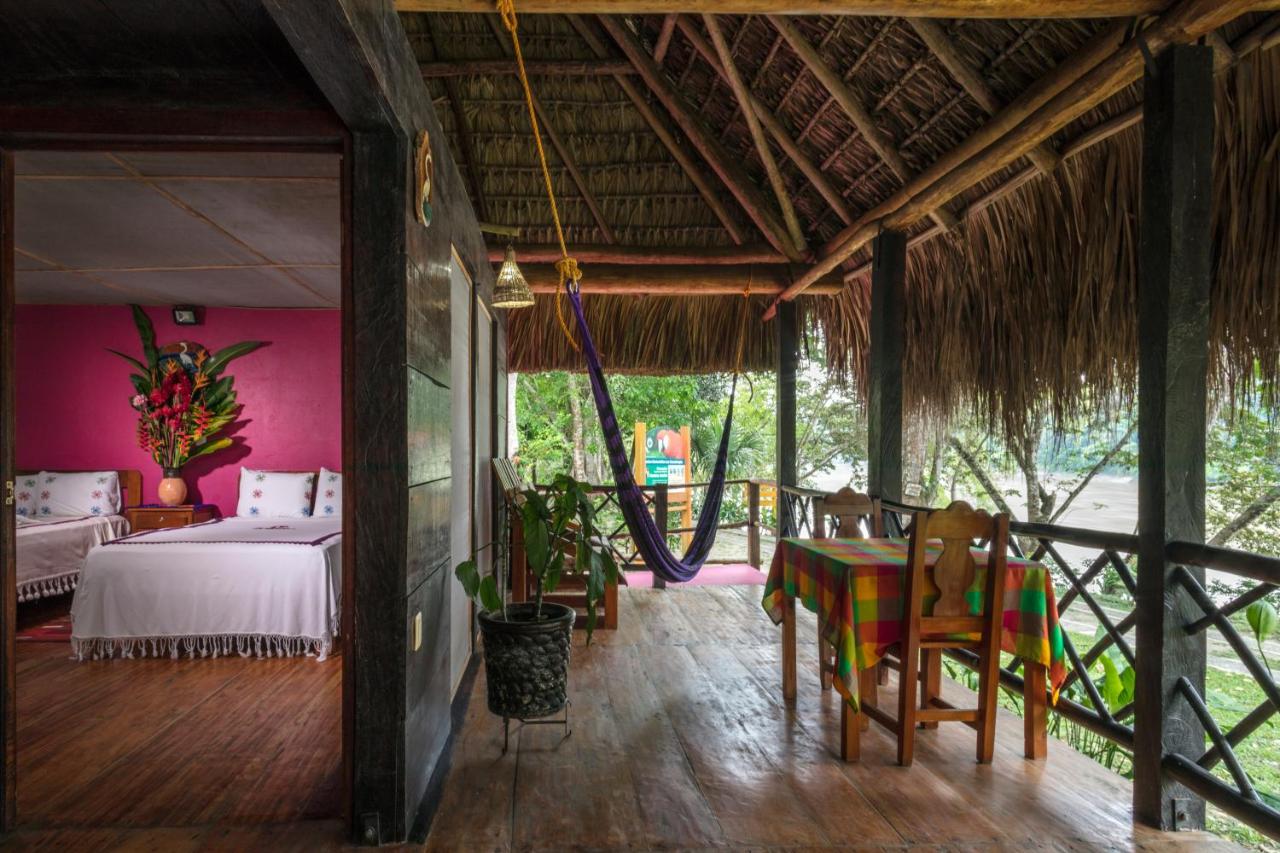
Surrounded by the lush, tropical scenery in the jungle of Chiapas, this eco-friendly resort is both budget and eco-friendly! They’re a perfect example of how sustainable tourism should be done. Their eco-friendly practices pay close attention to their surroundings, nurturing the jungle’s native species and constructing with natural materials.
Activities at Las Guacamayas are aplenty. Go hiking and canoeing, or take a boat ride to see the Azules Nature Reserve. And, of course, take time for bird watching with people who really care in this unique location.
Budget Tip: Dorms in Mexico start from $10USD per bed. They’re the cheapest accommodation in the city. Search for hostels in the area !
3. Best Eco Hotel for Families visiting Mexico – Sandos Caracol Eco Resort
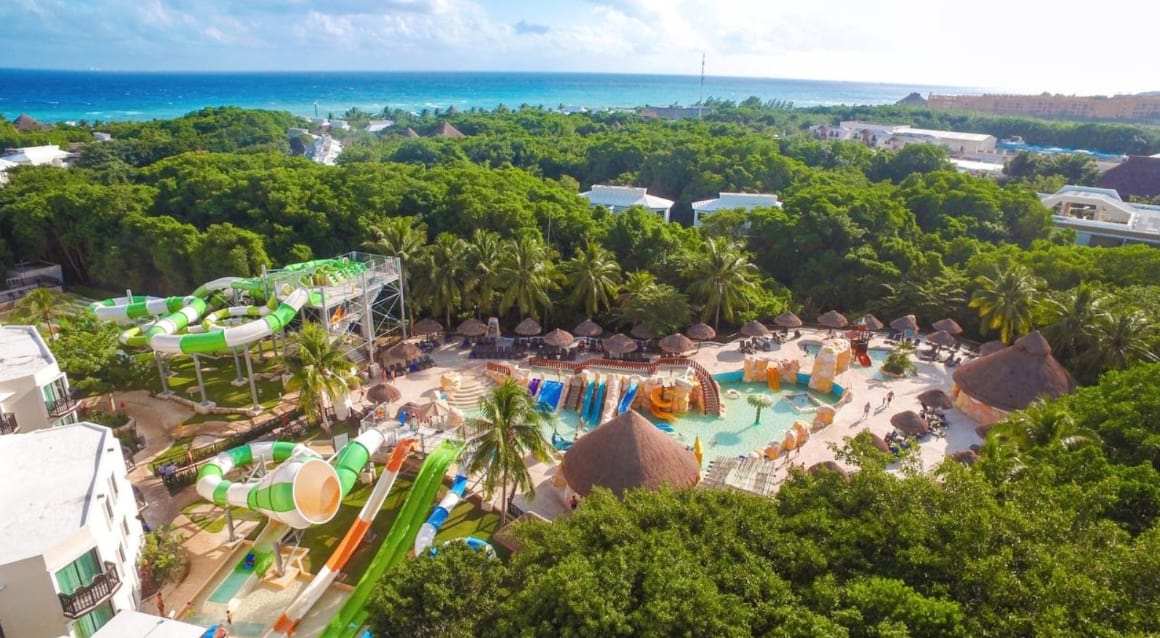
As far as eco-friendly all-inclusive resorts go, Sandos Caracol Eco Resort is a truly unparalleled luxury experience on the Yucatan peninsula. Staying in Playa Del Carmen is a great choice and this luxury experience is one of a small handful of resorts on the Riviera Maya working hard to reduce their carbon footprint.
Their sustainable energy is made up of renewable sources such as solar panels. They understand that without their local community, the Riviera Maya has nothing. So Sandos Caracol Eco Resort strives to protect its surrounding ecosystem.
Guest rooms include access to a private beach on the Caribbean Sea, free wi-fi, an outdoor pool, its own private terrace, and room service. There’s something for the whole family here too at this Eco Resort in Playa Del Carmen .
4. The Best Budget Eco Hostel in Mexico – Xkopek Native Bee Farm Camping
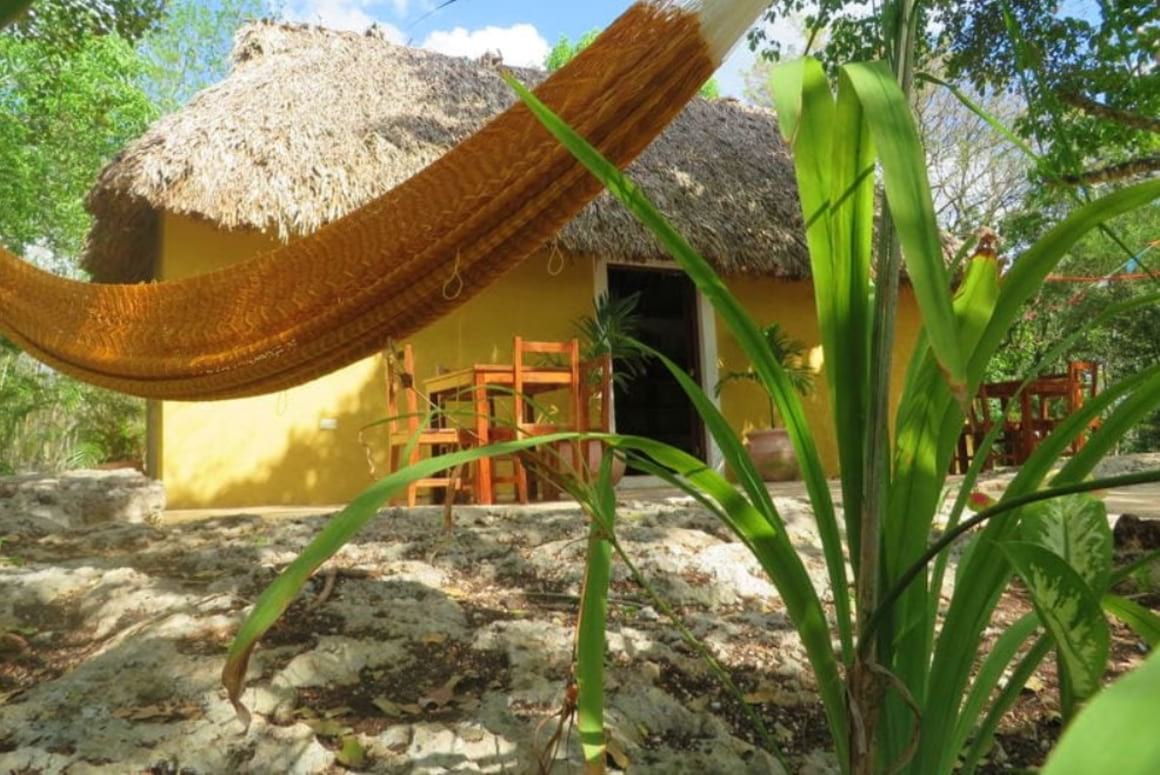
Just outside the city of Valladolid, Xkopek Native Bee Farm has rooms and tents available for budget backpackers hoping to find somewhere close to nature. Guests have access to a shared kitchen, showers and bathrooms, and bikes to rent for exploring the area.
Within Valladolid, you’ll find local markets, churches, museums, and historic ruins. Explore the Cenote Zací or travel a bit further to Chichén Itzá, then return to the peaceful and quiet campsite to relax in the garden.
5. Best Eco Hotel for Couples – Zamas Hotel
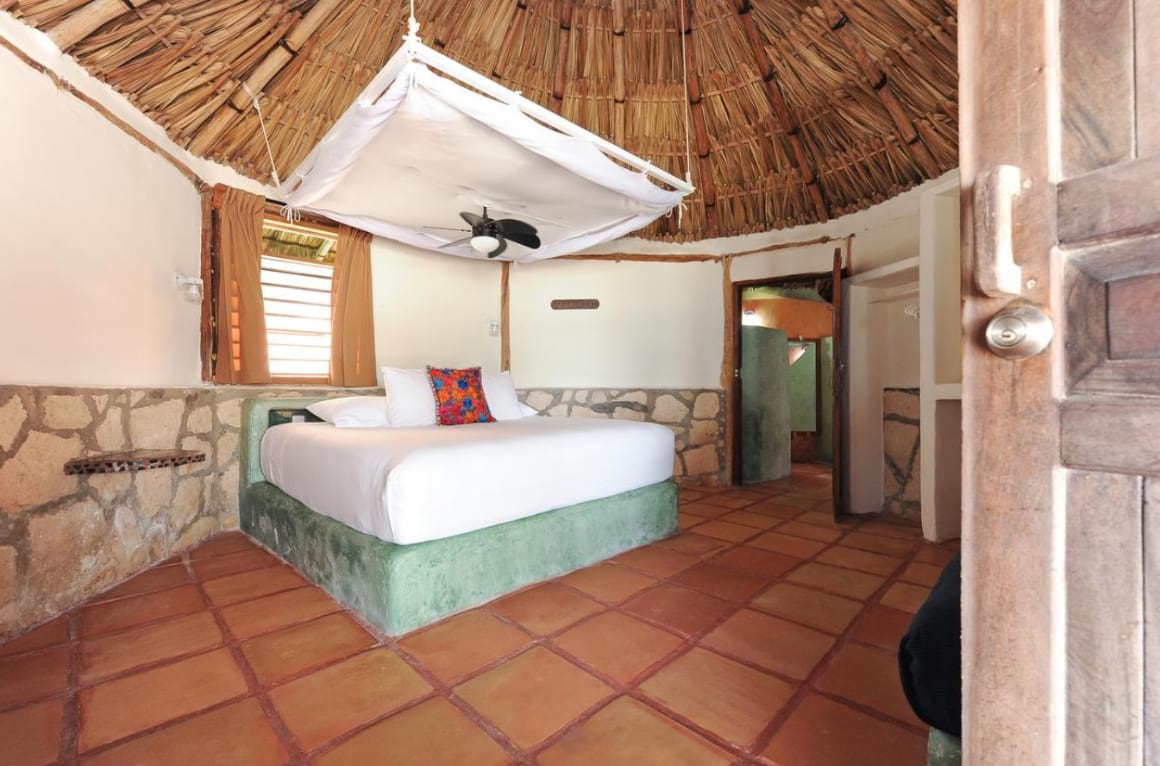
This eco-resort in Tulum is perfect if you want to treat your other half. Tulum is a popular city among tourists, known for its white sand beaches and ancient Mayan ruins. What better than to enjoy the wonders of this tropical paradise in an eco friendly hotel? The Zamas Hotel is a mostly electricity-free property, although a generator does supply limited lighting and Wi-fi in common areas.
During the day you can sign up for yoga classes, book a massage onsite, or rent gear at the diving shop to explore the tropical waters. Once the sun goes down, the candles and matches provided can be used to create a romantic atmosphere on the beach.
6. Another Great Eco Hotel for Couples – Cocolia Hotel, Mazunte
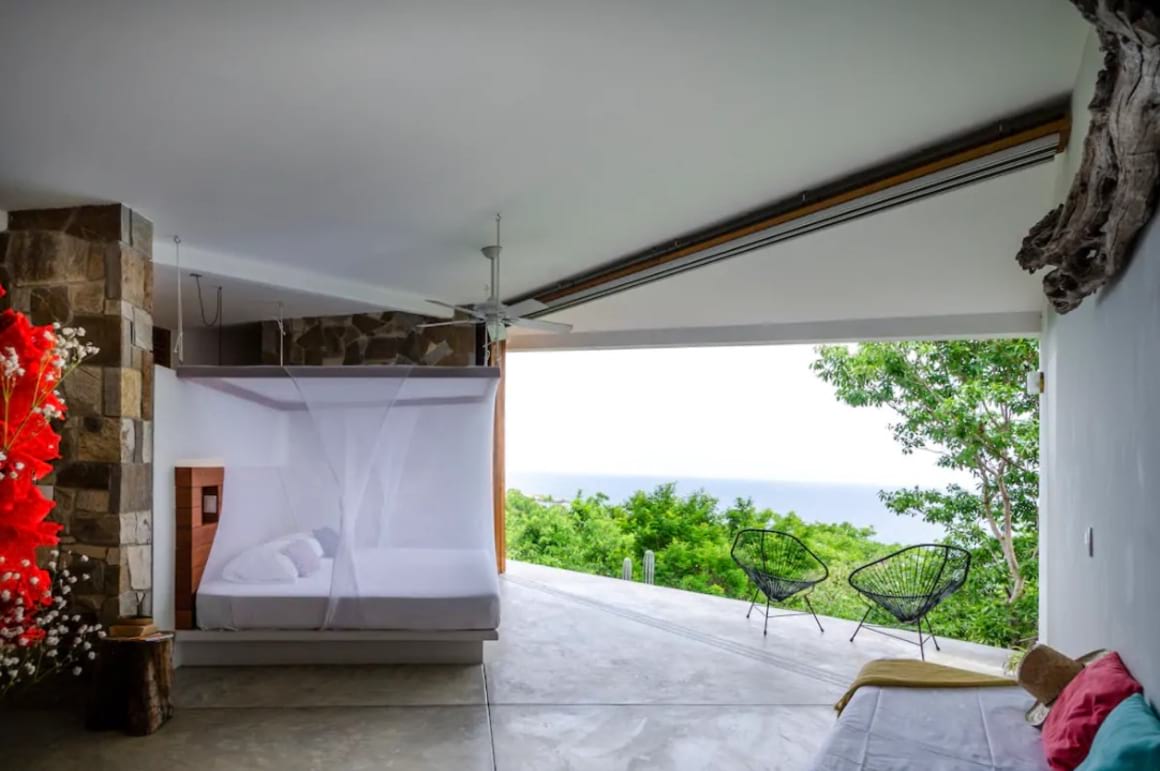
Enjoy a peaceful and romantic jungle escape at the Cocolia Hotel, located just outside of Mazunte. Your private bungalow features a king sized bed, expansive views of the jungle and Pacific, and even an open shower facing the ocean. Caliente.
You’ll have complete privacy in your bungalow, as well as access to public spaces including a salt-water swimming pool and onsite restaurant. The main energy source of the hotel comes from solar panels, and the buildings were designed to flow with the natural topography of the region to create a more sustainable and immersive nature experience.
7. The Best Eco Resort for a Group of Friends – Four Seasons Crocodile Bar and Cabañas
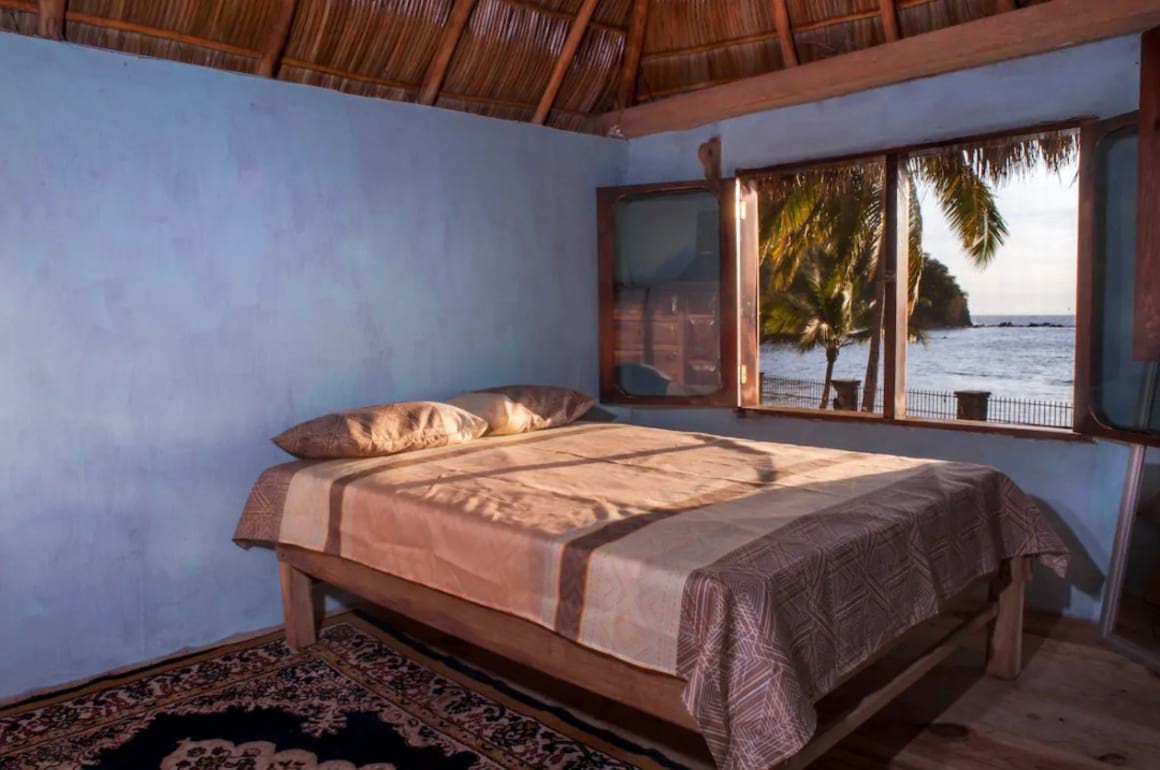
The rustic and charming cabins of Four Seasons are the perfect spot to enjoy a beach vacation on the Jalisco coast of Mexico. There are several cabins to pick from depending on your group size, each featuring beachfront access and a palapa roof.
The peaceful charm of La Manzanilla makes it a great place for relaxing on the beach. You can check out one of the local restaurants in town, or just eat at the Crocodile Bar onsite and watch the sunset over Tenacatita Bay.
8. Over-the-Top Luxury Eco Resort – Chablé Yucatan

As long as your budget allows, the Chablé Yucatan eco resort offers a truly unparalleled luxury experience on the Yucatan peninsula. Each room features its own private terrace and pool, plus guests all have access to the high-class spa, free bikes, and large swimming area.
Rooms don’t come cheap, but they really do have it all when it comes to comfort and service. Start with breakfast in your room, head out on a bike tour, enjoy an afternoon at the spa, then round off your day with a delicious meal at the highly rated La Chaya Maya restaurant and bar. Wind down with an evening dip in your private pool.
9. Best Eco Hostel for Backpackers – Nomadas Ecohostel
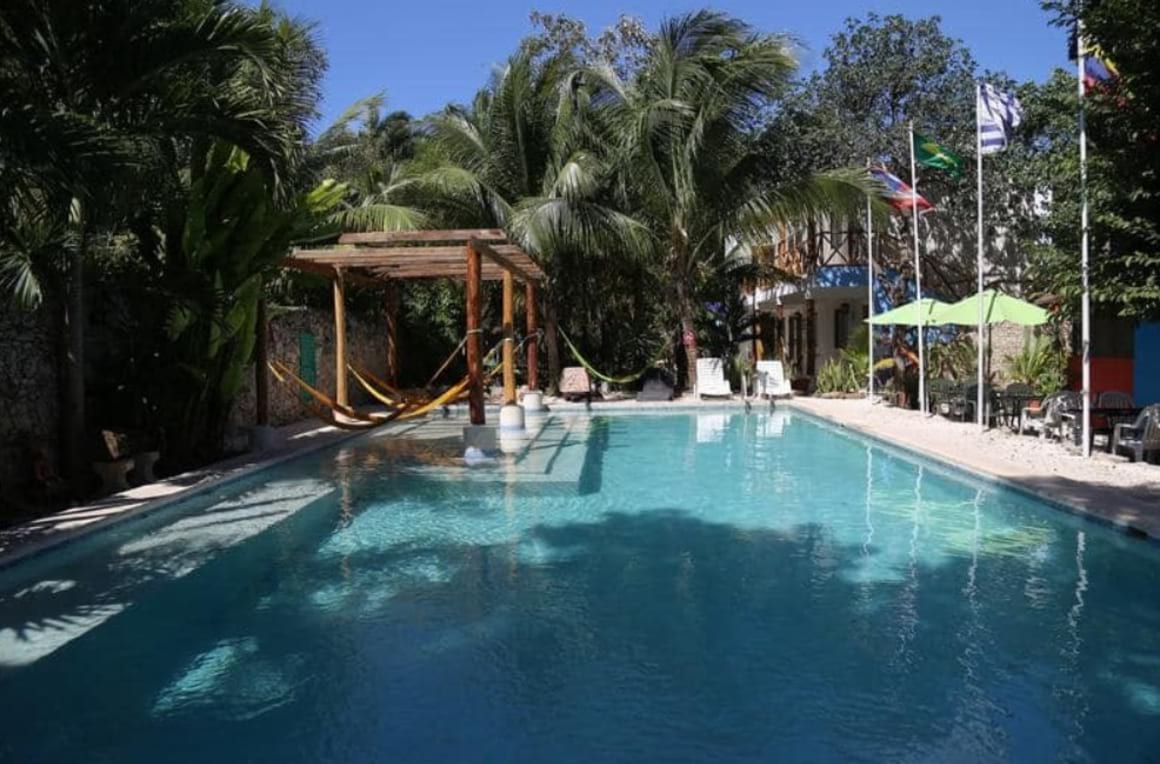
Located in the town of Mérida, capital of Yucatan and popular home-base for exploring Mayan ruins, this eco-accommodation has everything you’d want from staying in a hostel . Start off each day with a free breakfast onsite, take yoga, dance, or cooking classes during the day, and relax to live music in the evenings.
There’s plenty to see and do in Mérida, from touring museums to live music entertainment. On days when you just need to relax and take a break, you can lounge by the pool or read your favourite book in the comfort of one of the hammocks.
10. Best All-Inclusive Eco Resort in Mexico – Xinalani Yoga Retreat
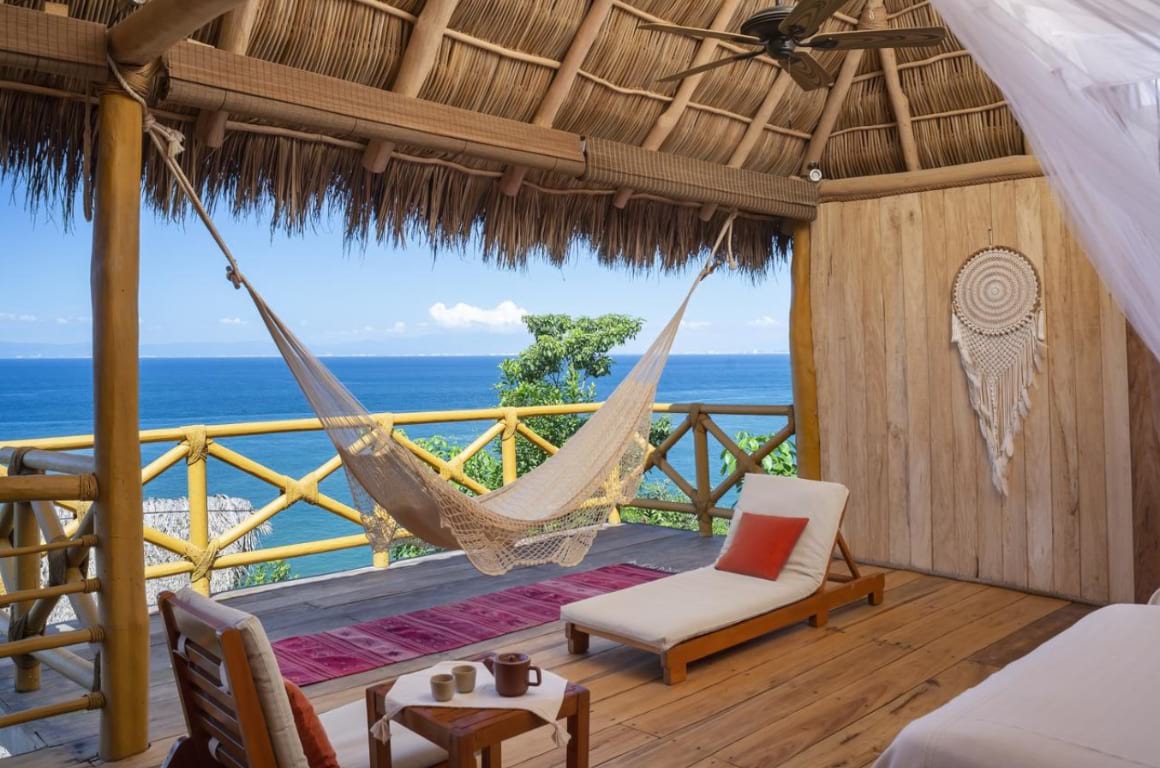
For the ultimate relaxing beach vacation in Mexico , the Xinalani Yoga Retreat is an excellent choice. This all-inclusive resort includes 3 meals and 2 yoga sessions per day in the room price. Plus there’s a swimming pool and private beach area, so you can spend as much time as you want relaxing on the sand.
The resort has excellent modern comforts like Wi-fi, fans or AC, but it also maintains a simplistic charm. Here, you can reconnect with nature and be undisturbed by the rush and traffic of daily life.
11. Best Eco Hotel for Solo Travelers – Tubohotel
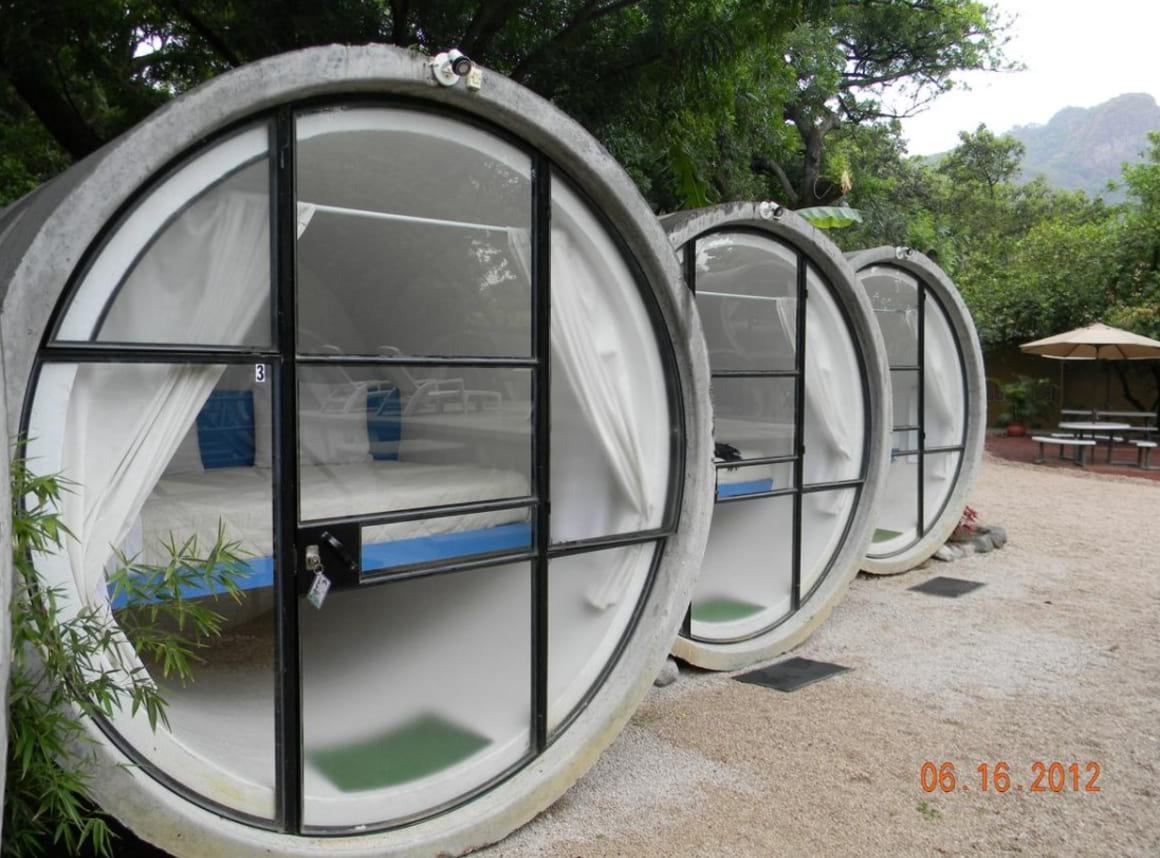
This unique hotel takes sustainability to the next level, by converting old concrete tubes into fun and classy accommodation. The large glass windows let in plenty of natural light and a view of the pool and garden, but the curtains provide full privacy when you’re inside.
Tepoztlán’s local markets and natural parks are pretty close by. If you just want to relax, get comofrtable in one of the beach loungers by the pool for a break. Each tube is perfect for solo travelers, but can also accommodate couples who don’t mind getting cozy.
12. Best Eco Hotel for a Weekend in Mexico – OYO Jolie Jungle Eco Hotel

If you only have a weekend to spend in Mexico, then the Jolie Jungle Eco Hotel is the perfect place to stay. Whether you’re flying solo or traveling with a large family, the bungalow has rooms of various sizes to accommodate all parties.
The eco design of the hotel makes it a perfect place to relax and reconnect with nature. Watch jungle birds out of your window, take a dip in one of the swimming pools, or relax in the traditional Temazcal steam bath. There are also bikes which are free to use, and nature trails on the property so you can appreciate the jungle scenery.
13. Best Eco Resort for Honeymooners – Cabaña Areca
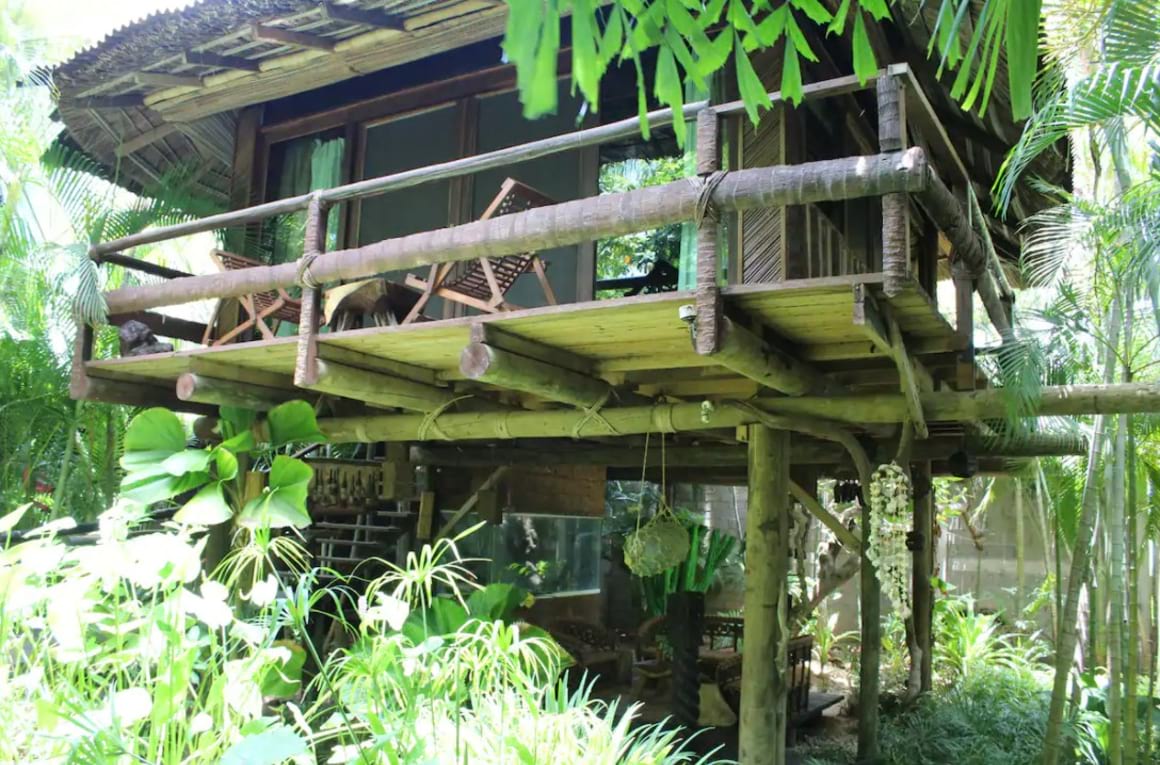
If you’re planning a honeymoon in Mexico, the Cabaña Areca offers a beautiful, private eco retreat for a romantic vacation. There’s no hot water or air conditioning, but the mild climate and open architectural design allows for natural air flow to keep the cabin perfectly comfortable.
You’ll be peacefully secluded in the jungle and surrounded by nature, but if you do want to venture out there are shopping centers, beaches, and restaurants nearby. You can also sign up for additional activities like morning yoga, massages, Temazcal steam baths , or the breakfast service.
14. Amazing Luxury Eco Retreat – Rancho del Agustin
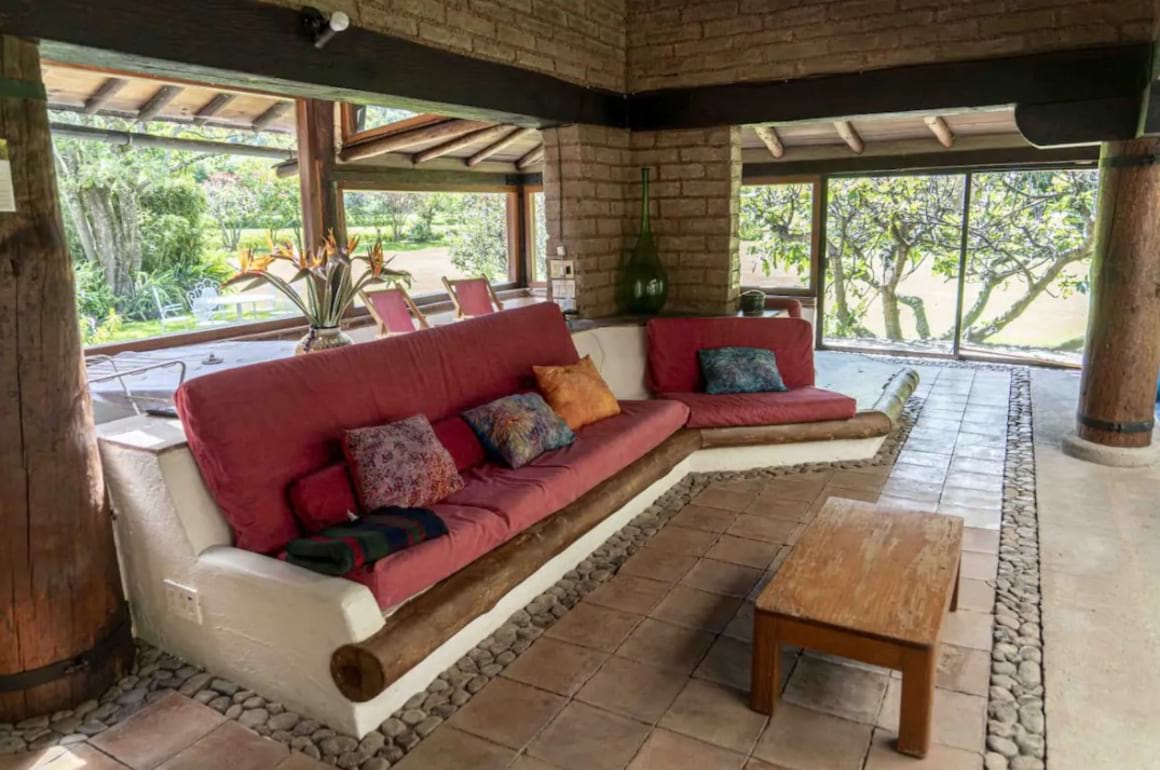
Imagine having your own private eco ranch in Mexico for an unforgettable vacation! This eco-friendly retreat is perfect for groups, families, or couples who want a special and private place to relax and reconnect with nature.
You’ll be surrounded by rolling green hills with views of mountains and rivers, plus a traditional Mexican ranch all to yourself. The space is well equipped with modern amenities like a grill, solar heating for the pool, and large comfortable living and dining spaces.
15. Most Traditional Eco Hostel in Mexico – Cenote Encantado
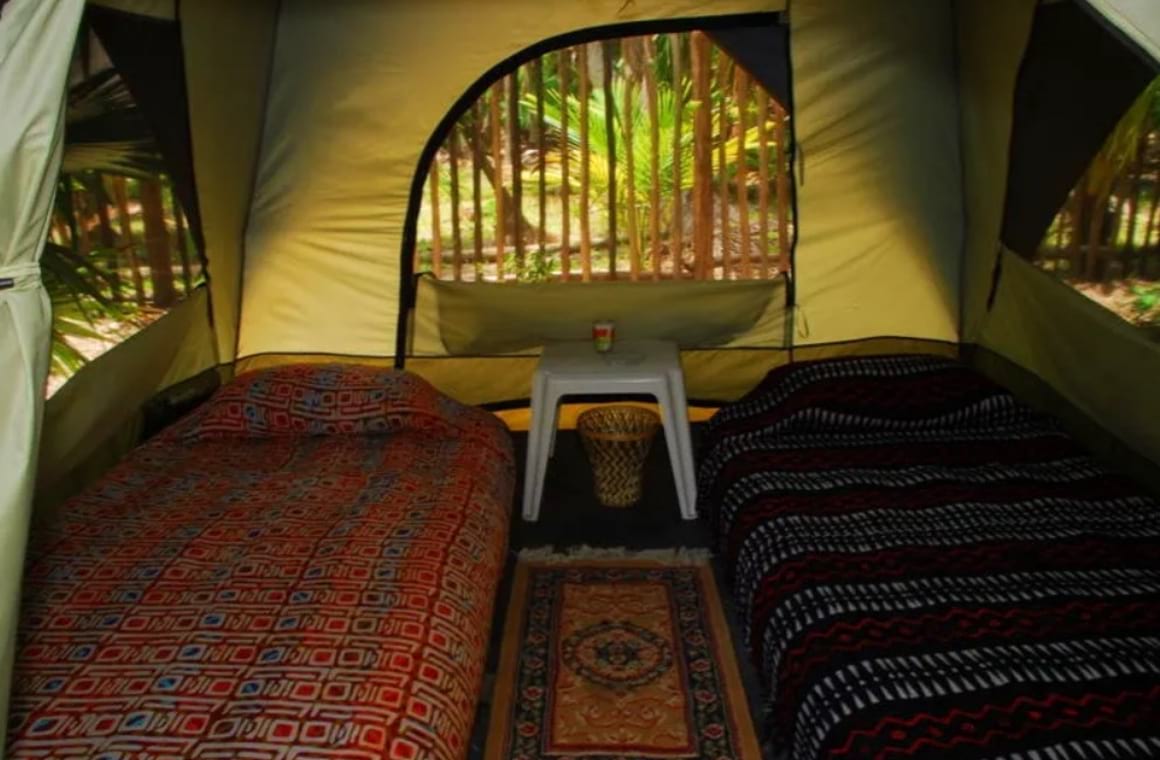
This eco hostel is a great spot for adventurers and people looking for a more holistic retreat experience. Located in a popular eco-tourist location, this hostel in Tulum features camping-style accommodation with a shared kitchen. You’ll also have opportunities to take yoga classes and learn about permaculture.
You can take part in fun adventure sports like swimming, snorkelling , boating, and hiking thanks to the 100+ cenotes (aka sinkholes) located close to the property. The hostel has kayaks and snorkelling gear available for rent, and there’s also a Temazcal steam bath onsite.
Here’s what people usually ask us when they look for vacation homes in Mexico.
What is the overall best eco resort in Mexico?
We would highly recommend staying at The House in the Woods during your stay in Mexico. It’s one of the absolute best eco resorts in the country!
What is the coolest eco resort in Mexico?
The Cocolia Hotel, Mazunte is by far one of the coolest eco resort in Mexico. Enjoy a breathtaking view that you won’t get anywhere else!
Are there any eco-friendly beachfront resorts in Mexico?
Four Seasons Crocodile Bar and Cabañas is located right by the beach. You’ll feel the sand under your feet as soon as you step out of the door!
Where can I book the best eco resorts in Mexico?
You can find the absolute best eco resorts in Mexico on Airbnb . If you’re not happy with the options, check out booking.com !
What’s the best eco-resort in Cancun, Mexico?
The best eco-resorts in Cancun are either in the hotel zone or out in the sticks. Sandos Caracol is a great option in my opinion. It is especially great if you are traveling with little ones too.
Don’t Forget Your Mexico Travel Insurance
ALWAYS sort out your backpacker insurance before your trip. There’s plenty to choose from in that department, but a good place to start is Safety Wing .
They offer month-to-month payments, no lock-in contracts, and require absolutely no itineraries: that’s the exact kind of insurance long-term travellers and digital nomads need.

SafetyWing is cheap, easy, and admin-free: just sign up lickety-split so you can get back to it!
Click the button below to learn more about SafetyWing’s setup or read our insider review for the full tasty scoop.
Whether you’re interested in historic ruins or simply looking for a spot to relax on the beach, Mexico offers the dream vacation destination for many travellers. Instead of booking into your regular Mexican backpackers, try out an eco resort! It’s the perfect opportunity to turn your trip into a more unique and sustainable experience.
Remember that these places that truly care about their natural landscape and environmental sustainability will give you 100% transparency. They LOVE questions about their eco friendly practices and impact.
Yes, green washing is becoming more of a problem with eco tourism. So please, do your research: many places do truly just want to take your money and don’t really care about the environment.
But you people care for the world are making a difference. Eco-tourism is an important tool to changing the world for better.
Hopefully, after reading through this list of the best eco hotels and eco hostels in Mexico you’ll have found a spot that’s perfect for you. From luxury travel to simple and rustic accommodation, there’s a lot of variation so everyone can find something to fit their preferences and budget.
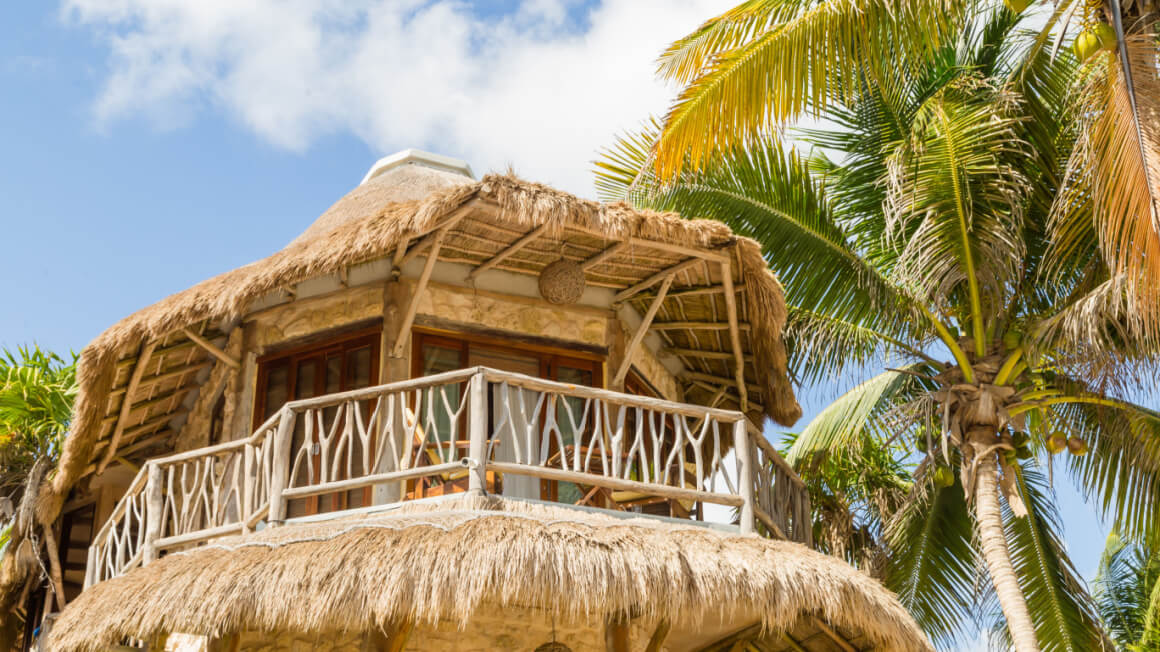
Made it this far? You get 15% OFF to book a place to stay ! Offer valid exclusively for Broke Backpackers 😉

Claire Martin
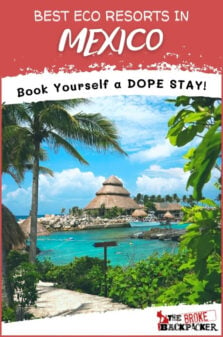
Share or save this post

Leave a Reply Cancel reply
Your email address will not be published. Required fields are marked *
Save my name, email, and website in this browser for the next time I comment.
Notify me of followup comments via e-mail.

Travel Guide
- Things to Do
- Entry Requirements & Customs
- Getting Around
- Visitor Information
- Tips on Accommodations
- Tips on Dining
- Special-Interest Vacations
- Calendar of Events
- Staying Healthy
- Getting There
- Staying Safe
- Sustainable Travel & Ecotourism
- Tips for Families
- Tips for Gay and Lesbian Travelers
- Tips for Senior Travelers
- Tips for Student Travelers
- Tips for Travelers with Disabilities
- Tips for Women Travelers
- Staying Connected
- Suggested Itineraries
Sustainable Travel & Ecotourism in Mexico
Mexico's ecological diversity is among the broadest of any country in the world, with an abundance of ecosystems ranging from the northern deserts to the central conifer forests, and the southern tropical rainforests. Mexico also supports 111 million people and welcomes more than 20 million visitors each year. Tourism is one of the country's biggest and most lucrative industries, and while tourism has brought jobs and growth to much of Mexico, it has also created and even accelerated many of Mexico's ecological problems. Cancún might be the highest-profile example: Rapidly developed from a rural outpost to an international resort destination, Cancún imported turf from Florida for its golf courses, inadvertently introducing a disease that wiped out the local coconut palms. The region's mangroves, a key habitat for native species and vital to protecting the land from hurricanes and erosion, have also suffered.
However, tourism has also encouraged development of ecological conservation. Mexico is home to seven of the world's eight species of sea turtle, though the entire turtle population was decimated on both coasts as a result of tourism growth and local overfishing. Recent success stories such as Puerto Escondido, in Oaxaca, where sea turtles are now protected by the locals, or the Riviera Maya, in the Yucatán, where marine biologists are working with hotels to guard nesting turtles and their eggs, have demonstrated the benefits of linking tourism with local knowledge.
Mexico's people are proud of their land and culture, and through your travels, especially in rural areas, you will likely encounter ejidos and cooperativos, or local cooperatives, that offer small-scale tourism services -- this may be as simple as taking visitors on a boat ride through a lake or as visible as controlling access to archaeological ruins. Ejidos will also run tours to popular ecotourism destinations similar to those offered by large travel agencies. When you deal with ejidos, everyone you encounter will be from the community and you know that your money goes directly back to them. States with a strong network of cooperatives include Chiapas, Oaxaca, Quintana Roo, and Yucatán.
The Mexican Caribbean supports the Great Mesoamerican Barrier Reef, the second-largest reef in the world, which extends down to Honduras. This reef and other marine ecosystems face increasing pressure from sedimentation, pollution, overfishing, and exploitative recreational activities, all newly associated with growing regional tourism. The Coral Reef Alliance ( CORAL; www.coral.org) is an example of an organization that, by teaming up with the World Wildlife Fund ( WWF; www.wwf.org) and United Nations Environmental Programme ( UNEP; www.unep.org), has been working to address threats to the Mesoamerican Barrier Reef and improve environmental sustainability throughout the region. CORAL partners with Mexican Amigos de Sian Ka'an, Conservation International, and the Cozumel Reefs National Park in an effort to build sustainability into mass tourism (such as cruise ships and hotels). CORAL assists marine tourism operators in implementing a voluntary code of conduct for best environmental practices. CORAL is soon to spread its influence to the Yum Balam region of the Yucatán Peninsula, where guidelines for whale shark interactions are greatly needed.
Biodegradable Sunscreen -- Recent scientific studies have shown that the chemicals in commercial sunscreen can do long-term damage to coral reefs, collect in fresh water, and even build up in your own body system. The Riviera Maya, Mexico's Caribbean Coast, receives more than 2.5 million visitors every year, many of them drawn to its rare marine environment -- a unique combination of freshwater cenotes and the world's second-largest coral reef. A few ounces of sunscreen multiplied by 2.5 million is equal to a substantial amount of harmful chemicals suspended in the ocean and fresh water. That's why tours to the Sian Ka'an Biosphere Reserve and water parks Xcaret and Xel-Ha ask that you use only biodegradable sunscreen or wear none at all when swimming in their ocean or cenotes.
The label of a biodegradable sunscreen should state that it is 100% biodegradable (and only 100% will do). You can buy it at the parks, but you'll get a better price from local markets. If you're curious, you can obtain a list of banned chemicals by contacting the parks directly. Buy a supply of biodegradable formula before you go from www.mexitan.com or www.caribbean-sol.com .
Animal-Rights Issues
Bullfights -- Bullfighting is considered an important part of Latin culture, but before you attend a correo, you should know that in all likelihood the bulls (at least four) will ultimately be killed in a gory show. That said, a bullfight is a portal into understanding Mexico's Spanish colonial past, and traditional machismo is on full display. Bullfights take place in towns as different as Tijuana and Puerto Vallarta, and they afford a colorful spectacle like no other, with a brass band playing; the costumed matador's macho stare; men shaking their heads at less-than-perfect swipes of the cape; and overly made-up, bloodthirsty women chanting "Ole," waving their white hankies, and throwing roses, jackets, and hats at the matador's feet. There is also the extremely minuscule chance that if the bull puts up a good enough fight or pierces his horn through the matador's leg, he will be spared for breeding purposes. It does happen, if only rarely. To read more about the implications of attending bullfights, see the website of People for the Ethical Treatment of Animals (PETA) at www.peta.org.
Swimming with Dolphins -- The capture of wild dolphins was outlawed in Mexico in 2002. The only dolphins added to the country's dolphin swim programs since then were born in captivity. This law may have eased concerns about the death and implications of capturing wild dolphins, but the controversy is not over. Local organizations have been known to staple notes to Dolphin Discovery ads in magazines distributed in Cancún hotels. Marine biologists who run the dolphin swim programs say the mammals are thriving and that the programs provide a forum for research, conservation, education, and rescue operations. Animal rights advocates maintain that keeping these intelligent mammals in captivity is nothing more than exploitation. Their argument is that these private dolphin programs don't qualify as "public display" under the Marine Mammal Protection Act because the entry fees bar most of the public from participating.
Visit the website of the Whale and Dolphin Conservation Society at www.wdcs.org or the American Cetacean Society, www.acsonline.org, for further discussion on the topic.
Note : This information was accurate when it was published, but can change without notice. Please be sure to confirm all rates and details directly with the companies in question before planning your trip.

- All Regions
- Australia & South Pacific
- Caribbean & Atlantic
- Central & South America
- Middle East & Africa
- North America
- Washington, D.C.
- San Francisco
- New York City
- Los Angeles
- Arts & Culture
- Beach & Water Sports
- Local Experiences
- Food & Drink
- Outdoor & Adventure
- National Parks
- Winter Sports
- Travelers with Disabilities
- Family & Kids
- All Slideshows
- Hotel Deals
- Car Rentals
- Flight Alerts
- Credit Cards & Loyalty Points
- Cruise News
- Entry Requirements & Customs
- Car, Bus, Rail News
- Money & Fees
- Health, Insurance, Security
- Packing & Luggage
- -Arthur Frommer Online
- -Passportable
- Road Trip Guides
- Alaska Made Easy
- Great Vacation Ideas in the U.S.A.
- Best of the Caribbean
- Best of Mexico
- Cruise Inspiration
- Best Places to Go 2024
https://mexicodude.com/
mexico traveling
Exploring Mexico’s Ecotourism: Sustainable Adventures in Nature
Imagine immersing yourself in the vibrant wildlife of Mexico, surrounded by lush forests, crystal-clear cenotes, and breathtaking landscapes. Mexico’s ecotourism offers the perfect escape for adventure enthusiasts and nature lovers alike. From exploring ancient Mayan ruins to hiking through stunning national parks, this article will take you on a journey through the sustainable adventures and natural wonders that Mexico has to offer. Get ready to embark on an unforgettable exploration of Mexico’s eco-friendly destinations, where preserving nature is paramount.
Table of Contents
Overview of Mexico’s Ecotourism
Mexico’s ecotourism industry is thriving, offering travelers the opportunity to explore the country’s diverse and stunning natural landscapes while prioritizing sustainability and environmental conservation. Ecotourism, at its core, involves responsible travel to natural areas that conserves the environment, sustains the well-being of local communities, and educates visitors about the importance of protecting the natural world.
Importance of Ecotourism in Mexico
In Mexico, ecotourism plays a vital role in supporting the country’s economy, preserving its natural resources, and promoting cultural heritage. The country’s breathtaking landscapes, rich biodiversity, and vibrant indigenous cultures make it an ideal destination for eco-conscious travelers seeking both adventure and a deeper connection with nature.

Popular Ecotourism Destinations in Mexico
Mexico boasts numerous popular ecotourism destinations that offer a wide range of experiences for nature enthusiasts. From the stunning beaches of the Yucatan Peninsula to the lush rainforests of the Mayan jungle and the rugged mountains of the Sierra Madre, there is something for everyone in Mexico’s diverse ecotourism offerings.
Benefits of Ecotourism in Mexico
Advantages of ecotourism for local communities.
One of the significant benefits of ecotourism in Mexico is its positive impact on local communities. By engaging in sustainable tourism practices, eco-tour operators ensure that local residents benefit economically from the industry. Ecotourism provides job opportunities, supports local businesses, and helps preserve traditional cultures and ways of life.
Environmental Benefits of Ecotourism
Ecotourism in Mexico also plays a crucial role in environmental conservation. By visiting protected areas and national parks, tourists contribute to their preservation through entrance fees and donations. Additionally, eco-tour operators follow strict guidelines to minimize their impact on natural ecosystems, reducing pollution, conserving water and energy, and promoting the sustainable use of resources.
Economic Benefits of Ecotourism
Moreover, ecotourism has significant economic benefits for Mexico. It generates revenue through entrance fees, accommodations, and local purchases made by tourists, contributing to the country’s overall economy. This revenue can then be reinvested in conservation efforts, infrastructure development, and community projects, further supporting sustainable growth.

Sustainable Practices in Mexican Ecotourism
To ensure the long-term viability of ecotourism in Mexico, various sustainable practices are implemented throughout the industry.
Conservation Efforts in Ecotourism
Conservation efforts are integral to Mexican ecotourism. Eco-tour operators collaborate with local organizations and authorities to protect endangered species, restore ecosystems, and preserve natural habitats. These efforts not only benefit the environment but also provide visitors with the opportunity to witness firsthand the importance of conservation.
Promotion of Responsible Travel Practices
Another aspect of sustainable ecotourism in Mexico is the promotion of responsible travel practices. Tourists are encouraged to minimize their impact on the environment by practicing the principles of “leave no trace,” such as properly disposing of waste, respecting wildlife and local communities, and supporting environmentally-friendly businesses.
Educational Programs for Visitors
Educational programs for visitors are also essential in Mexican ecotourism. These programs aim to raise awareness about the fragility of ecosystems, the importance of biodiversity, and the cultural significance of Mexico’s natural and indigenous heritage. By educating tourists, local communities, and future generations, ecotourism contributes to the long-term preservation of Mexico’s natural wonders.
Diverse Ecosystems and Wildlife in Mexico
Mexico is known for its unparalleled biodiversity and boasts a vast array of ecosystems that are home to unique and endangered species.
Biodiversity in Mexico
With its diverse geography and climate, Mexico hosts an astonishing range of plant and animal species. From the vibrant coral reefs of the Mexican Caribbean to the arid deserts of Baja California, the country’s ecosystems harbor an estimated 10-12% of the world’s biodiversity, making it a paradise for nature enthusiasts.
Protected Areas and National Parks
To safeguard Mexico’s natural landscapes, the country has established numerous protected areas and national parks. These include biosphere reserves, wildlife refuges, and natural monuments. Visitors can explore these protected areas while adhering to responsible tourism practices, ensuring the preservation of fragile ecosystems for future generations.
Unique Species in Mexican Ecosystems
Mexico’s ecosystems are home to many unique species found nowhere else on the planet. From the iconic monarch butterflies in Michoacán to the elusive jaguars in the Yucatan Peninsula and the colorful quetzals in the cloud forests of Chiapas, spotting these rare creatures in their natural habitats is an unforgettable experience offered by Mexican ecotourism.
Adventure Activities in Mexico’s Ecotourism
Mexico offers a plethora of adventure activities for thrill-seekers looking to immerse themselves in nature.
Hiking and Trekking
With its diverse landscapes, Mexico offers countless opportunities for hiking and trekking. From ascending volcanoes like Popocatepetl and Iztaccihuatl to exploring ancient trails such as the Camino Real de Tierra Adentro, hikers can enjoy breathtaking views and connect with nature while engaging in responsible hiking practices.
Snorkeling and Diving
Mexico’s coastal regions provide exceptional snorkeling and diving experiences. The clear waters of the Riviera Maya and the Sea of Cortez are renowned for their vibrant coral reefs, teeming with colorful fish and other marine creatures. Snorkeling and diving enthusiasts can witness firsthand the importance of preserving these fragile ecosystems.
Wildlife Spotting and Bird-Watching
For wildlife enthusiasts and bird watchers, Mexico is an ideal destination. From the gray whales in Baja California to the incredible diversity of bird species in the Yucatan Peninsula, observing wildlife in their natural habitats is a common activity in Mexican ecotourism. Responsible wildlife spotting practices ensure minimal disturbance to the animals and their ecosystems.
Exploring Mexico’s Coastal Ecotourism
Mexico’s stunning coastlines offer unique opportunities for coastal ecotourism, focusing on preserving pristine beaches and protecting marine life.
Beach Conservation and Turtle Sanctuaries
Mexico is renowned for its pristine beaches, which serve as nesting sites for endangered sea turtles. Eco-tour operators collaborate with local communities to protect nesting grounds and educate visitors about the importance of conserving these habitats. By participating in beach clean-ups and supporting turtle sanctuaries, tourists can directly contribute to the preservation of Mexico’s coastal ecosystems.
Marine Biodiversity and Conservation
Mexico’s coastal waters are teeming with marine biodiversity, including colorful coral reefs, exotic fish, and majestic marine mammals. Visitors can witness the wonders of the underwater world through responsible snorkeling, diving, and boat tours that adhere to sustainable practices, such as avoiding damaging coral and respecting marine life.
Water Sports and Eco-Friendly Practices
Mexico’s coastal regions also offer a variety of water sports, such as kayaking, paddleboarding, and surfing. Eco-friendly practices, like using biodegradable sunscreen and avoiding single-use plastics, are encouraged to minimize the environmental impact of these activities. By enjoying water sports in an environmentally-conscious manner, visitors can help preserve Mexico’s coastal ecosystems.
Discovering Mexico’s Rainforest Ecotourism
Mexico’s rainforests, particularly the Mayan jungle, provide a unique opportunity for travelers to experience the wilderness and learn about ancient cultures.
Exploring the Mayan Jungle
The Mayan jungle is a captivating destination for eco-tourists. Guided tours lead visitors through dense vegetation, ancient ruins, and mystical cenotes, allowing them to discover the secrets of the Mayan civilization while immersing themselves in the lush biodiversity of the rainforest.
Canopy Tours and Zip-lining
Canopy tours and zip-lining have become popular activities in Mexico’s rainforests. These adrenaline-pumping adventures offer a unique perspective of the dense canopy, allowing visitors to soar through the treetops while enjoying breathtaking views. Operators ensure safety while practicing sustainable techniques, such as using eco-friendly materials for platforms and harnesses.
Sustainable Practices in the Rainforest
The conservation of the rainforest and its biodiversity is a primary focus of ecotourism in Mexico. Eco-tour operators work closely with local communities to implement sustainable practices, like reforestation projects, wildlife monitoring, and the development of eco-friendly accommodations. By engaging in these practices, ecotourists contribute directly to the preservation of the rainforest ecosystem.
Mexico’s Mountainous Ecotourism
Mexico’s mountainous regions, particularly the Sierra Madre, offer a different kind of adventure for nature lovers, combining rugged landscapes with cultural immersion.
Sierra Madre Mountain Range
The Sierra Madre mountain range spans across Mexico, offering breathtaking vistas, cascading waterfalls, and remote indigenous communities. Trekking through the mountains allows visitors to admire the diverse flora and fauna while learning about the traditions and way of life of the indigenous peoples who call these mountains home.
Horseback Riding and Mountain Biking
Horseback riding and mountain biking are popular activities in Mexico’s mountainous regions. These activities allow visitors to explore the stunning landscapes and immerse themselves in nature while engaging in low-impact transportation methods. By choosing these eco-friendly alternatives, tourists can minimize their carbon footprint and support local guides and communities.
Conservation Projects in the Mountains
Conservation projects in Mexico’s mountainous regions aim to protect fragile ecosystems and promote sustainable development. Initiatives include reforestation efforts, wildlife conservation programs, and the establishment of community-led nature reserves. Engaging in mountainous ecotourism activities supports these projects and ensures the preservation of Mexico’s stunning mountain landscapes.
Cultural Immersion in Mexican Ecotourism
Mexican ecotourism not only focuses on natural exploration but also offers opportunities for cultural immersion and the preservation of indigenous traditions.
Indigenous Communities and Sustainable Tourism
Mexico is home to numerous indigenous communities, each with its unique culture, traditions, and knowledge of the land. Sustainable tourism initiatives prioritize working directly with these communities, ensuring that tourism benefits them economically and aids in the preservation of their cultural heritage.
Traditional Crafts and Cultural Experiences
Travelers engaging in Mexican ecotourism can participate in cultural experiences that showcase traditional crafts, such as pottery, weaving, and traditional cooking. By supporting these artisans and learning about their crafts, visitors contribute to the preservation of cultural traditions while gaining a deeper understanding of Mexico’s diverse heritage.
Celebrating Local Festivals and Traditions
Visiting Mexico during local festivals and celebrations offers a truly immersive cultural experience. From the Day of the Dead festivities in Oaxaca to the colorful Guelaguetza festival in the indigenous communities of southern Mexico, these celebrations provide a glimpse into the rich tapestry of Mexican culture and its close connection to nature.
Challenges and Future of Mexican Ecotourism
While Mexican ecotourism has seen significant growth and success, it also faces challenges that must be addressed to ensure its long-term sustainability.
Overtourism and Its Impacts
Popular ecotourism destinations in Mexico, such as the Riviera Maya and Cancun, have experienced issues related to overtourism. The influx of tourists can put a strain on local resources, cause damage to fragile ecosystems, and impact the quality of life for local communities. Balancing tourism numbers with the carrying capacity of each destination is crucial to mitigate these negative impacts.
Balancing Tourism and Conservation
Another challenge is finding the delicate balance between tourism development and conservation efforts. Proper planning, regulation, and responsible tourism practices are necessary to preserve the natural landscapes and biodiversity of Mexico while still allowing visitors to experience and appreciate these natural wonders.
New Initiatives and the Future of Ecotourism
To address these challenges, new initiatives and strategies are being implemented. Sustainable tourism certifications and guidelines are being developed to ensure that operators adhere to responsible practices. Additionally, greater emphasis is being placed on education and awareness campaigns to empower tourists to make informed choices and engage in sustainable ecotourism practices.
As Mexico’s ecotourism industry continues to evolve, it is essential to prioritize the preservation of the country’s stunning natural landscapes, protect its unique biodiversity, and support the well-being of local communities. By embracing sustainable practices and promoting responsible travel, Mexico can create a future where ecotourism thrives while conserving its natural treasures for generations to come.
By erez1333
erez1333 is the talented author behind MexicoDude.com, your go-to source for all things Mexico traveling. With a mission to uncover the hidden gems and vibrant culture of this diverse country, MexicoDude.com goes beyond the typical tourist attractions. From comprehensive city guides to thrilling adventure experiences, you'll find it all here. Dive into Mexico's rich history and delectable cuisine, and discover sustainable travel practices for an eco-friendly journey. Need travel tips? Look no further. Join the MexicoDude.com community to connect with other enthusiasts and share your stories. Let MexicoDude.com be your trusted guide to the enchanting world of Mexico.
Related Post
The history of lifesaving services on mexico’s beaches, a guide to the best beachfront cocktail bars in mexico, how to stay connected: wi-fi and tech on mexico’s beaches, what time zone is puerto vallarta mexico in, how far is puerto vallarta to cancun, how long is the flight from seattle to puerto vallarta, how far is mazatlan from puerto vallarta.
Mexico Travel: Expert Tips on Sustainable Tourism
Sustainable tourism is a hot topic, with the travel pause enforced on us by the coronavirus pandemic giving us the opportunity to reflect on our lifestyles.
(Ray in Manila via Flickr / CC BY 2.0)
While no one is saying we shouldn’t travel, it’s a good time to promise ourselves that we might travel more thoughtfully. Sustainable tourism is sometimes referred to as ‘green’ tourism as it aims to reduce any negative impacts on the environment. But in fact, sustainability also extends to people, protecting their culture and way of life while enabling them to make a decent living. So what can you do to travel more sustainably? Here are our expert tips for becoming a more responsible tourist.
Embrace Slow Travel
If you can, take fewer vacations – but stay longer. Maximising your time in a destination but minimizing the environmental impact of getting there makes sense. Fortunately, many of Mexico’s most popular regions for tourists lend themselves to slow travel: when it comes to attractions, there’s ample variety and plenty to do. Visit the Mayan Riviera, for instance, and you’ll have time to venture inland from its beautiful resorts to charming but relatively overlooked towns such as Valladolid or Merida. With more time, you can explore endless hidden ruins, discover remote beaches and swim in the cooling waters of the area’s many cenotes.
Head off the beaten track
It’s also a good idea to avoid tourist hotspots – and you’ll soon find that dodging the crowds makes for a much more rewarding travel experience. For instance, you could switch up popular archaeological sites like Chichen Itza and Tulum for the less visited but equally fascinating Coba and Ek Balam. Alternatively, head inland. Consider ditching headliners Mexico City and San Miguel Allende in exchange for the chance to get acquainted with under the radar places such as Taxco and Guanajuato. Support locally-owned businesses and restaurants to be sure that you’re doing your bit for the economy.
Travel out of season
People need to make a living from tourism, but when a year’s visitors are crammed into a few months, the rest of the 12 months can be tough. By traveling out of season, you can help by spreading out income from tourism. In what’s known as the ‘shoulder seasons’, the weather can be just as warm, dry, and sunny, but prices typically represent better value for money, meaning there’s a financial reward for your thoughtfulness too.
Rent a hybrid or electric vehicle
To get the most out of your vacation, it’s likely that you’ll want to travel around. After all, what’s the point of visiting a place as colorful and exciting as Mexico if you’re just going to stay in your resort? If you do decide to explore, think about how to do so without causing unnecessary pollution. For short trips where it’s not practical to explore solely on foot, perhaps bicycle hire is an option. Consider taking the bus rather than relying on your own car. If you do choose to go down the private rental route, seek out a hybrid or electric vehicle where available.
Use sustainable sunscreen
One of the most important responsibilities we have as tourists is to ensure our travels don’t adversely impact the environment. Making a few simple changes can have positive consequences. For example, change your sun cream brand for one which won’t leave a harmful oily film in the water. Traditional formulas contain chemicals that aren’t good for marine life, but there are biodegradable alternatives on the market: look for active ingredients like titanium oxide and zinc oxide. At water parks such as Xcaret and Xel-ha, you can pick up the ocean and reef-safe sunscreen if you haven’t bought your own.
Give careful consideration to wildlife encounters before you book
Wildlife encounters can be some of the most memorable experiences we have while away. But it’s vital we do our research to ensure that the creatures we come into contact with aren’t affected by our actions. If you’re keen to swim with dolphins, for instance, think about steering clear of dolphinariums and aquariums. Instead try seeking out a wild pod off the coast of Baja California, where cetaceans are often spotted. The area’s great for whale watching too.
Minimize detergent and recycle paper
Most of us have stayed in hotels that offer not to change towels and bed linen every day, but it’s up to us to make sure we do so. Reusing towels might not seem a big deal, but if everyone does it, the impact is huge. Similarly, where possible, opt for paperless ticketing and do your research online rather than by asking for a leaflet. If you do end up with a collection of paper maps and flyers, see if you can recycle them or pass them on so that incoming visitors can reuse your cast-offs.
We hope you’ll agree that sustainable tourism practices are easier to adopt than you might have thought. Let’s all do our bit for the planet and try to be more considerate, greener tourists going forward.
Kaloyan Valentinov Danchev is the founder and president of a luxury travel firm, Fidelis Marketing Group . It is a business group that sells tourist facilities of the highest quality and tours to the best attractions of the locations in which we have a presence.
Latest Articles
- Where to Stay in Dubai: The Best Neighbourhoods August 30, 2024
- Editor Picks: Adults Only All Inclusive Resorts in Antigua August 30, 2024
- Where to Buy Sting Tickets – 2024 US Tour August 30, 2024
- 3 Fun Chicago Speedboat Tours August 30, 2024
- How to Get a Short or Long-Term Spanish Student Visa August 28, 2024
- Destinations
- Travel Guides


Sustainable and responsible travel in Mexico
)
Jo Williams
- Sustainable travel in Mexico
Sustainable tourism in Mexico is a natural fit. With vast landscapes, an abundance of wildlife, and a culture interlinked with nature, the country makes the perfect eco-friendly destination.
Snorkel on the Great Mesoamerican Barrier Reef, the second-largest reef in the world, trek through one of the 40 UNESCO-designated biosphere reserves, and spot seven of the world's eight species of sea turtle.
Tourism hasn’t had only positive impacts on Mexico’s landscapes. In places like Cancun and Quintana Roo, mass tourism has had many negative effects in the past including the introduction of invasive species, pollution and litter, and large-scale habitat loss.
But the government and tourism sector have switched focus in recent years to offer a more sustainable way to visit Mexico . It’s now more important than ever to ensure that tourist dollars are supporting the right projects and places for the future of eco-tourism in Mexico.
- Sustainable places to visit in Mexico
Yucatan Peninsula
Despite being a popular destination, there are many sustainable tourism options on the Yucatan Peninsula . Just off the coast of tourist haven Playa Del Carmen , the island of Cozumel is well known as one of the best places to dive in the world.
Visit the only active pearl farm in the Caribbean at Cozumel Pearl Farm . It’s constructed on stilts made from recycled telephone poles and is a family-owned project that cares for and gives back to the environment.
They have recently started coral reef gardening too, which has in turn encouraged an array of sea life. Enjoy a tour of the farm or go diving or snorkelling to find out more.
Puerto Morelos is one of Mexico’s “ Pueblos Magicos ” - towns and villages that are rich in Mexican legends, history, culture and/or natural wonders. It’s a great spot to get away from the tourist resorts of Quintana Roo, and spend some time watching the local stilt fisherman or explore the surrounding protected areas.
Another top eco-friendly tourist attraction in Quintana Roo is Aktun Chen, home to a cavernous underground cenote system with thousands of limestone stalactites. Set within a 400-acre preserve of virgin forest, the park is a Mexican-owned enterprise where 90% of the land is left for nature. You can also go zip-lining, explore the area on ATV tours, and explore part of the jungle by boardwalk.
Other eco-friendly places to visit in the Yucatan Peninsula include the Sian Ka’an Biosphere Reserve (the largest protected area in the Mexican Caribbean), Isla Holbox , and the stunning Bacalar Lagoon - often called the “Maldives of Mexico”.
Baja Peninsula
The Gulf of California is home to hundreds of islands, islets, and coastal areas that have earned it the nickname of the “Aquarium of the World.” See sea lions on Espiritu Santo Island, take a blue whale watching tour in Loreto, and swim with whale sharks in the waters surrounding the peninsula from October through to April.
If dry land is more your thing, the Sierra de la Laguna is a fantastic hiking destination in Mexico. It’s best known for its ancient woodlands, scrub and an abundance of endemic vegetation. Take a locally organised tour to learn more about conservation in the area.
The Calakmul Biosphere Reserve is the largest forest reserve in Mexico where you can explore Maya ruins surrounded by thick jungle. The gateway to the reserve is the small town of Xpujil, a 45-minute drive from the Calakmul Biosphere Reserve. Here you can support local communities by buying artisan wares like textiles, jewellery, and home decor, directly from the people that have made them.
Central Mexico
Places like Mexico City are rich in history and culture and a must when travelling in the country. From here, a 4-hour bus journey into the state of Michoacán will take you to the Monarch Butterfly Biosphere Reserve .
Visit these forests in the Western Central Highlands between December and February to see one of the most awe-inspiring natural spectacles on earth. Here bright orange butterflies arrive in their thousands as part of one of the largest migrations in the natural world. Some travel up to 3000 miles over the course of two months from the northern forests of Canada and America.
- Things to be aware of before visiting
Avoid sunscreen and insect repellent when swimming
There has unfortunately been a lot of damage to the coral reefs and delicate ecosystems - especially in touristy places like the Yucatan Peninsula. When swimming anywhere in the cenotes, the Sian Ka'an Biosphere Reserve, and even water parks like Xcaret and Xel-Ha, only use 100% biodegradable sunscreen or wear UV clothing - a zero-waste non-toxic alternative that lasts a lifetime.
Swimming with dolphins in captivity
Although the capture of wild dolphins was outlawed in Mexico in 2002, there is still much debate as to the fairness of keeping them caged for tourism purposes. Although all animals since that time were born in captivity, many locals and visitors argue that the practice is still cruel. There are plenty of opportunities to see and swim with marine life in the wild in a responsible way in Mexico.
Whale shark and boat tours
Many boat tours now focus on eco-friendly methods and put the animals' safety and comfort first. But it’s always best to do some research and choose reputable operators; many use greenwashing tactics like “no plastic” but still bait marine life to ensure encounters. The best time to see whale sharks in the Yucatan Peninsula and Riviera Maya is between the months of July and August.
Supporting local businesses and communities
Try to avoid foreign tour operators (where tourism money doesn’t reach the locals) and instead seek out ejidos and cooperativos (local cooperatives). These small-scale tourism services are run by the community and offer the same, if not better, tours to many of Mexico’s ecotourism destinations. They are available all over Mexico, but are especially easy to find in states like Chiapas, Oaxaca, Quintana Roo, and the Yucatán.
Sustainable accommodation in Mexico
On the marine-life-rich Isla Holbox , you might be lucky enough to see whale sharks, sea turtles, and bioluminescent plankton. It’s also home to a swathe of birdlife like flamingos and pelicans and is part of the impressive Yum Balam Nature Reserve.
Stay at Hotel Casa Blat Ha , a sustainable hotel that runs on wind power and serves up produce from its very own orchard and medicinal plant garden.
A little further south, relax in style at MIA Bacalar Luxury Resort & Spa at the foot of Bacalar Lagoon. The eco-friendly hotel recycles its water to use for irrigation, composts food waste and also grows its own locally sourced chemical-free produce.
Stay at a luxury eco-camp with Journey Mexico in Magdalena Bay on the Pacific coast of the Baja California Peninsula. Here you can participate in a world-renowned sea turtle research and conservation project.
They also offer volunteer experiences researching whale sharks, and in other areas like the Aztec city of Tenochtitlan and the Sierra de la Laguna Biosphere Reserve.
Planning a trip to Mexico? Read our travel guides
- Introduction
- Sustainable accommodation
Share this article
)
Author - Jo Williams
Jo Williams is a freelance writer with 10 years' experience working in travel and tourism. A Brit who got fed up with the 9 to 5 corporate life, she sold everything to become a full-time wanderer.
Jo has travelled to over 70 countries and worked throughout Europe for a major tour operator. She hopes to inspire you to work less and travel more.
Last Updated 9 February 2024

- Search Please fill out this field.
- Manage Your Subscription
- Give a Gift Subscription
- Newsletters
- Sweepstakes
- Destinations
How One Lagoon Is Becoming a Hub for Sustainable Tourism in Mexico
Three new boutique hotels are serving as templates for turning the town of Bacalar—and its iconic lake—into Mexico’s most responsible tourism destination.
Standing on a dock overlooking Lake Bacalar—nicknamed the Lagoon of Seven Colors—I finally understood why other travelers had told me this was the most beautiful place in Mexico. As I slipped into the crystalline fresh water, I noticed how it appeared to change from dark blue to lavender, depending on the depth of its limestone floor and the position of the sun.
Located in the state of Quintana Roo, just north of the Belize border, Bacalar hasn't yet drawn the attention (or overdevelopment) of popular destinations farther north in the state, such as Cancún , Playa del Carmen, or Tulum . But interest in the area is rising, thanks to the town's laid-back vibe—and the extraordinary colors of the 26-mile-long lagoon.
And while many in this community of about 40,000 people see the benefits of inviting more visitors, they're also fiercely protective of Bacalar's natural wonders. In addition to the lake, these include seven cenotes , the water-filled sinkholes for which the Yucatán is famous, and stromatolites, living fossils thought to be among the first forms of life on earth. Scientists say maintaining the lagoon's ecological balance is crucial to the organisms' continued existence.
Among those working to navigate these competing priorities are the eco-conscious hoteliers behind three new boutique properties. Mindful of the toll mass-market success has taken on other parts of Mexico, these hospitality pros are sourcing materials as locally as possible, employing staff from the region, and promoting soft-adventure activities that allow sustainability-minded travelers to connect with nature while minimizing their impact. This past September, I ventured to Bacalar from Mexico City to preview what's in store.
The Intimate Oasis
Stepping through the carved wooden doors of Casa Hormiga felt like stumbling into a temple garden. Operated by Sofia Lynch and José Maria Padilla, an Argentine-Mexican couple who moved to the area in 2009, the 18-room hotel hides a clutch of thatched-roof concrete buildings and two swimming pools among enormous palms and other endemic plants, like lush birds of paradise. At Casa Ritual, the hotel's on-site spa, therapies often incorporate regional customs and medicinal practices. My 2½-hour treatment began with a ceremonial cacao drink—a common tradition in the Yucatán—and ended with a rejuvenating herbal soak in water infused with basil, rosemary, lemongrass, and slices of grapefruit. The next day I bagged a spot at La Playita, a club on the lagoon that partners with Casa Hormiga. After my swim, the shaded restaurant patio was an ideal place to enjoy a plate of fish tacos and take in the spectacular view. Doubles from $396.
The Modern Retreat
On arrival at Habitas Bacalar , I was ushered into the open-air reception area for a short intention-setting meditation session. From there I followed a long gravel path lined with native gumbo-limbo trees to find the hotel's 35 A-frame cabins. While some face the lagoon and others the jungle, all of the accommodations have been built using the growing brand's signature low-impact modular construction to avoid any major modifications to the land. Siete, the on-site restaurant, features a mostly vegetarian menu with seasonal ingredients sourced from vendors in the Yucatán, while the wellness center specializes in Mayan-influenced treatments. It can also arrange activities including paddleboard yoga and aerial cross-training. Doubles from $400.
The High-Design Haven
Mexican starchitect Frida Escobedo has consistently garnered praise for using natural materials to create striking architectural projects, and her latest endeavor—the 22-room Boca de Agua , slated to open in October 2022—is already creating a buzz. Every detail of the hotel's design, including sapodilla wood certified by the Forest Stewardship Council and limestone sourced from only 31 miles away, has been chosen for its minimal environmental impact. And, as Mexico City–based cofounder Rodrigo Juárez told me, the hotel is also partnering with global nonprofit Saira Hospitality to offer professional hospitality training to the surrounding community to provide long-term, sustainable work opportunities. Rates not available at press time.
Related Articles

Sustainable Tourism Practices in Mexico: A 2023 Guide
I. introduction.
As the world becomes more environmentally conscious, sustainable tourism practices have gained significant importance. Travelers are increasingly looking for eco-friendly travel options that minimize their impact on the environment and support local communities. Mexico, with its diverse natural beauty and rich cultural heritage, has made significant strides in promoting sustainable tourism. From eco-certifications and government policies to sustainable accommodations and responsible tourism activities, Mexico offers a range of opportunities for travelers to engage in responsible travel. This article will explore the various aspects of sustainable tourism in Mexico, highlighting initiatives, accommodations, activities, and practices that contribute to a greener future.
II. Understanding Sustainable Tourism
Sustainable tourism can be defined as a form of tourism that focuses on minimizing negative impacts on the environment and promoting the well-being of local communities. The key principles of sustainable tourism include environmental protection, social and cultural preservation, and economic viability. By adopting these principles, destinations and businesses can ensure that tourism activities are carried out in a responsible and sustainable manner.
III. Sustainable Tourism Initiatives in Mexico
Mexico has shown a strong commitment to sustainable tourism with several initiatives in place. The government has implemented policies and regulations that promote sustainable practices in the tourism industry. Additionally, Mexico has introduced eco-certifications and accreditation programs that recognize and reward businesses for their efforts in sustainability. These initiatives play a crucial role in preserving the country’s natural resources and cultural heritage while providing economic benefits to local communities.
IV. Eco-Friendly Accommodations in Mexico
Many hotels and resorts in Mexico have embraced the concept of sustainability and offer eco-friendly accommodations. These establishments are designed and operated with a focus on minimizing their environmental impact. Sustainable hotels and resorts in Mexico incorporate features such as energy-efficient infrastructure, water conservation measures, waste reduction and recycling programs, and the use of renewable energy sources. Travelers have the opportunity to stay in beautiful and comfortable settings while knowing that their accommodation choice aligns with their values of responsible travel.
V. Responsible Tourism Activities in Mexico
Mexico offers a wide range of nature-based and eco-friendly activities for travelers looking to engage in responsible tourism. From exploring pristine national parks and protected areas to participating in wildlife conservation projects, there are numerous opportunities to experience Mexico’s natural beauty while supporting environmental initiatives. Sustainable tour companies in Mexico organize responsible travel experiences that prioritize environmental conservation, cultural preservation, and giving back to local communities.
VI. Sustainable Practices in the Mexican Hospitality Industry
The hospitality industry in Mexico has taken significant steps towards embracing sustainability. Many hotels and resorts have implemented initiatives to reduce their environmental impact. These include implementing energy-efficient practices, adopting sustainable waste management and recycling processes, and promoting water conservation measures. By incorporating sustainable practices, the Mexican hospitality industry aims to contribute to the preservation of natural resources and promote responsible tourism.
VII. Case Studies of Successful Sustainable Tourism Projects in Mexico
Several sustainable tourism initiatives in Mexico have shown remarkable success in terms of environmental conservation and community development. These projects range from community-based ecotourism initiatives to the restoration of natural habitats and cultural heritage sites. By examining these case studies, valuable lessons can be learned, and recommendations can be made for future sustainable tourism projects in Mexico.
VIII. Comparing Mexico’s Sustainable Tourism Practices with Other Destinations
Mexico is not alone in its efforts towards sustainable tourism. Many other popular destinations around the world have also embraced sustainability as a guiding principle. By comparing Mexico’s sustainable tourism practices with those of other destinations, opportunities for collaboration and inspiration can be identified. This cross-learning can contribute to the continuous improvement of sustainable tourism practices globally.
IX. How Businesses Can Incorporate Sustainable Tourism Practices in Mexico
For travel businesses in Mexico, incorporating sustainable tourism practices brings various benefits. These benefits include improving their brand image, attracting environmentally-conscious travelers, and contributing to the overall sustainability of the tourism industry. Steps to incorporate sustainable tourism initiatives include conducting a sustainability assessment, setting sustainability goals, implementing environmentally-friendly practices, and engaging with stakeholders. Examples of successful sustainable tourism programs by Mexican businesses will provide practical insights and inspiration for other enterprises.
X. Conclusion
Mexico has made significant progress in promoting sustainable tourism and offers numerous opportunities for travelers to engage in responsible and eco-friendly travel experiences. From sustainable accommodations to responsible tourism activities, Mexico provides a range of options for those who wish to minimize their environmental impact. By supporting sustainable tourism practices, travelers can contribute to the preservation of Mexico’s natural and cultural heritage while enjoying unforgettable experiences. It is essential to continue advocating for sustainable tourism, both in Mexico and around the world, to ensure a greener future for generations to come.
When visiting Mexico, don’t forget to consider experiencing the beauty of the country from a unique perspective – the sky! Book a helicopter tour in Mexico City and marvel at the iconic landmarks, historic sites, and breathtaking landscapes from the air. Whether it’s exploring the vibrant streets of Mexico City or flying over the ancient ruins of Teotihuacan, a helicopter tour offers a one-of-a-kind experience that combines adventure and luxury. Don’t miss out on this incredible opportunity to see Mexico like never before. Book your helicopter tour now!
Quick Links
Social media, © 2024 mexico helicopter tours.


Ecotourism in Mexico: 9 Sustainable Tours You’ll Love
By: Author Lora Pope
Posted on Published: November 29, 2022 - Last updated: July 7, 2023
This post may contain affiliate links. By clicking and making a purchase through the links, I earn a small commission at no extra cost to you. See my disclaimer for more information. This and display ads allow me to keep the site up to date and give back .
Want to fill your next trip to Mexico with tours and activities you can feel good about?
Ecotourism in Mexico is booming, and this list of socially responsible and sustainability-focused tour companies is the perfect place to start planning your trip.
Not only will you know that your money is supporting a plethora of good local causes and local families directly, but also that your travels will leave a positive footprint- something that hasn’t always been at the forefront of tourism in the past.
A Few Best Practices and Responsible Travel Tips
Before we look at some of the best responsible tours in Mexico, here are a few quick tips on how to be a more responsible traveler no matter where you go.
- Consider carbon offsetting your flight, or book with an airline that will carbon offset on your behalf
- Choose sustainable accommodation such as an eco-resort, or search for hotels with good sustainability initiatives such as plastic-free policies, recycling programs, low-energy appliances, etc.
- Consider animal welfare before booking tours/activities that involve animal interaction or entertainment
- Use reef-safe sunscreen
- Support local businesses over big chains
- Don’t take photos of locals without their expressed consent, and even then, only if you have established a connection with them. The locals are not scenery!
- Be respectful of local culture and customs.
- Search for tour companies with social/environmental impact initiatives (such as the ones on this list!)
- And last but certainly not least, take time to research how to travel more ethically.
Eco tours in Mexico
Eco colors tours.
What makes Eco Colors Tours a responsible choice?
- Small-group, limited travel to minimize the impact on natural areas
- Collaborations with WWF, SEMERNAT, Adventure Travel association, Ecotourism Society, and The Smithsonian School to create environmental protection plans
- Awareness campaigns about the ecosystems of Mexico and how to help rehabilitate them
A few of their best tours:
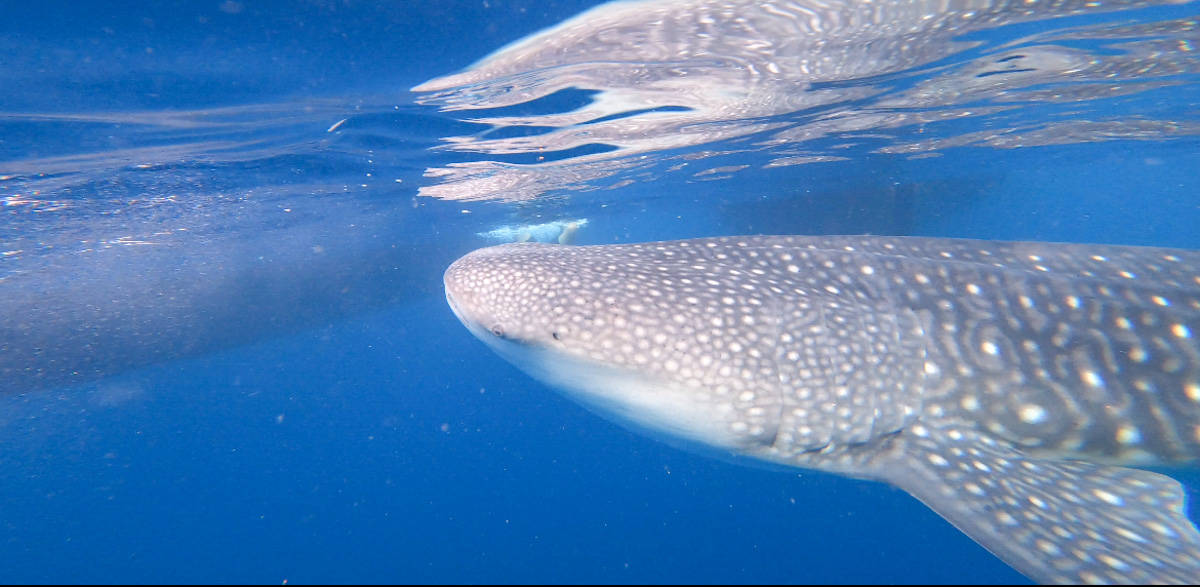
Whale Sharks Cancun Tour
- Length: 5-8 hours
- Cost: $165 pp.
I think we’ve all put snorkeling with the whale sharks tour on our travel bucket list for Mexico at one point or another, but when it comes to wild animal interactions and enjoying protected ecosystems, it’s of the utmost importance to choose an ethical tour company.
Thankfully, Eco Colors has one of the best whale shark tours around! Transportation, lunch, beverages, and snorkeling equipment are all included, and a percentage of your tour fee goes towards educational programs for children on the island of Isla Mujeres.
Temazcal Ceremony in Cancun
- Cost: $745 per couple.
This tour presents an opportunity to interact with the locals in a genuine and responsible way and participate in community-led cultural learning, but this day-long adventure also includes some quintessential Mexican experiences all under one tour umbrella.
You’ll learn about the construction of a traditional Mayan home, learn to make tortillas as they were made thousands of years ago, visit the circle of sea snails and enter a Temazcal with a local shaman.
At the end of the day, you’ll be treated to a visit to a secret cenote for a swim and a yummy gourmet dinner.
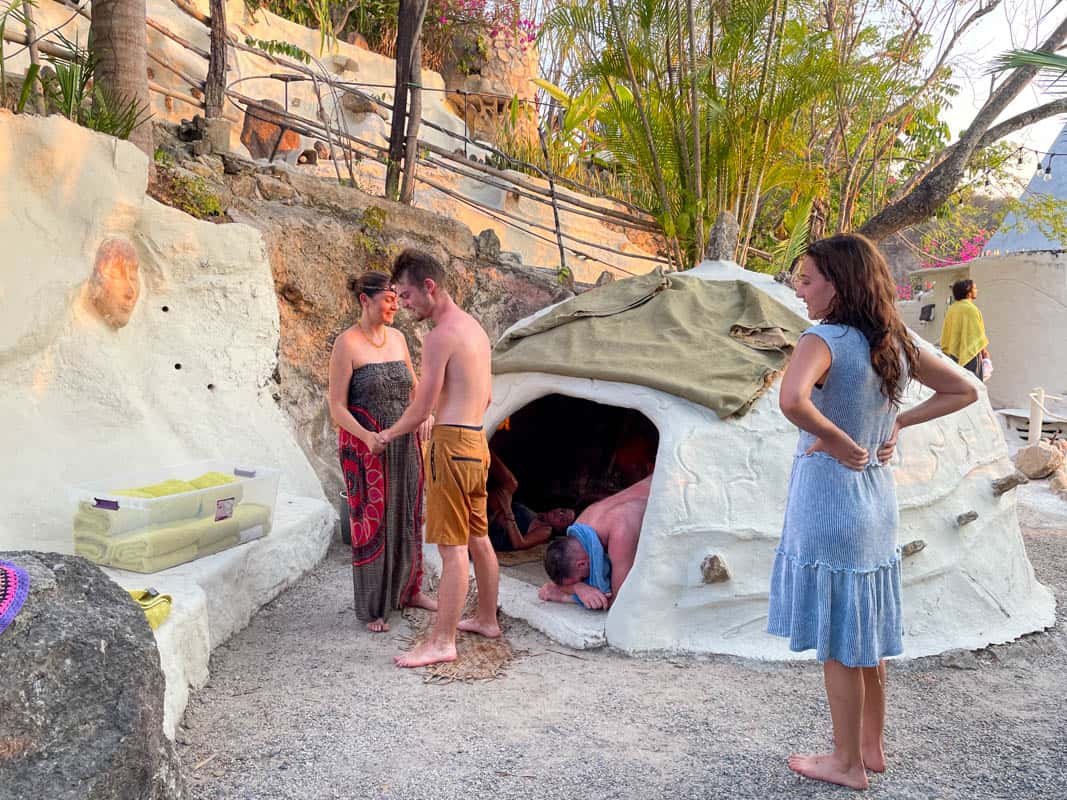
Univers Maya Yucatan
What makes Univers Maya Yucatan a responsible choice?
- “English for All” program supports free English language classes for local children
- Environmentally friendly approach to tourism
El Cielo and Cozumel
- Length: Half-day
- Cost: $70 pp.
Here’s an incredible aquatic destination in Mexico you may not have heard of yet. First, you’ll head to the oasis free-diving sites, Palancar and Columbia, at the Cozumel Reef Marine National Park.
This reserve still has a flourishing, colorful reef teeming with tropical species, but this is one of the least impressive stops of the day.
Next, you’ll head to El Cielo Reserve, which is a shallow diving site that’s home to thousands of giant starfish.
Finally, you’ll end your day with a visit to El Cielito, which is an ocean pool/sand bar known for being one of the best places to view rays.
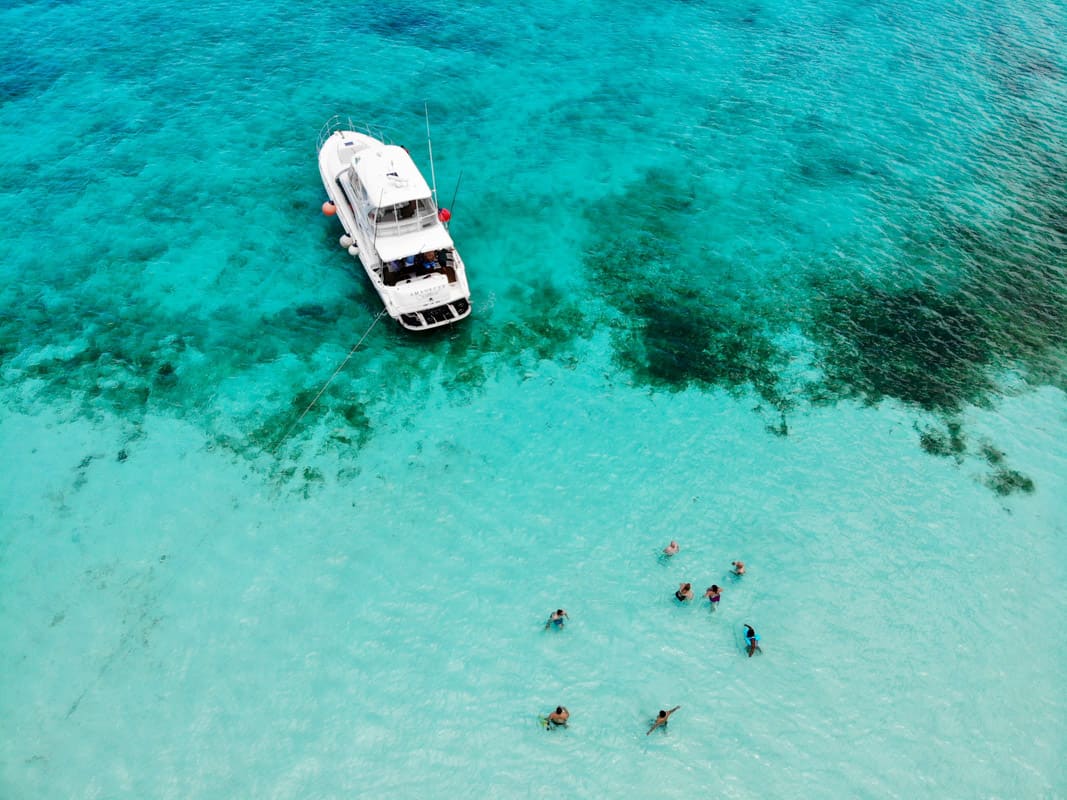
Sian Kaan Boat Safari
- Length: Full Day
- Cost: $160 pp.
Visit the infamous UNESCO Sian Kaan reserve with a company willing to go the extra mile. You’ll start off perusing the mangroves in search of manatees and crocodiles. Then, after a quick break for a buffet lunch, you’ll head out into the shallow seas for some dolphin and turtle watching.
Journey Mexico
What makes Journey Mexico a responsible choice?
- Works closely with local communities to support their businesses and encourage participation in cultural tourism in Mexico in a responsible way
- Financial contributions to several local environmental non-profits
- Works with the Global Sustainable Tourism Council to promote tourism as a catalyst for sustainable development.
Axolotls and Chinapas in Xochimilco
- Length: 6 hours
- Cost: Varies
My goodness, this is a Mexico City experience like nothing you’ve ever dreamed of. First thing in the morning, you’ll board a colorful gondola and cruise down the floating gardens of Xochimilco, birdwatching and learning all about the area’s unique history.
The best part of this tour? You’ll have the rare opportunity to learn about the conservation of the internet-famous Axolotls and potentially see one of these endangered beauties in their natural habitat. You’ll also be treated to a fabulous lunch made from produce grown right in the floating gardens.
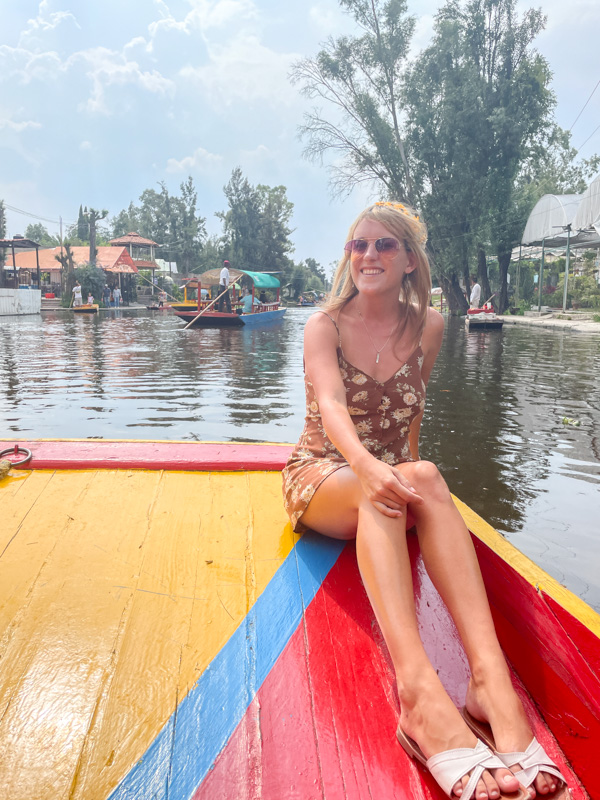
Hammocks Artisan’s Home Workshop in Tixkokob
Chances are, if you’ve been to Mexico before, you’ve seen the iconic hand-woven hammocks that grace the walls of every souvenir shop and thought about the possibility of bringing one home. This is actually one of the largest income generators for local artisans and families.
With this tour, you can learn the incredible techniques that go into creating these hammocks while visiting a family workshop, and if you’d like, you can even try your own hand at weaving!
Of course, in the end, you’ll have the option to bring home one of these masterpieces straight from the source and with an incredible travel story behind it.
Maya Ka’an
What makes Maya Ka’an a responsible choice?
- Certified under the Sustainability Requirements for Ecotourism in the municipality
- Strict adherence to biosphere reserve guidelines and additional sustainability efforts made to reduce waste and water consumption
- Works exclusively with local tour providers to keep profit within the community
Chewing Gum: A Mayan Legacy
- Length: —
Take an adventure through the Mayan jungle and visit a traditional chicle camp. Here, you’ll observe the ancient practice of extracting gum. If you’re lucky, you may even get to try some! Afterward, you’ll be treated to some refreshments and a boat tour around the Sian Kaan lagoon.
Kayaking in the Siijil Noh Ha Lagoon
On this tour, you’ll visit the criminally underrated Ejidal Reserve and spend the day enjoying the natural areas, both on dry land and in the water. You’ll have the opportunity to hike and search for wildlife, kayak the still lake, and hop on in for an afternoon swim. You’ll also be able to meander the onsite eco-museum and learn about the history and conservation needs in the area.
Rutopia
What makes Rutopia a responsible choice?
- United Nations and B-Corp sustainable business/social enterprise certified
- Contributions to local economic development programs and efforts to conserve local heritage sites
- Prohibits activities with captive animals or irresponsible volunteer projects with vulnerable communities
- NO commodification of culture-genuine interaction and learning with community partnerships only
- Anti-discrimination policy covering prejudice based on gender, sexual orientation, race, religion, cultural expression, or social class.
**All of Rutopia’s tours are fully customizable, multi-day itineraries developed to meet your needs by one of their travel experts. To learn more, visit their website here .
Banyan Tree Mayakoba
What makes Banyan Tree Mayakoba a responsible choice?
- Certified by Preferred by Nature, EarthCheck Gold, PROFEPA, and Distinctive S
- No single-use plastics allowed on-site or during excursions
- Local conservation initiatives including tree planting, beach cleanups, reef conservation, and sea turtle protection programs
- Community support including financial aid for education and small business startup training
- Duration: 2 hours
Especially great for couples, this fusion and local cuisine dinner cruise will take you down the canals and through the mangroves of the Mayakoba river on a traditional trajinera boat.
You can also opt to take this cruise at breakfast time to watch the sunrise, but the nighttime experience is so extraordinary that it’s the inspiration source of the name for this tour. “Ixchel” translates to the moon goddess.

What makes Vive Mar a responsible choice?
- Leader in the conservation of sea turtles and birds in Mexico
- Gives back to the community with environmental education
One of the most remarkable wildlife connections you can have is releasing baby sea turtles into the wild. With Vive Mar , you can partake in this experience in Puerto Escondido, one of Mexico’s most popular beach towns.
During the turtle nesting season, they invite visitors to come and partake in a sea turtle release. You’ll head out at sunset and release a turtle into the ocean, which instinctively know to go towards the sea. If you’re living in Mexico, you can also volunteer with them.
RED Travel Mexico
What makes RED Travel Mexico a responsible choice?
- Tourism for Tomorrow award, as well as recognition from National Geographic
- Partnership with
- Pioneers of Ecotourism in Mexico Oceanic Society Films to build awareness about ocean conservation efforts
The Original Gaspereno Mule Ride Adventure
- Duration: 6-8 hours
- Cost: $780 for 3 travelers, $145 per additional traveler (private tour)
Ever dreamed of living on a ranch or starring in a cowboy movie? Now’s your chance to make that dream a reality.
On this tour, you’ll take a 2-3 hour mule ride through the Sierra, looking over the deserts and the sea in the distance until you make your way to the Gaspereno Ranch. Once you’ve arrived, chef Ivan will prepare you a stunning farm-to-table meal.
Want to capture these memories forever? You can even add a private photographer o your experience or rent a go-pro so that you won’t have to miss a second, and you can relive this journey over and over.
Historical Mining Trail Hike
- Cost: $850 for 3 travelers, $140 per additional traveler (private tour)
Take a day-long guided hike through the gorgeous canyons of La Paz while learning about the local desert flora and the region’s rich mining history.
You’ll see the remnants of old mines, receive a personalized wood walking stick to take home with you, and chow down on a delicious chef-prepared lunch.
Wildlife Connections
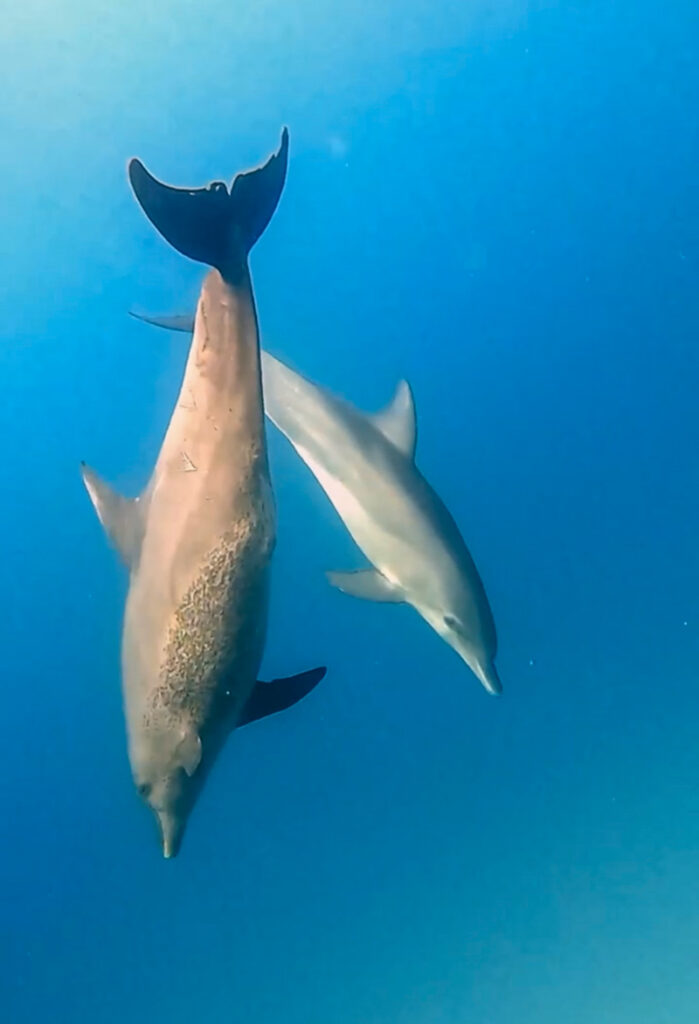
What makes wildlife connections a responsible choice?
- First company in Mexico to work with free wild dolphins
- Guides are professional biologists with master’s degrees in Marine Ecology
- Contribute to the research of marine conservation in Mexico
Swimming with free wild dolphins
There are many places in Puerto Vallarta that advertise swimming with dolphins, but as a responsible traveler, you should avoid supporting these.
Instead, try this tour with wildlife connections , where you’ll have the chance to swim with dolphins in the wild. You’ll head out on the boat with marine biologists who use a hydrophone to listen for dolphin communication.
Depending on their mood, you have a good chance of swimming with them! From December to March, you can also see humpback whales, giant mantas, marine turtles, and if you’re lucky – orcas!
Whale watching
Puerto Vallarta is one of the best places to go whale watching in Mexico! Every winter, thousands of humpback whales migrate to the Bay of Banderas.
While there are many whale-watching tours to choose from , the best ethical choice is with wildlife connections. You’ll be in the company of a biologist, participating in a research project that helps to protect them.
It’s great to see ecotourism in Mexico growing every year. I hope this post could inspire you to check out some of these eco tours in Mexico on your next trip!
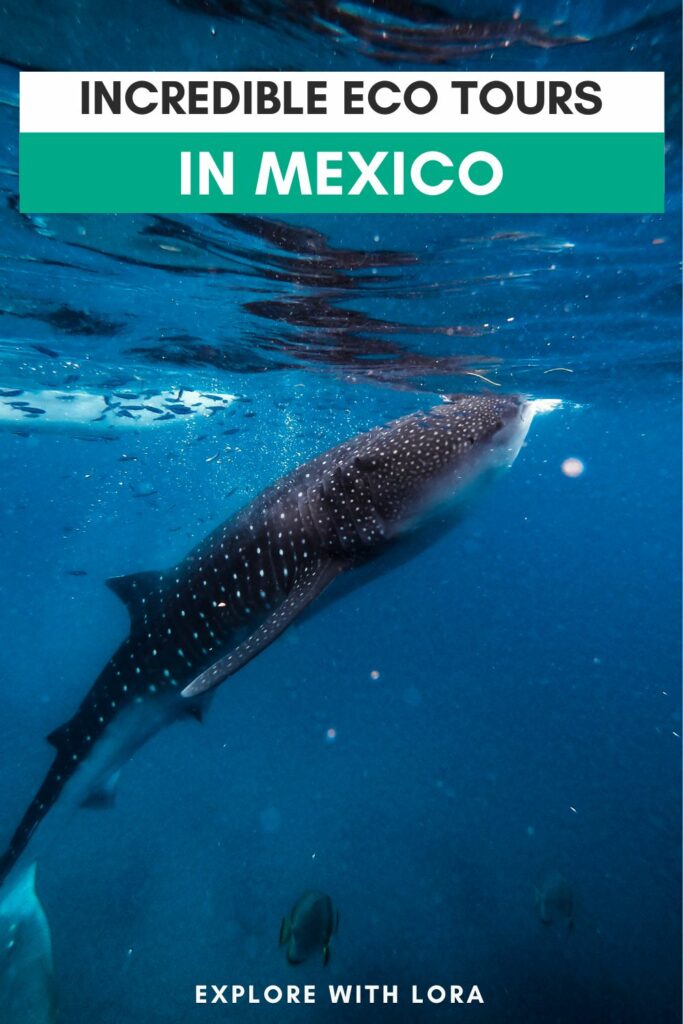
Lora is a full-time digital nomad on a quest to visit every country in the world and pet as many dogs as she can along the way. Over the last 15 years, she has traveled to 70+ countries and six continents solo. She currently calls Puerto Vallarta, Mexico home and enjoys ending each day with sunset and tacos on the beach.
Leave a comment Cancel reply
Your email address will not be published. Required fields are marked *
Mexico has long been a popular holiday spot for those seeking some sun, sea, and sand. Warm weather, lower prices and a booming tourism industry have made the country a firm favorite for millions of travelers each year. And with over 5,000 miles of coastline, sun-seekers flock to resort cities across the country. From Cancun in the east to Puerto Vallarta and Cabo in the west, most people are familiar with Mexico’s top tourist towns. But for a greener stay, you’re better off skipping the country’s hot spots in favor of more sustainable alternatives. Here’s how to support eco tourism in Mexico.
Why Avoiding Resort Cities is the Sustainable Choice
Whilst resort cities offer an appealing drawcard to travelers, they are anything but sustainable.
Resort cities bring a whole host of environmental problems. They destroy natural areas, disturb wildlife, pollute waterways, erode beaches, and emit tons of carbon through intense resource use. Ironically, they are damaging the very environment that attracts tourists to them in the first place.
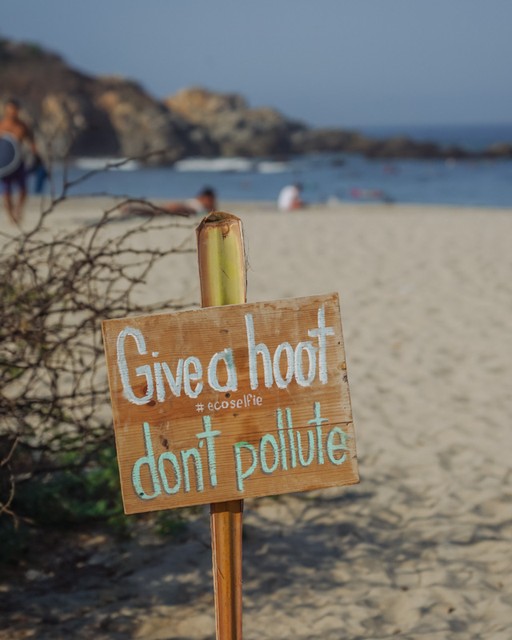
Culturally, these cities exist behind a curtain, shielding visitors from the real, authentic culture of the destination they are visiting. Local language, cuisine, currency, and culture are disguised, and some holiday-makers might spend their entire holiday without experiencing any kind of local life. Whilst many would argue resorts bring valuable income to communities, the reality is that most of this money is taken out of the local economy by international tourism corporations.
And as these cities rise in popularity with travelers, and visitors flood in by the hundreds of thousands, these issues are intensified, placing substantial pressure on the environment, society, and culture of the destination.
Eco Friendly Alternatives to Mexico’s Popular Resort Cities
Mexico’s tourism industry is a victim of its own success, and many popular resort destinations around the country are plagued by these issues. Sadly, most travelers to Mexico cluster in just a handful of resort cities around the country.
But why not consider somewhere else? Mexico’s more eco friendly destinations are just as worthy of a visit, with the same level of tourist amenities, just on a smaller scale. Often these destinations are more naturally scenic, offer a much more authentic view of Mexican culture, and are less crowded and more affordable.
And the good news is, you don’t need to get too far off the beaten track to have a more authentic, low-impact holiday in Mexico.
All the destinations recommended below still have great tourist facilities, with accommodation for all budgets, a range of both local and international restaurants and easy access via plane or comfortable long-distance bus. You can still enjoy all the luxury and comforts of a holiday, but do so in a smaller destination that is less detrimental to the unique environment, society and culture of Mexico.
Replace Cabo with Todos Santos
At the southern tip of the Baja Peninsula is the raucous resort city of Cabo San Lucas. Party central, Cabo has long been a destination for spring breakers, bachelorettes, and other rowdy revelers. Luxury all-inclusive resorts line the coast, every kind of chain store can be found in the malls around town and the restaurant scene is largely international focused. To say the least, Cabo is not an overly accurate depiction of Mexican culture.
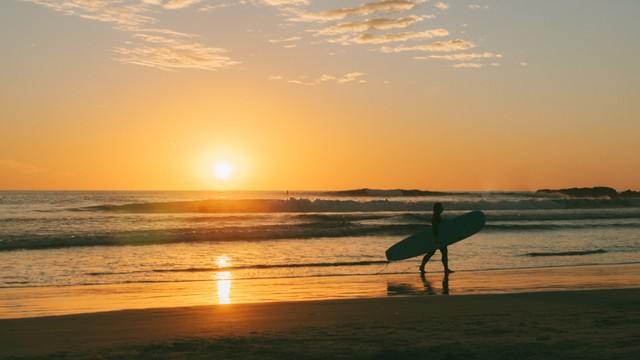
But less than an hour north of Cabo San Lucas is the small, laidback town of Todos Santos . Declared as one of Mexico’s pueblo magicos (magic towns), Todos Santos could not be more different than chaotic Cabo. Although still a popular tourist destination with all the usual amenities, the eco friendly tourism industry in Todos Santos is much more low-key and better integrated with the local culture and community.
The centre of town is a grid of charming cobblestone streets, with historic red-brick buildings and colorful flags waving overhead. There are miles of unspoiled golden coastline prime for surfing, where turtles nest and whales splash offshore, without the disruption of noisy beach clubs and hordes of tourists. The accommodation and dining scene consists of independent, small-scale businesses, most of which have strong sustainability initiatives to support the environment and community of the area.
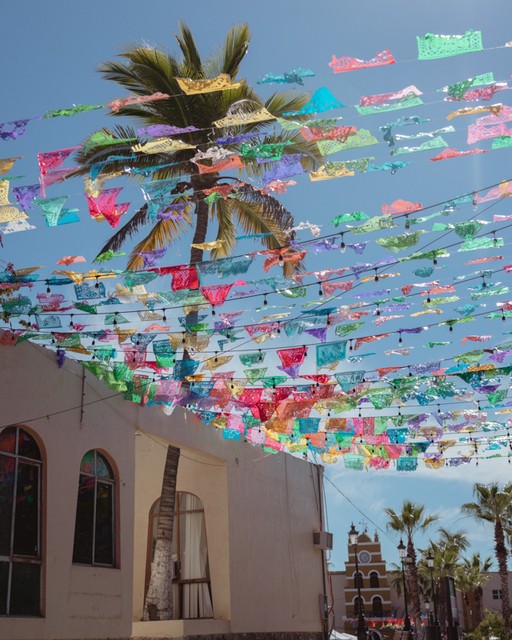
Swap Puerto Vallarta for San Pancho
Puerto Vallarta has long been a holiday destination for Canadian and American snowbirds chasing the sun. What was once a small beach town has developed into a sprawling resort city on the Pacific Coast in the state of Jalisco. This intense urbanisation has had major environmental consequences, with loss of biodiversity and large-scale deforestation to support an ever-growing tourism industry. Welcoming up to 5 million visitors per year, Puerto Vallarta is without a doubt one of the most popular destinations in Mexico.

Instead of cramming yourself onto a packed stretch of sand and standing shoulder to shoulder with other tourists in line for restaurants, head just a few hours north to San Pancho . Officially San Francisco, this slow-paced, hippy town is located in the neighboring state of Nayarit.
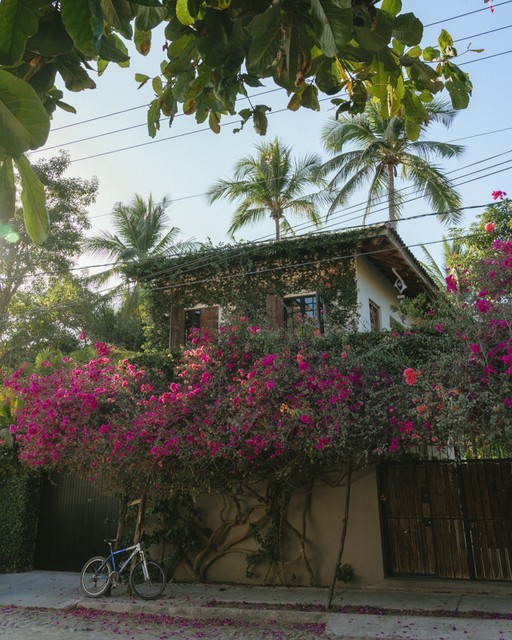
The town is host to fantastic eco-friendly accommodation options, delicious vegan restaurants, and a tight-knit community with a passion for its people and the environment. By supporting this smaller-scale tourism industry, your tourist dollars will remain in the local economy and provide benefits to residents. Plus, you can find some peace and quiet and truly enjoy the stunning beaches, jungle and landscapes Mexico’s Pacific Coast has to offer.
Skip Cancun and Head for Huatulco
Cancun is synonymous with tourism in Mexico. But less than 50 years ago, Cancun was nothing more than a jungle-covered peninsula on the Caribbean Sea. The area was specifically selected by the Mexican Government and developed from the ground up as a resort city to attract tourists and bring money into Mexico.
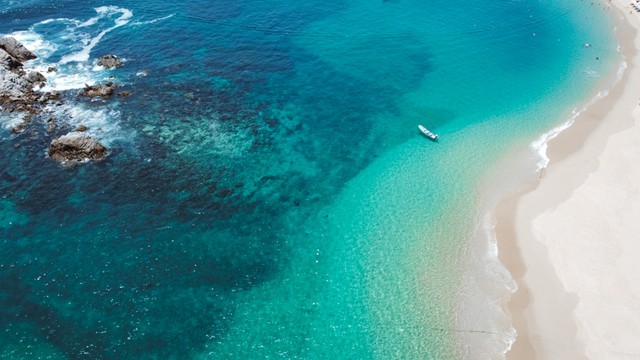
Cancun’s Zona Hotelera (Hotel Zone) embodies everything that is wrong with tourism. This 14-mile strip of land is jam-packed with towering resorts, glitzy malls, huge foreign entertainment venues and virtually nothing authentically Mexican. It met the original brief perfectly and has become a gringo paradise attracting millions of tourists each year.
But not all planned tourist developments end up like Cancun. Tucked away on the Oaxaca coast is Bahias de Huatulco . A collection of nine sparkling bays in the Pacific Ocean, Huatulco is another of the Mexican Government’s planned resort cities. Thankfully, the brief for developing Huatulco was a lower-impact collection of low-rise resorts spread across the different bays, with large swathes of national and marine parks in between.
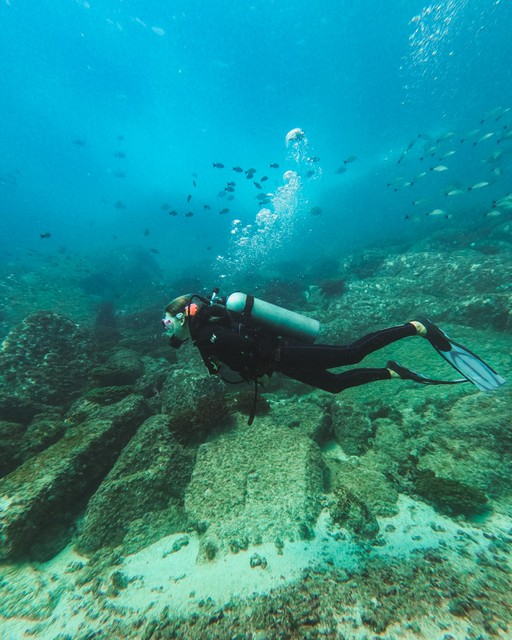
In the eyes of the government, Huatulco might be considered a failure. But for tourists seeking a quieter slice of scenic beach paradise, it’s the perfect place. The dazzling blue waters are home to some of the country’s best snorkeling and diving, and boat trips to hidden bays are a popular activity.
Change Playa Del Carmen for Puerto Escondido
South of Cancun on the Riviera Maya is Playa del Carmen. Once a local Caribbean town, Playa del Carmen is now tourist central, having undergone extensive development. Mangroves and rainforest were swapped for a concrete jungle of nightclubs, hotels, and glitzy malls. These international creature comforts attract holiday-makers with the lure of familiarity away from home.
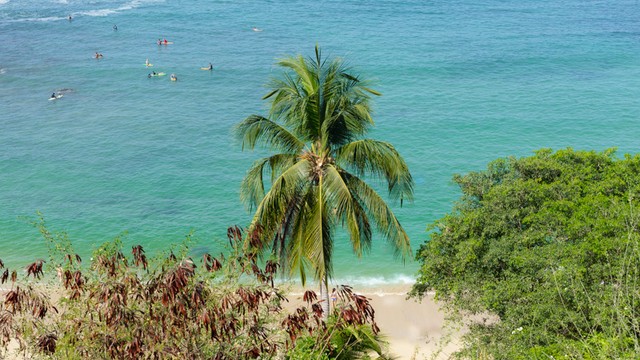
But even if you prefer your vacay spots more developed than a lone palm-fringed beach, there are better spots to choose from than Playa del Carmen. Puerto Escondido on the Oaxaca coast is a small city hosting several different beaches and neighborhoods. You can enjoy all the tourist amenities of Playa del Carmen, in a more authentic, Mexican destination that has developed around tourism, not for tourism. You will still find turtles nesting on the beaches, whales and dolphins splashing offshore, unspoiled coastline and quiet, local streets where real Mexican families live.
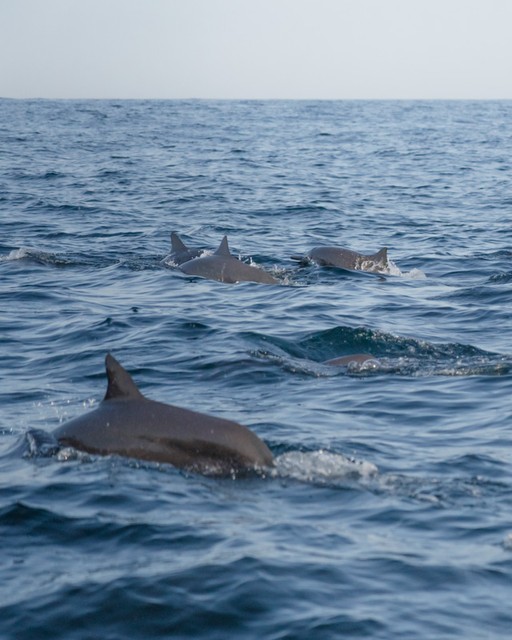
If you want to stay in the centre of the action with parties, restaurants, and plenty of buzz, choose Zicatela. If you prefer something a little hippier, with dirt roads and funky vegan cafes, La Punta is your spot. Or if you want a perfect mix of the two, with a laidback vibe yet easy access to amenities, Rinconada is a great choice.
Trade Tulum for Bacalar
Tulum has grown exponentially in popularity in the past decade, and the environment and infrastructure of the town can’t keep up with the hordes of visitors arriving each year. Ironically, this bohemian beach town has branded itself as an eco-friendly, spiritual haven. In reality, these so-called sustainable hotels are polluting the cenotes, using electricity from diesel generators, and clearing the jungle for further developments.
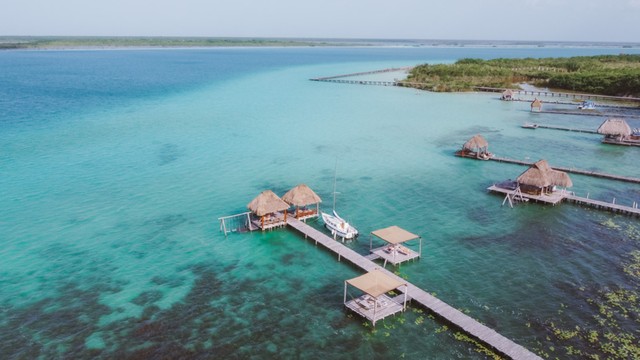
Just three hours south of Tulum is Bacalar . It might not be a beach town, but it may as well be, with its incredible Laguna de Los Siete Colores (Seven Color Lagoon). With its vibrant blue waters, Bacalar’s lagoon gives any Caribbean beach a run for its money.
Many consider Bacalar the Tulum of 20 years ago, with a sleepy, hippy vibe luring travelers in and keeping them there longer than expected. You can still find beautiful boho-style accommodation, aesthetic cafes, and funky restaurants like Tulum. But you’ll also discover affordable prices, more Mexican locals and visitors, and a stunning, preserved natural landscape in and around the lagoon.
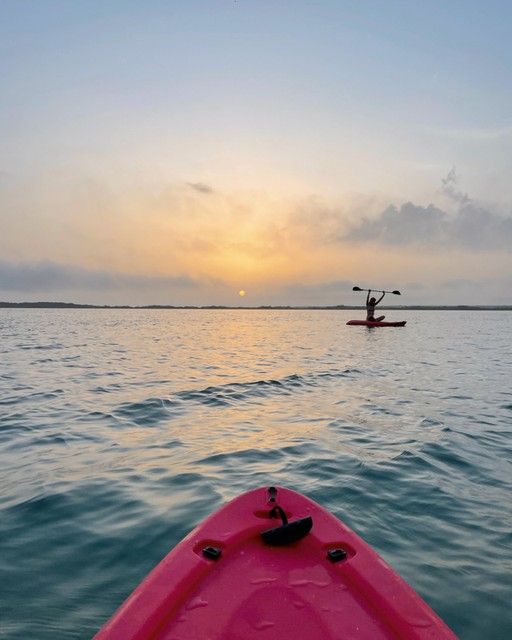
Supporting Eco Tourism in Mexico
If you’re thinking of heading south of the border, consider skipping the popular resort cities. Sure, you might have heard more about them online, know friends and family who have visited them, or maybe you’ve even been yourself. Instead, opt for one of these smaller, more authentic and sustainable towns. Spread your money, support Mexican-owned businesses, and have a holiday with a positive impact. Chances are, you’ll enjoy yourself even more!
Post by Sally Rodrick of sustainable travel blog, Sally Sees . Follow her on Instagram at @sallysees . Inspired by this post? Check out our Escapes for more eco-friendly places to visit around the world.
More From The Journal
32 bloggers leading the way toward more mindful travel.
These 32 bloggers and influencers are leading the way toward more thoughtful, sustainable and mindful travel.
5 Ethical Whale Watching Tours from Coast to Coast
From Cape Cod to San Diego, these ethical whale watching tours use responsible providers and environmental best practices.
Best Islands to Visit for Eco-Conscious Travelers
From Dominica to the Galapagos, these are the best islands to visit for eco-friendly travelers who want to have a positive impact.
Sign up for monthly inspiration.
More than 20 local initiatives in Mexico City are already operating with a new model of responsible tourism
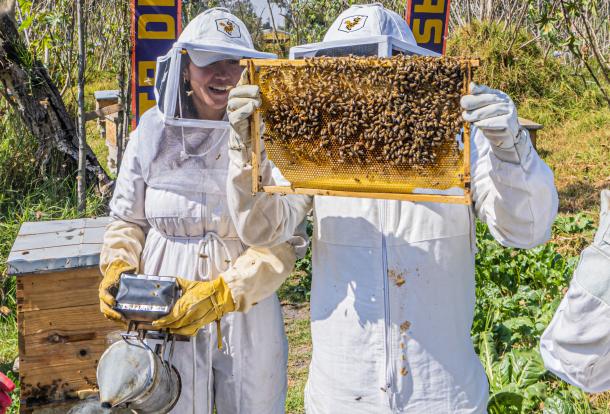
- The scheme encouraged proposals from communities whose culture and work were minor known due to the centralization of conventional tourist circuits.
Environmental education activities, heritage safeguarding, sustainable agricultural production and even improvements in roads and accessibility are strengthened by their inhabitants through the projects.
Mexico City, April 3, 2023 - Communities and groups in Mexico City generated 24 new creative, cultural and community tourism projects through a pilot model that seeks to counter negative tourism impacts, by promoting knowledge and protection of heritage and cultural diversity, and a direct economic redistribution towards local people outside of traditional tourist circuits. For example, in the municipalities of Iztacalco, Iztapalapa, Tlalpan, or lesser-known areas of Xochimilco and Cuauhtémoc.
The proposals generated by the communities themselves were strengthened with a pilot model of sustainable tourism that recovered the strengths of Airbnb together with the UNESCO Mexico guide, which built six selection and management criteria for the initiatives, such as sustainable social impact and local economic flow, and encourage visitors to be responsible and respectful of heritage, culture and territory. More than 1,000 national and foreign people have participated in the tours and activities at this time, and the benefits are already present.
Sandra Corrales has been working for five years with beekeepers and producers from the Abejas de Barrio collective and created the Beekeeper for a day tour in Xochimilco , through little-frequented water channels ( canales ), in which local producers participate to promote reassess of their work. This makes it possible to “ hacer colmena ” (to build beehive), as Sandra says, to increase local economic income and continue with community projects, such as free courses and workshops for girls and boys in chinampas to preserve knowledge and respect for biodiversity, heritage and the culture that extends beyond the conventional areas of Mexico City.

For me, this experience represents a reconnection with my ancestors and the female legacy of my family, since they were the ones who taught me to cook. The base of Mexican food is corn, so the experience also connects travelers with Mexican culture. We want to convey our love for the chinampas and thus promote the care and respect they deserve
The model also has the objective of mobilizing neighbours and locals, transcending the conventional perspective of tourism so that, for example, people return to buy their groceries in markets or with producers on some of the routes, to consolidate a local circular economy, such as the people who produce tortillas in the upper part of the mountain in Xochimilco.
Other ventures and proposals for the heritage and cultural and natural diversity of Mexico City that are part of this initiative are:
- Original flavours of Coyoacán with a gastronomy expert . A tour of Coyoacán markets guided by Rodrigo to taste street food in familiar and contemporary places, such as tostadas, tlayudas, esquites and quesadillas. Rodrigo tells the stories that make Coyoacán a special place and why it has been chosen by writers, artists, filmmakers, and intellectuals as his home.
- Tour a lakeside town . This tour is led by Paulina and begins by bike, from the historic Arco de Tlaltenco towards the centre to see the architecture of the Mazatepec, Tlaltenco and El Calvario churches until reaching the centre of Tláhuac. There, travellers move to Lake de Los Reyes for a trajinera tour to appreciate the natural ecosystem in a chinampa, where they learn about ancestral agricultural techniques and can even taste vegetables from the same chinampa. Upon return, visit the Tláhuac community museum and the church of San Pedro. Finally, an artisan workshop is given by locals from Jardín del Arte, using natural elements from the area.
- River, wellspring and pulque in Tlalpan. Together with Sebastián, visitors can get to know the largest wellspring in Mexico City in the Fuentes Brotantes National Park, a unique place in the city. They also go to the neighbourhood of La Fama, where they can taste the traditional pulque and the curados while learning about the history of the yarn factory in the place. Finally, they walk to the Center of Tlalpan to learn about its history, and architecture and relax in its main square along with lunch before leaving.
- Jewels of a Porfirian neighbourhood . A tour to visit Santa María la Ribera with the youngest hostess of the group, Natalia, and taste the most traditional dishes in one of the oldest neighbourhoods in Mexico City.
The 24 experiences pursue to contribute to how tourism is carried out in Mexico City, with a focus on a more equitable redistribution of its benefits, which is responsible and dignified for the host communities, and that visitors act with appreciation and respect for diversity and cultural assets, the identities of the inhabitants and the territories they visit, also paying attention to diversity so that all people can also enjoy tourism.
These efforts are already productive. In the last Tianguis Turístico two entrepreneurs from this program were recognized for their initiatives. These are: Fernando Gabriel Acosta Islas who received a mention for "The creation of unique and innovative experiences in CDMX" for Discover the real CDMX by cable car , and Araceli Márquez Romo from Gastronomy from la chinampa to the cazuela who received a recognition for Good Practices of Equality 2023 in the Category of Good practices in the organizational structure of tourism companies.

I created this experience with the aim that more and more people can get to know Tláhuac in a different way and discover its true essence while promoting sustainable mobility by bicycle. Being an Airbnb Experience Host represents a way to support my mayor's office and promote responsible tourism
The full catalogue of proposals for this project is available on the UNESCO website . To reserve a place, you have to enter the Airbnb platform, go to the link for each one, check availability and choose the desired date.

Take a look!
Catalogue of creative, cultural and community tourism in Mexico City.
UNESCO Mexico and Airbnb.
About UNESCO
UNESCO is the specialized agency of the UN for education, science, culture and communication and information. In the cultural sector and through its six cultural conventions, UNESCO promotes the integration of culture as a factor for peace, inclusive economic development, social cohesion, and sustainable management of biodiversity, in addition to the exercise of cultural rights and gender equality, to mention a few examples. UNESCO promotes the development and implementation of policies aimed at promoting sustainable tourism that creates jobs and promotes culture and local products based on the Sustainable Development Goals (SDG) 8 and 12 of the United Nations 2030 Agenda.
About Airbnb
Airbnb was born in 2007 when two hosts welcomed three guests into their home in San Francisco and have since grown to more than 4 million hosts who have welcomed 1.4 billion guests in almost every country in the world. Every day, hosts offer both unique stays and experiences that allow guests to connect with communities more authentically.
Related items
- Guidelines and tools
- Policy Advice
- Sharing knowledge
- UN & International cooperation
- Cultural tourism
- Cultural traditions and mass tourism
- Tourism and culture: rethinking the mix
- Culture and development
- Diversity of cultural expressions
- Intangible cultural heritage
- Intangible heritage
- Country page: Mexico
- Region: Latin America and the Caribbean
- UNESCO Office in Mexico City
- SDG: SDG 11 - Make cities and human settlements inclusive, safe, resilient and sustainable
- SDG: SDG 8 - Promote sustained, inclusive and sustainable economic growth, full and productive employment and decent work for all
- SDG: SDG 10 - Reduce inequality within and among countries
- See more add
This article is related to the United Nation’s Sustainable Development Goals .

Other recent news

UN Tourism | Bringing the world closer
Share this content.
- Share this article on facebook
- Share this article on twitter
- Share this article on linkedin
The Vision for a Responsible Recovery of Tourism in Mexico and Latin America
Transforming Vision Into Action - On the Ground
16 February 2022

Has the pandemic changed the paradigms in the tourism sector in Mexico and Latin America? This question has arisen in forums, meetings, analyses and the day-to-day operations of the sector since the COVID-19 pandemic began. This article aims to share a collective response based on the experiences of tourism leaders from the public, private and social sectors in Mexico and Latin America. The first question on the subject was: how can we know if something has changed? The authors of this article found the ideal framework to investigate this in the document: One Planet Vision for the Responsible Recovery of the Tourism Sector , published by the World Tourism Organization (UNWTO) on 5 June 2020, precisely in the context of the celebration of World Environment Day.
The next step was how to show that there really have been paradigm shifts. Seizing the opportunity represented by the fourth edition of the Sustainable & Social Tourism Summit in September 2020 (hereinafter, "the Summit"), the most important sustainable and social tourism event in Ibero-America, which is held yearly in Mexico, the organizations La Mano del Mono and Sustentur co-facilitated a virtual meeting in which local and national tourism leaders from Mexico and Latin America participated.
Taking as a reference the framework of responsible recovery for the planet, people and prosperity, the main challenges, achievements and concrete experiences worth making visible were shared through interviews, surveys and case studies.
In this process, it became evident that there had been a profound change in the paradigm of the sector: “In 2019 it was thought that we needed prosperous tourism to encourage healthy people to take care of the planet; however, the pandemic has taught us that what we really need is a healthy planet for healthy people to build prosperous tourism.”
This paradigm shift, which is becoming increasingly consolidated globally and also in Mexico and Latin America, inspired us to move from vision to action and ask the global leaders who attended the Summit basic questions to understand where they were focusing efforts for the responsible recovery of tourism, or where the main challenges to achieve such recovery were perceived.
Clearly at that time, biosafety concerns were on the sector's agenda as a priority (and continue to be so today), and many efforts were focused on it. The main gaps were also evident, such as climate action, the integration of biodiversity and creating circular economies in the sector; however, actions tending to generate a change in the models and in the way of doing tourism were already noticeable: an intention on the part of public, private and social actors in Mexico and Latin America to collaborate together; a sense of responsibility to recover from the crisis but with a new perspective, and concern regarding the steps to achieve it.
Analysing this reality, and with a view to generating a useful document out of the Summit with clear steps, both organizations, together with nearly 80 institutions and specialists, co-created the Vision for a responsible recovery of tourism in Mexico and Latin America , a reference framework collectively adapted to the reality of the region that invites us to create possibilities for tourism to contribute to improving the conditions for the life of people and the planet
The summary, with the Decalogue for the Responsible Recovery of Sustainable Tourism in Mexico and Latin America , provides decision makers in the tourism sector with ten lines of action , but also some references on how to make building back better in the tourism sector a reality.
It invites the entire value chain of the sector including governments, companies, civil society, communities, universities and international cooperation to re-think, re-signify and re-design the paradigms of tourism activity in Mexico and Latin America.
Reimagining tourism, measuring differently, having a long-term vision, solving challenges collectively, diversifying, and regenerating are some of these ideas that leaders are invited to explore and apply.
During the recently completed fifth edition of the Sustainable & Social Tourism Summit in 2021, and a year after having generated this process of reflection, it is clear that this Decalogue is more present than ever in the face of the reality of 2022.
We believe (and we are committed to doing so) that in the near future, we will be able to document these recommendations as success stories, and demonstrate that we can achieve tourism and a region that are resilient, sustainable, equitable, fair and, above all, very healthy for the recovery of planet, people and prosperity.
This article was written and shared by Sustentur and La Mano del Mono. Sustentur, is a leading consulting firm that seeks to transform the way in which companies, destinations, communities and governments develop and manage tourism in Mexico and Latin America, always based on sustainability and is a co-founder of the Sustainable and Social Tourism Summit. www.sustentur.com.mx La Mano del Mono facilitates alliances so that tourism can contribute to the conservation of natural areas and the well-being of communities in Latin America and facilitates the collective construction of tools for the sector during the Social and Sustainable Tourism Summit. Its website is www.lamanodelmono.org

Sustainability & Ecotourism in Los Cabos: A Full Guide
By: Author Stefania Guglielmi
Posted on Last updated: August 26, 2024
Categories Mexico , North America , Responsible travel
Planning a trip to Baja California Sur and wondering what to do when it comes to ecotourism in Los Cabos? Los Cabos is an amazing sustainable destination, and you’ll discover all about it in this guide.
Los Cabos is a gorgeous area in the southern tip of Baja California Sur, and it comprises Cabo San Lucas and San Jose del Cabo , two beautiful resort cities.
The area boasts pristine beaches, a laid-back nightlife, and it offers plenty of activities for nature lovers , as well as those who care deeply about booking sustainable activities and being responsible tourists (like you and me!).
When Los Cabos Tourism invited me to explore the sustainable side of Los Cabos, I had to say yes! Los Cabos is, in fact, one of the leading ecotourism destinations in Mexico , and its sustainability efforts, combined with the glorious natural attractions it possesses, make it an unrivaled spot for a vacation.

I’ve spent a lot of time in Mexico over the last few years, but somehow I had never made it to Baja California Sur or Los Cabos – what a mistake!
Check out this full guide about sustainability & ecotourism in Los Cabos so you can make the best of your time there.
⚠️ Please never book activities that involve captive animals , such as riding camels or swimming with dolphins. Horseback riding is usually ok, but do your research and make sure the tour you book with is a responsible one that takes care of the animals.
Table of Contents
ECOTOURISM ACTIVITIES IN LOS CABOS
When it comes to sustainable travel in Los Cabos, there’s no shortage of activities to be enjoyed . Below you’ll find some of the very best ones, offered by responsible providers.
Adopt and Release a Baby Turtle
Adopting and releasing baby turtles is possibly one of the most enjoyable (and satisfying!) things to do in San Jose del Cabo . We were lucky enough to be in Los Cabos in the right season for this activity, and it was one of the highlights of our trip.
The turtle hatching season in Los Cabos goes from late July till November, so keep this in mind if this is an activity you want to include in your itinerary.
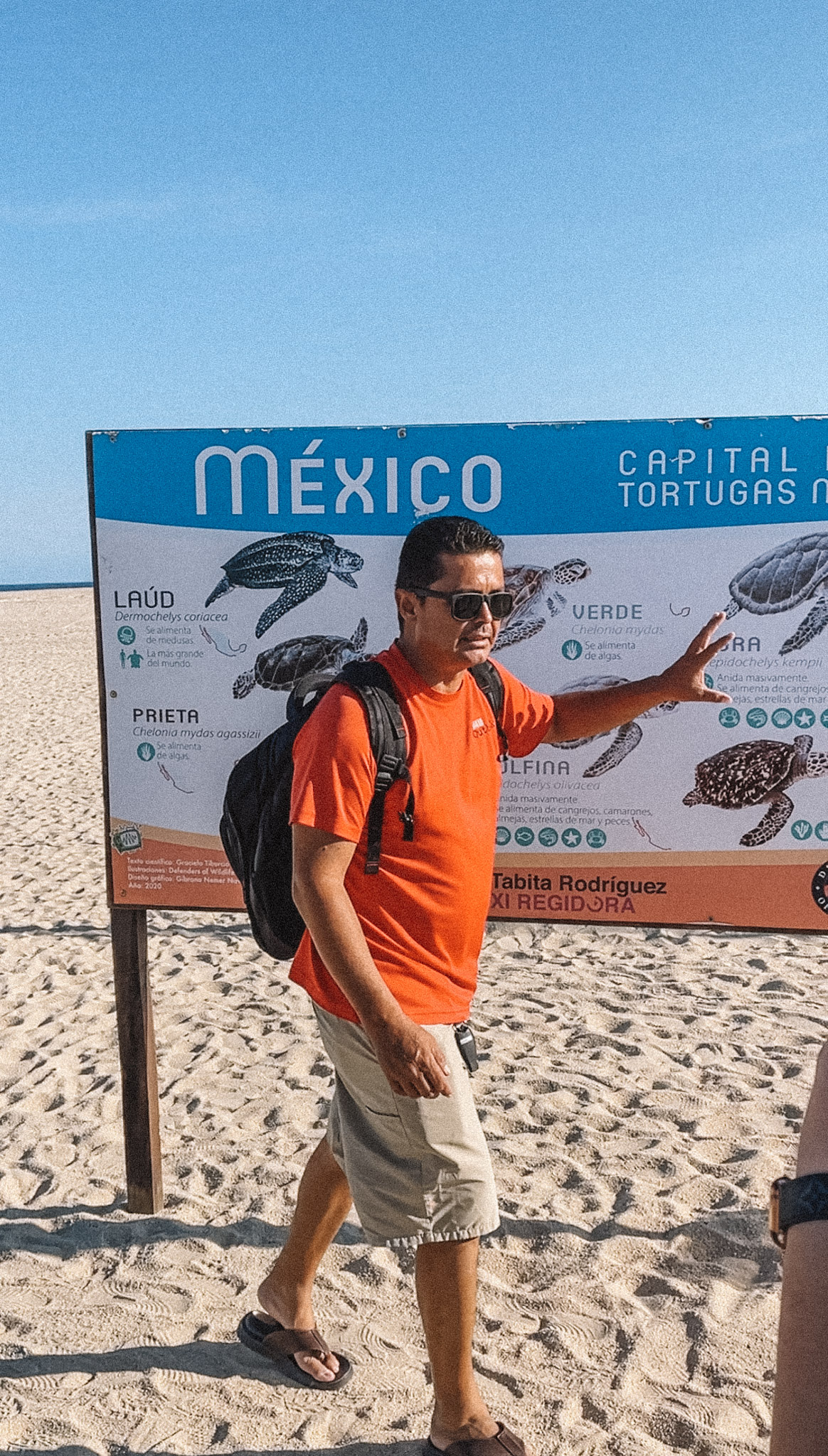
When you book a turtle release tour with CalypsoTrip , you’ll be taking part in a wildlife conservation program, helping preserve the species and learning about it in the process.
An expert will enlighten you on their behavior and lifespan, their natural habitat, and the importance of protecting them, as endangered sea turtles are sadly more common than we think .
The most exciting part is arguably when the hatchlings are released from their nests and make their way to the ocean , ready to start their life in the water. Witness the magic of the natural world while being actively involved in the protection of the species.
You can also book this same activity through Viator, which offers a full refund if you need to cancel the tour for any reason, and you do so up to 24 hours in advance.
➤ The Turtle Release Eco-Experience includes a guided commentary about the turtles’ biology and their environment as you release them, and hotel pick-up and drop-off. ➥ BOOK IT HERE
➤ You can otherwise book this Los Cabos Turtle Release Conservation Program . You’ll have the chance to adopt a baby turtle, and learn about the species and how endangered they are as you help release them into the ocean. You’ll also visit a donkey sanctuary! ➥ BOOK IT HERE
A Farm-to-Table Cooking Class
Mexico is world-renowned for its cuisine , and learning the secrets behind the country’s tastiest traditional dishes is the ultimate way to enjoy them. When in Los Cabos, though, the experience is enhanced by its focus on sustainability and in providing a farm-to-table culinary journey.
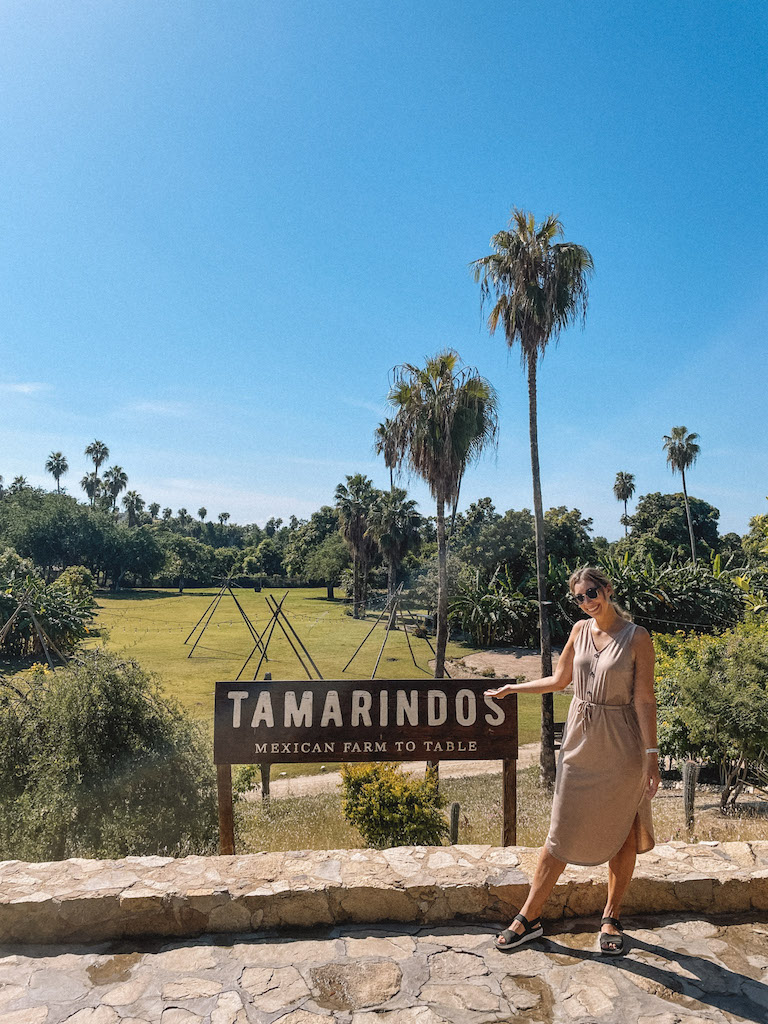
Tamarindos is an organic farm barely 15 minutes from San Jose del Cabo, where you’ll get to harvest your own herbs and vegetables before immersing yourself in a hands-on cooking lesson.
You’ll learn to prepare a 4-course traditional meal following the instructions of a local chef while learning all about Mexican and Mediterranean cuisines (plus getting new recipes to take home with you!)
Groups are limited to 6 people, so the experience is very personalized, and you can even decide what dishes you’d like to learn and prepare, relishing in them once they’re ready.

It’s one of the most rewarding activities to enjoy in the area, and it perfectly aligns with the concept of sustainable travel in Cabo. We loved our cooking class and meeting other travelers!
➤ The Farm-to-Table Experience includes the cooking class and lunch (drinks are paid separately). ➥ BOOK IT HERE
➤ An alternative is the Azteca Cactus Taco – Farm to Table Cooking Class in Los Cabos . Discover the roots of Mexican cuisine in a rancho, where you’ll tour a local farm, feed the animals, and harvest nopales (a prickly pear cactus that stars some Mexican specialties). Then, it’s time for your hands-on cooking class!
As you prepare tasty dishes, learn about the traditional ingredients and local culinary customs. Cap off the class by savoring tortillas, salsas, and Nopales a la Mexicana . ➥ BOOK IT HERE
Blue Flag Beaches of Los Cabos
Los Cabos is where the Sea of Cortez meets the Pacific Ocean, and it’s an area mainly recognized for its stunning beaches. Rightly so, as they are indeed spectacular, and 25 of them even boast a blue flag certification .
The blue flag certification is an internationally recognized award that guarantees beaches have met (and continue to do so) strict criteria on sustainability, safety, environmental impact, and accessibility .
It assures travelers that the beach is clean and safe , and also that it has a good emergency plan, a good number of lifeguards, its management is respectful to the ecosystem and wildlife, and basically, that it’s an eco-friendly facility.
There are over 20 stunning beaches which boast the blue flag recognition, including Acapulquito , Las Viudas , Palmilla , Lover’s Beach , and La Gaviota .
▶ One of my favorites, though, is Chileno Beach , located in Cabo San Lucas. It features a long stretch of white sand and turquoise waters, which are perfectly swimmable, and has a very laid-back vibe.
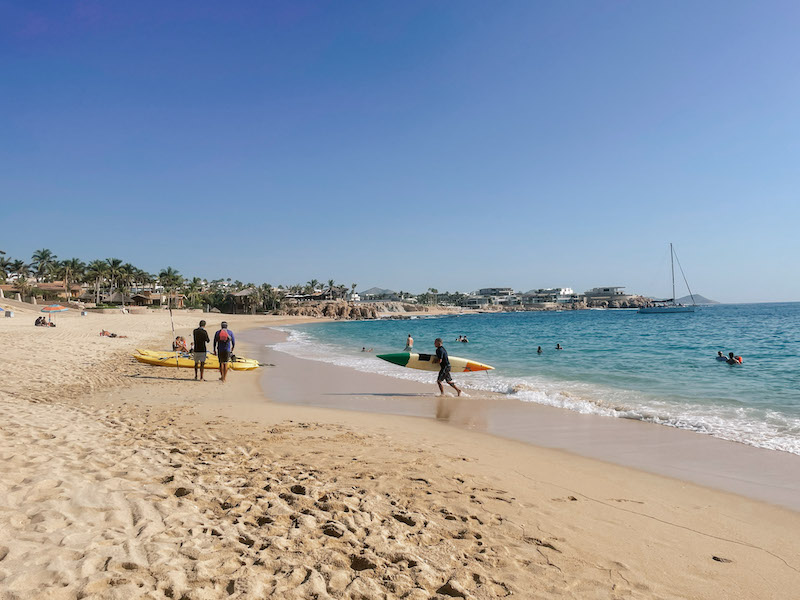
Snorkeling is one of the main activities at Playa Chileno , as is spending the day sunbathing by the shore or going for a swim. There are toilets and showers on-site, but you won’t find beach clubs or restaurants, which helps maintain the relaxed atmosphere of the beach.
This is where we went snorkeling and oh my gosh! I definitely was not expecting to see so much fish!
▶ Santa Maria Beach is another unmissable beach situated 7 miles north of Cabo San Lucas, in the gorgeous Santa Maria Bay. Calm waters are fringed by powdery white sand and massive rock formations to the sides, creating a dramatic backdrop that has become one of its main attractions.
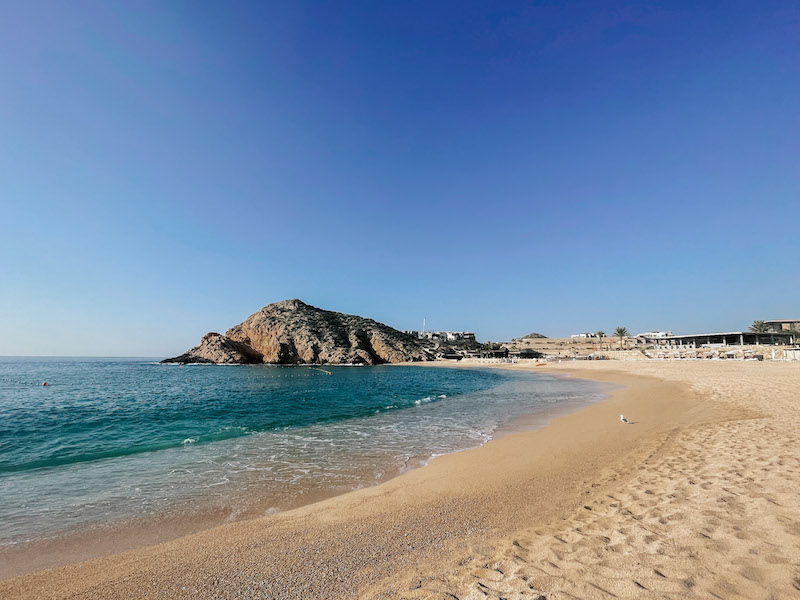
This blue flag beach is sort of secluded, and an astounding spot for snorkeling (among the very best in Los Cabos, actually), as it’s home to schools of colorful reef fish and insanely clear waters . There are several boats ready to take you on a snorkeling trip during the day.
Umbrellas and beach chairs can usually be rented at the entrance, although the service is offered by a vendor and not a beach facility per se. It’d be wise to take your own if you plan to spend the whole day at the beach.
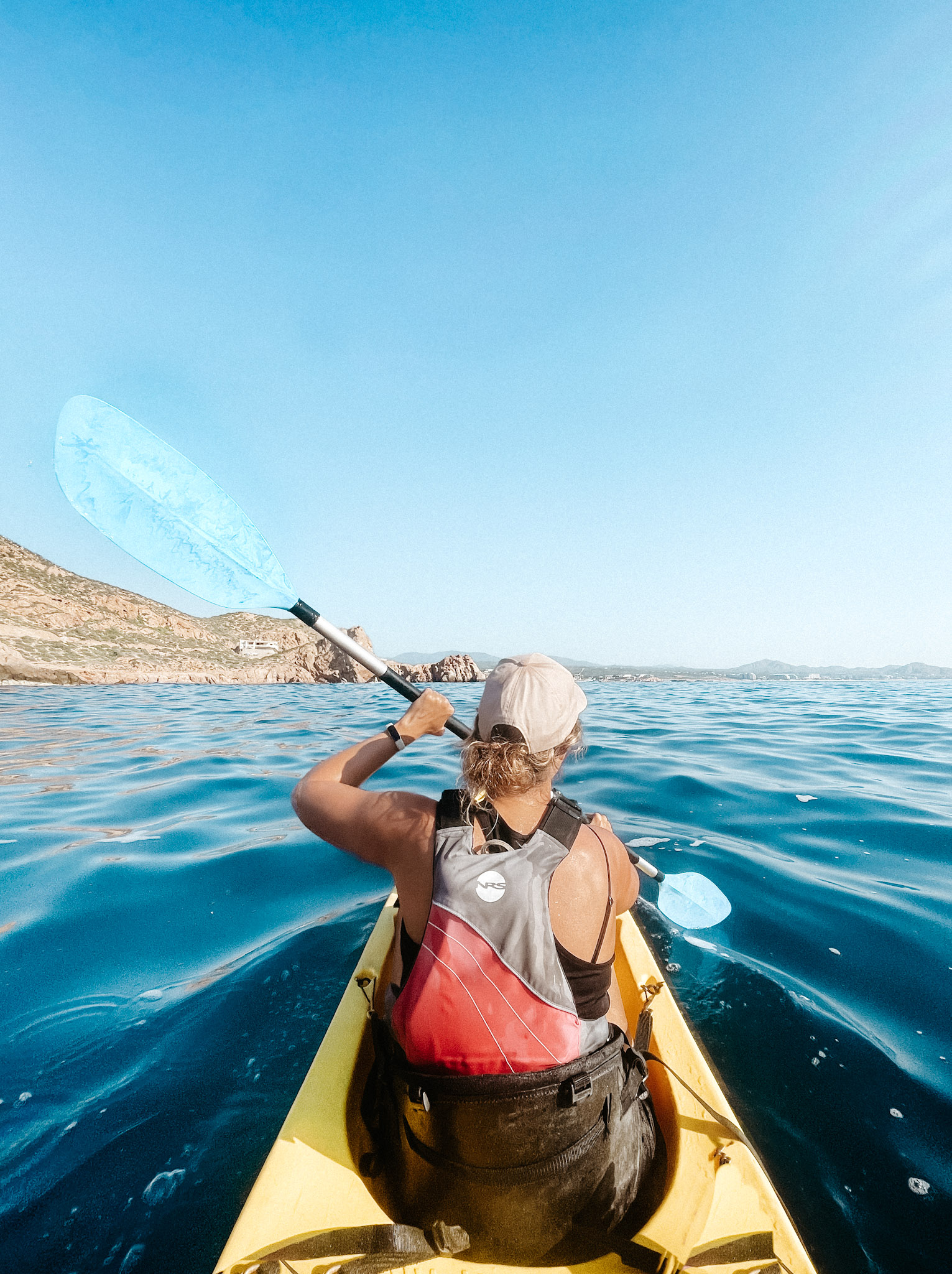
One of the best ways to enjoy these protected and oh-so-gorgeous locations is by getting in the water. In my opinion, kayaking and snorkeling in Cabo is a must, and you can do so with a comprehensive tour that includes the activities and equipment like we did with High Tide Los Cabos .
You can paddle from one beach to the other on a glass-bottom kayak and then snorkel in beautiful tidal pools among fish, urchins, and maybe even turtles and starfish. You can book your tour directly on their website or on Viator.
➤ The Snorkeling Tour to Chileno and Santa Maria includes swimming stops at coral formations, as well as round-trip transportation and free time at the beach. ➥ BOOK IT HERE
➤ This Kayak and Snorkel Tour is a private experience. You’ll explore both bays on a glass-bottom kayak, and snorkel in prime locations with your own group. ➥ BOOK IT HERE
Go on a Sustainable City Tour
To discover the gorgeous area through a local’s eyes, truly understand it, and learn about its hidden gems and very best spots, there’s not better way to do it than by joining a city tour .
It’s one of the ultimate activities in Los Cabos, and you’ll help support local communities while immersing yourself in the history and stories of San Jose del Cabo.
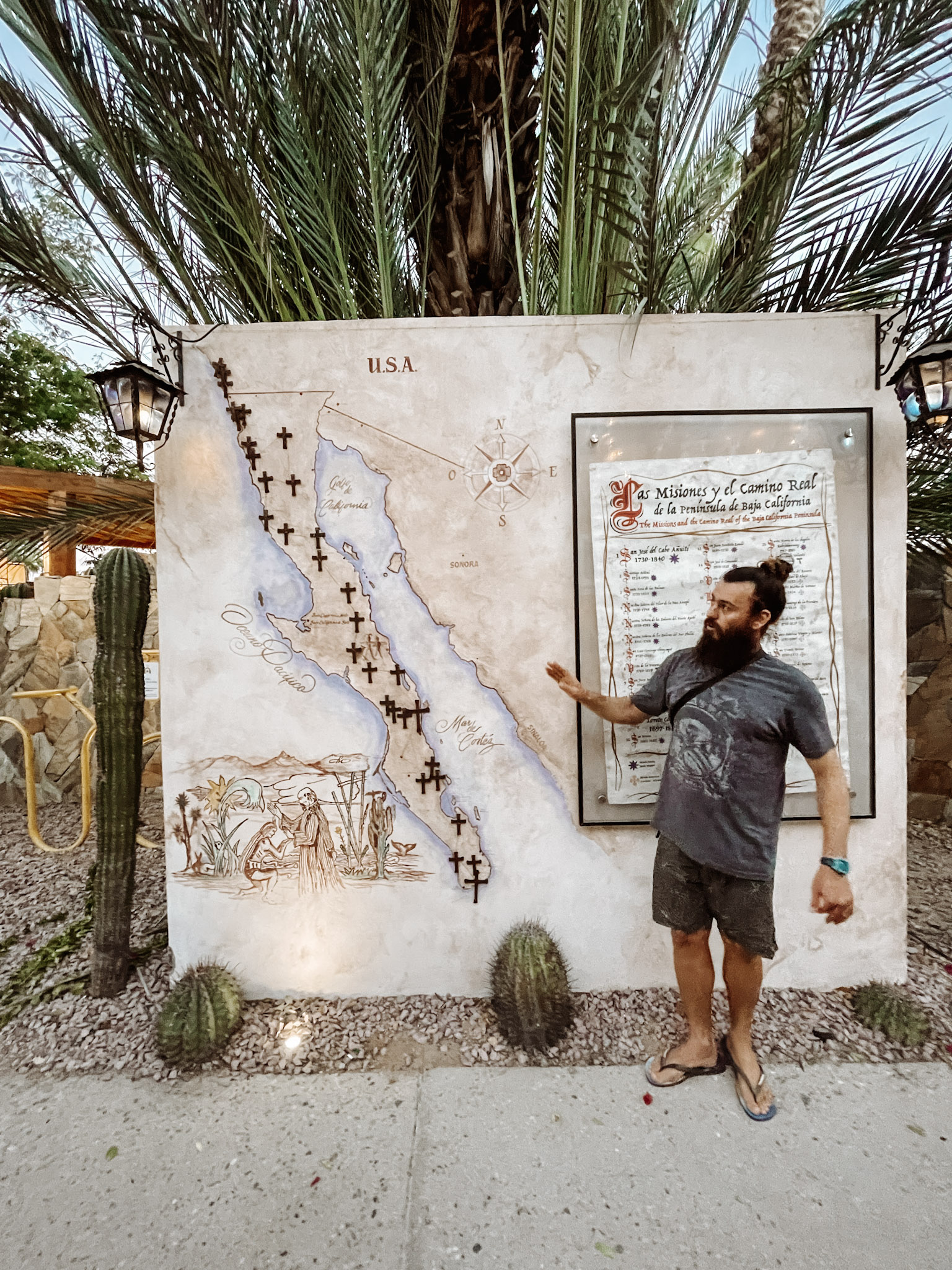
The city tour by Cabo City Tours that we suggest aims to keep the local identity alive through education, offering free field trips to public schools and NGOs , and introducing the values of the community and its traditions to new residents.
This project is funded by visitors like you who book this incredibly interesting and sustainable tour when in Los Cabos.
The city tour is based in the art of storytelling, and as you make your way around San Jose del Cabo, your knowledgeable guide will tell you the stories of the region’s tribes, battles, and pirates .
We are not particularly into history, but this was not the usual boring, historical tour – our guide was fun, and we loved learning so much about the area! You’ll also learn about the legends that have lived on for centuries, as well as statistics and interesting facts about the city.
Plus, you get to walk all around San Jose del Cabo , which is a very cute, super colorful town! When visiting Los Cabos, I highly recommend taking part in this tour.

➤ This Cultural Walking Tour takes place in the evening, and lasts close to 2 hours. It operates on a small-group basis and enables you to explore the city center in depth. ➥ BOOK IT HERE
Day Trip To Cabo Pulmo
Cabo Pulmo National Park is situated 60 miles north of Los Cabos, which makes it an unmissable day trip destination. This is the ideal trip for those interested in ecotourism in Cabo!

The park stretches for about 5 miles on the coastline, backdropped by glorious mountains and surrounded by desert.
It features the only hard coral reef in North America , home to over 800 sea creatures and estimated to be over 20 thousand years old! The turquoise waters of its beaches are ideal for swimming and snorkeling, and you can also enjoy fantastic scuba diving in Cabo Pulmo .
The total of the park’s protected area is banned from fishing , and since its establishment, the abundant marine life that had been driven away from the coral reefs have gradually come back.
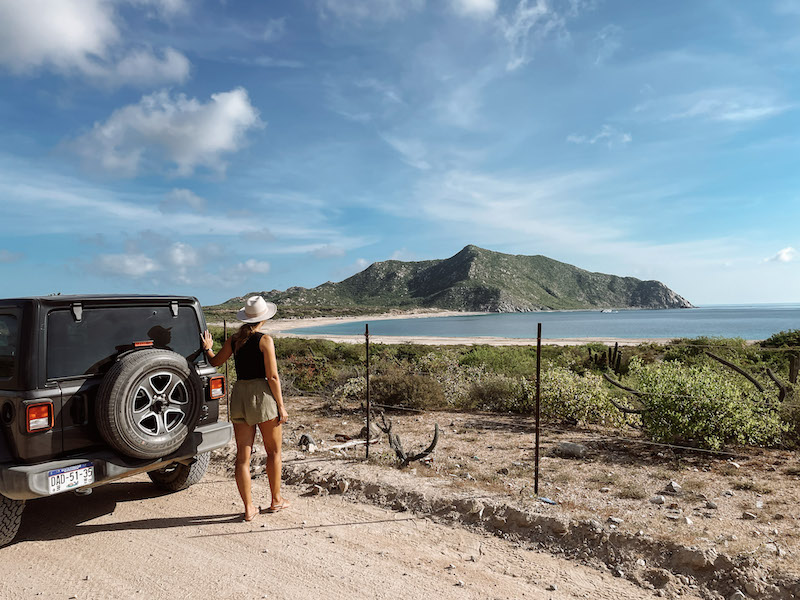
In fact, Cabo Pulmo’s coral reef was on the verge of dying due to overfishing and pollution, and several conservation programs managed to rescue it and bring it back to life. Today it boasts striking natural beauty and has benefitted marine animals greatly.
Sea turtles, rays, sharks, fish, invertebrates, and humpback whales are among the creatures that call Cabo Pulmo National Park their home. The park is a UNESCO World Heritage Site and it’s also recognized by the Ramsar Convention .
While swimming, snorkeling, and scuba diving are by far the best and most popular activities in Los Cabos’ marine park, there’s plenty more for you to do while you’re there.
Paddleboarding , sea kayak, sailing , hiking , and indulging in the local cuisine are some of the things you can enjoy on your day trip to the national park.
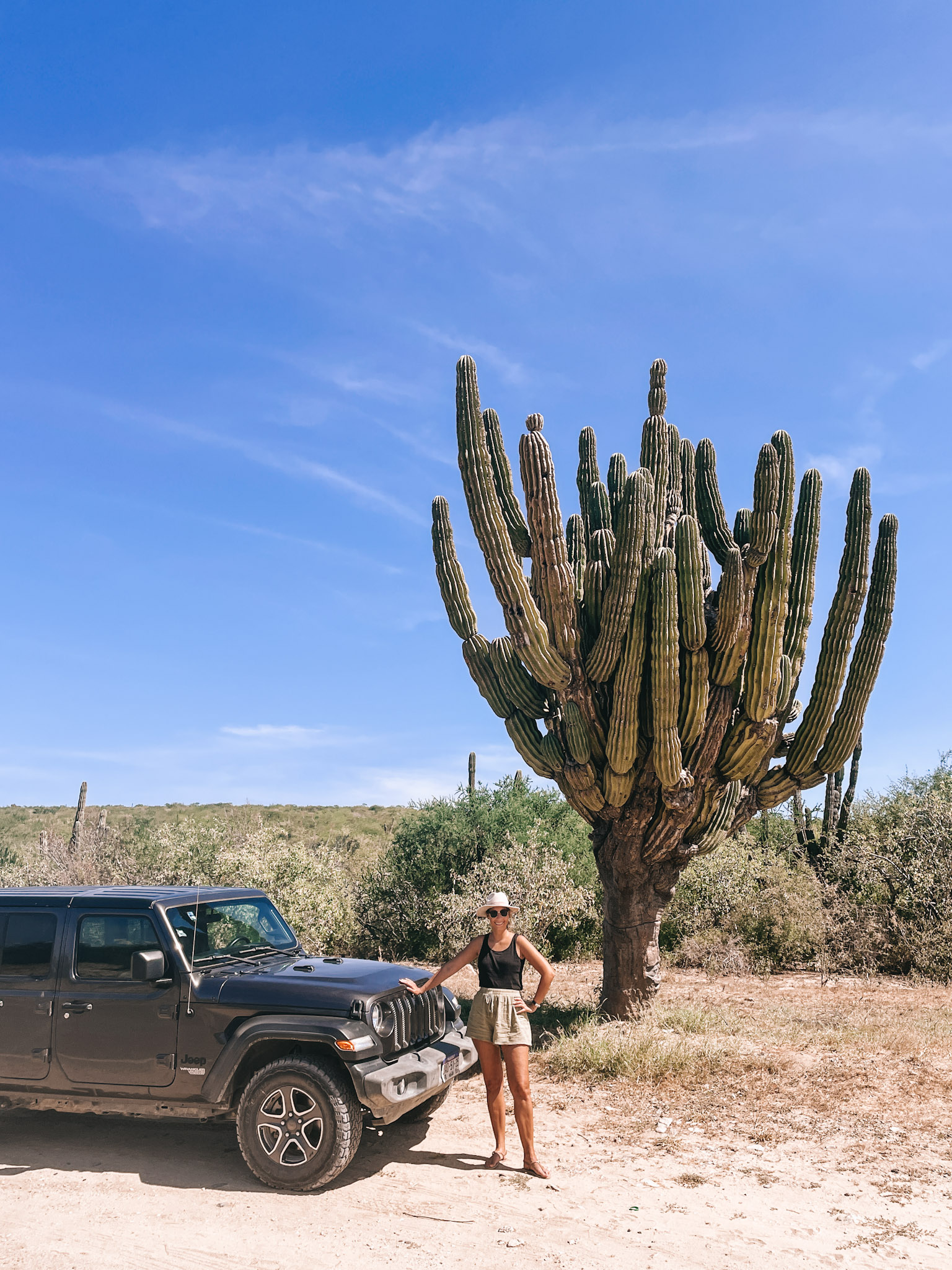
➤ One of the best ways to visit Cabo Pulmo is on a jeep tour like the one we went on with High Tide Los Cabos. The 4×4 vehicle will allow you to get there via the most scenic road, with stunning views of Sea of Cortez along the way.
You’ll also be able to explore the off-road, mountainous trails without worrying about the driving.
A visit to Playa Arbolitos is included, where you’ll enjoy snacks before getting in the water for some snorkeling along the reef and among plenty of sea life .
This Private Jeep Tour is a 7-hour trip and includes hotel pick-up and drop-off, as well as lunch, use of equipment, refreshments, and entrance fees. ➥ BOOK IT HERE
Whale Watching in Los Cabos
December through April is the migration period for gray and humpback whales . Thousands of these spectacular creatures make their way south from the Arctic to the warmer waters of the Baja Peninsula in Mexico, where they’re going to mate and give birth .
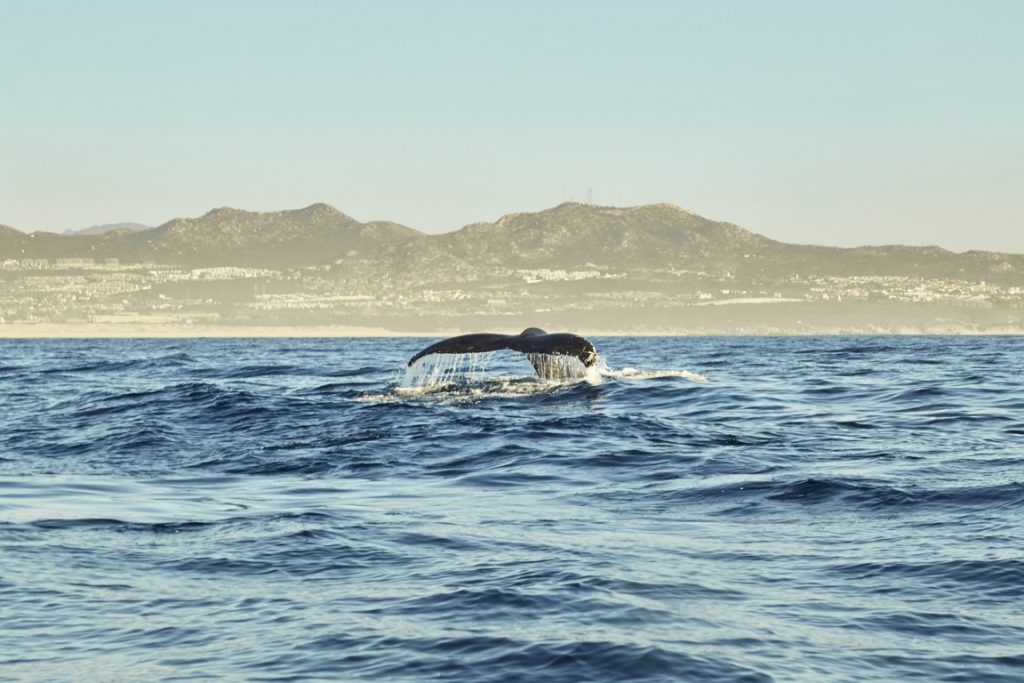
It’s therefore a great time to enjoy (responsible!) whale watching, getting a close-up look of the giant mammals and watching them interact.
Unfortunately, I was in Cabo at a different time and was not able to witness it this time like I did last year in Puerto Vallarta but oh well – one more reason to come back!
During the whale season, chances of seeing the animals are high (it’s not always 100%, but very very close), and you may even get a glimpse of them from the beach. To really get close to them, learn about their behavior, and snap stunning pictures, though, you’ll need to take a tour .
There are many tours in the area that offer whale watching experiences – remember to choose a responsible operator that matches your sustainable travel in Los Cabos.
Most tours are accompanied by an expert guide or biologist who’ll be able to answer all of your questions, and explain the whales’ migration patterns, eating habits, and life cycle as you admire them in their natural habitat.
➤ The Zodiac Whale Watching Adventure is led by a marine biologist and operated by a sustainable company. You’ll enjoy a free second tour if you don’t see the whales! ➥ BOOK IT HERE
Animalon by the Sea Dinner Cruise
This activity is NOT available anymore 🙁
Animalon by the Sea is a 3-hour sunset dinner cruise designed by an acclaimed Mexican chef, Javier Plascencia.
The journey takes place on a beautiful 49’’ boat that will sail across the sea of Cortez as you indulge in a delicious 5-course meal, fully made with seasonal and locally sourced ingredients.
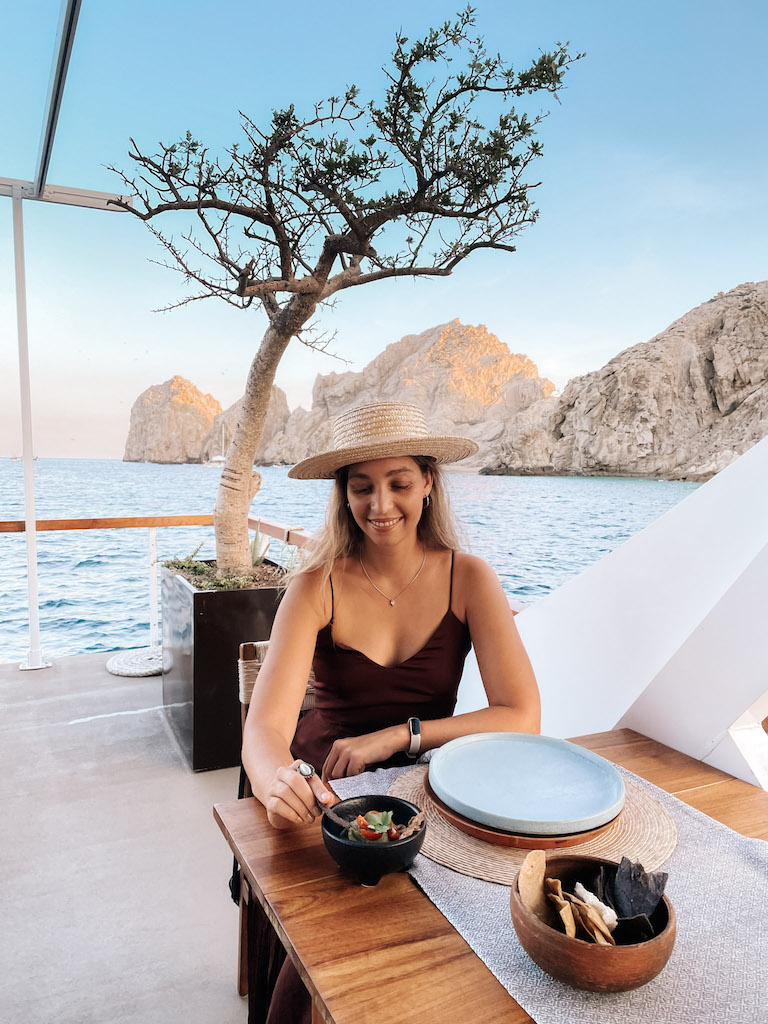
The activity places great emphasis in offering an ocean-to-table experience , which makes it unique and very sustainable.
If you go for the full experience, the menu is carefully paired with the perfect wine for each dish .
During the cruise, you might get to see dolphins , sea lions , and even whales swimming alongside the boat on the seas of Baja California Sur.
As the day comes to an end, you’ll be able to witness the peninsula and the famous Arch of Cabo San Lucas bathed in the golden sunset light. The boat lights up after dusk, conveying an enchanting atmosphere.

I loved the whole experience! It was probably my favorite activity in Los Cabos. The food was very good, and I was so surprised to see such beautiful creations come from the tiny boat kitchen.
But what makes this cruise so special is that you get the fine dining experience of a restaurant combined with some incredible sunset views that you can only get on a boat.
FARM-TO-TABLE RESTAURANTS IN LOS CABOS
Eating is a very ( extremely ) important part of any vacation…even more if said vacation is in Mexico!
Sustainable tourism in Los Cabos is taken very seriously, as you probably realized by now. That means that you’ll be able to find farm-to-table, sustainable restaurants where you can indulge in Mexican delicacies, being offered great quality without having a negative impact on the environment.
Below you’ll find two fantastic restaurants that guarantee impeccable service and food and a deep commitment to sustainability.
Flora’s Field Kitchen at Flora Farms
Flora’s Field Kitchen is located in Flora Farms, a sustainable estate that works the land by hand and where over 100 different herbs and vegetables are grown .
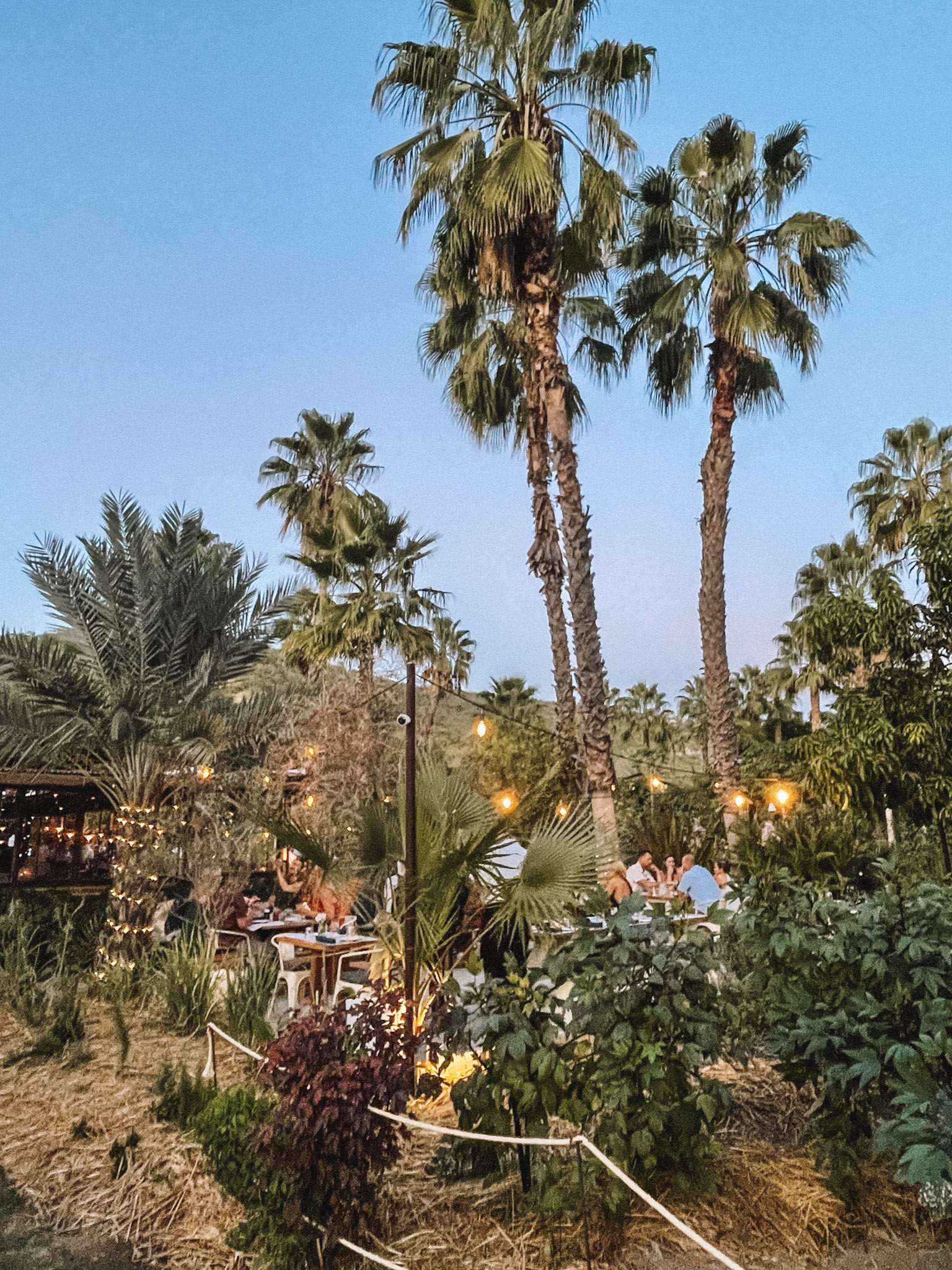
All items on the menu are handmade using the freshest ingredients , all of which come directly from the farm. This is where their field-to-table concept originates , creating a circle that starts with nourishing the soil and plating the seeds, and culminates in the wholesome dishes you’ll get to enjoy.
In fact, the restaurant aims to only serve what they grow and produce , which means their menu is seasonal. You’ll find vegetarian dishes as well as meat options, which come from animals raised humanly and with a healthy diet in the ranch.
There’s also a bar with views of the field that serves all the classic cocktails as well as fruit and vegetable-based ones, wine, and tap beer from Flora’s Brewery.
If you’re in the mood for pizzas, Mama’s Pizzeria , a section within Flora’s Field Kitchen, has its own wood-fired oven where 15 different types of pizza are baked . And it was good pizza! Trust me – I’m Italian after all 😉

We tried multiple dishes from the menu and liked each and every one of them. Everything tasted fresh, which makes sense considering the ingredients come from their own farm.
For drinks, I had both the Perro Perdido with sparkling wine and a Lavender Martini, and they were both so good.
House-made ice creams and sorbets for dessert can be bought at the ice cream cart on-site.
This restaurant is extremely popular, so you’d better book in advance if you want to eat here!
Opening Hours : Tuesday to Saturday from 9 AM to 10.30 AM, 11 AM to 1.30 PM, and 5.30 PM to 9 PM. Sunday brunch runs from 10 AM to 2 PM.
Don Sanchez
Don Sanchez is a restaurant located in San Jose del Cabo that specializes in contemporary Mexican cuisine.

All of the fruits and vegetables used in their kitchen are organic and locally produced ; seafood is regionally sourced and animals are also raised in Los Cabos. This way they ensure prime quality as well as a responsible treatment to the environment.
The restaurant is known for its excellent service and flavorful cuisine , and it offers a great wine menu to pair with your dishes, as well as the popular spirits of the region, including tequila and mezcal. They even have their own wine private label!
READ ALSO : Tequila Tasting in Cabo San Lucas
After starting with two unusually looking mezcal cocktails, we left the chef take over and prepare a tasting menu for us and it was a great choice. We loved every dish! In fact, this was one of the very best meals we had this year.
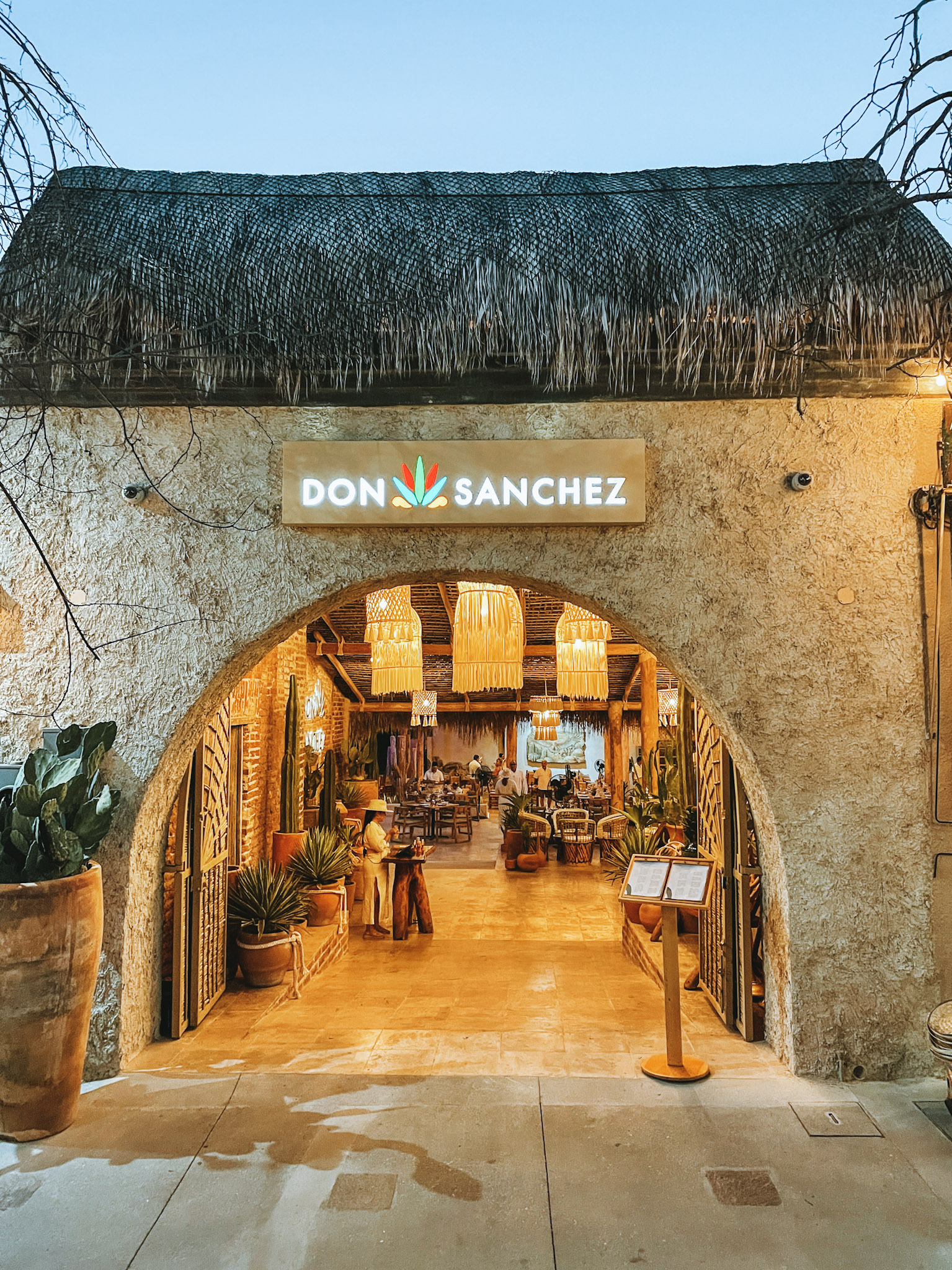
Their philosophy, which states that the creation of the best meals starts with the best ingredients, has led them to carefully choose where their produce comes from and implement the fabulous farm-to-table concept.
The menu includes raw seafood and tasty tacos, as well as meat-based main dishes and healthy salads and appetizers. There are quite a few options for vegetarians . In fact, we aren’t vegetarians, but we loved the plant-based dishes we were offered.
Opening Hours : Daily from 5 PM to 10 PM
WHERE TO STAY: AN ECO HOTEL IN LOS CABOS
We stayed at Hotel El Ganzo , considered one of the most sustainable accommodations in all of Mexico. In fact, it’s the first hotel in the country to be certified as a B Corporation , meaning that they meet the highest standards when it comes to environmental and social responsibility.
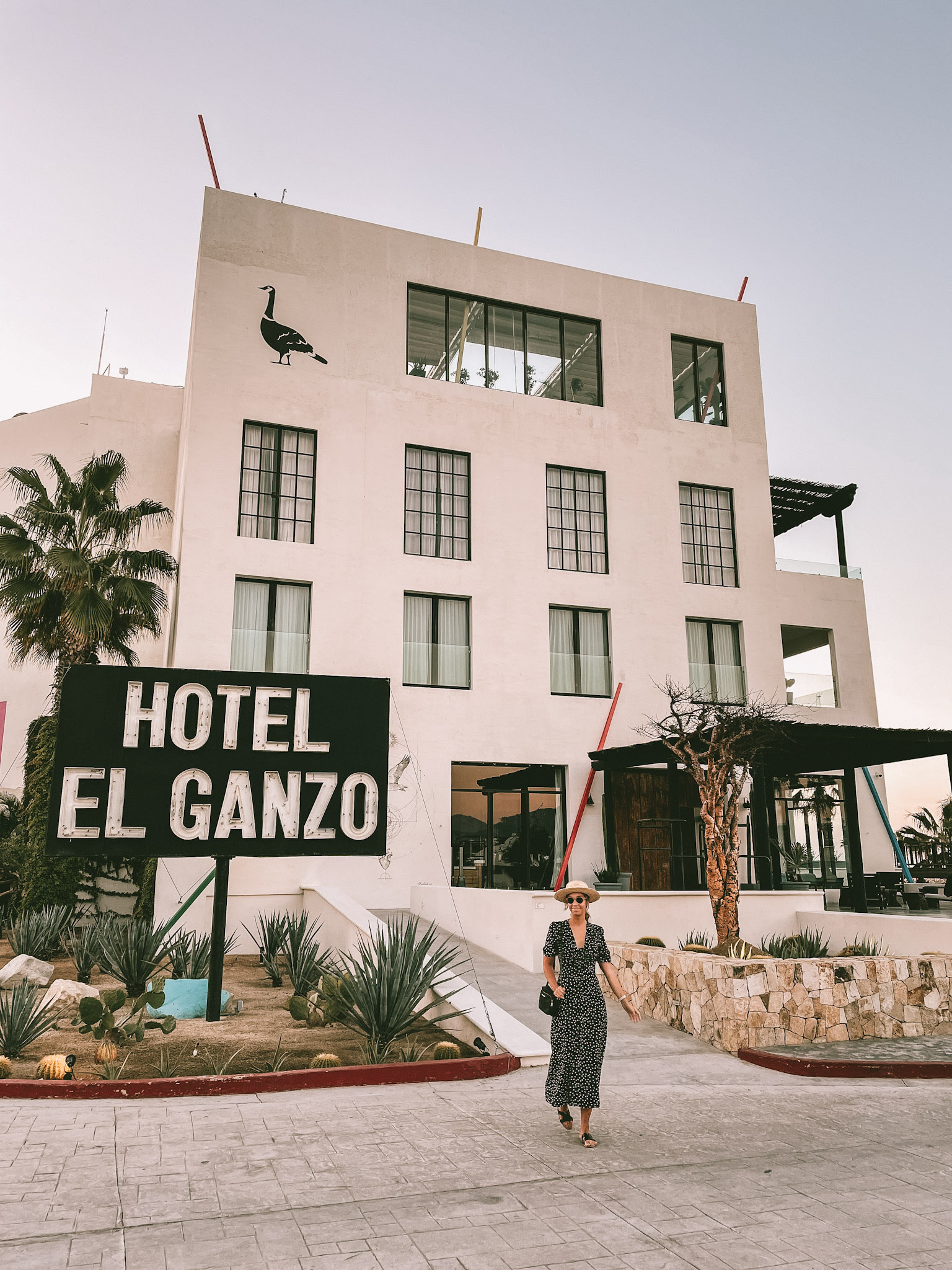
This eco-friendly hotel features luxurious one and two-bedroom rooms , some of which face the ocean, and a penthouse & honeymoon suite.
Our room was very spacious and featured a seating area, a very comfy bed, and a fully stocked complimentary minibar.

The highlight was probably the expansive terrace with a private jacuzzi overlooking the marina – nothing better than enjoying the view in the jacuzzi while sipping a glass of wine!

The bathroom was fully equipped, including a shower and soaking bath, organic toiletries, and robes.
There are also several dining options at El Ganzo , from an on-site restaurant to a rooftop bar to a taco food truck.
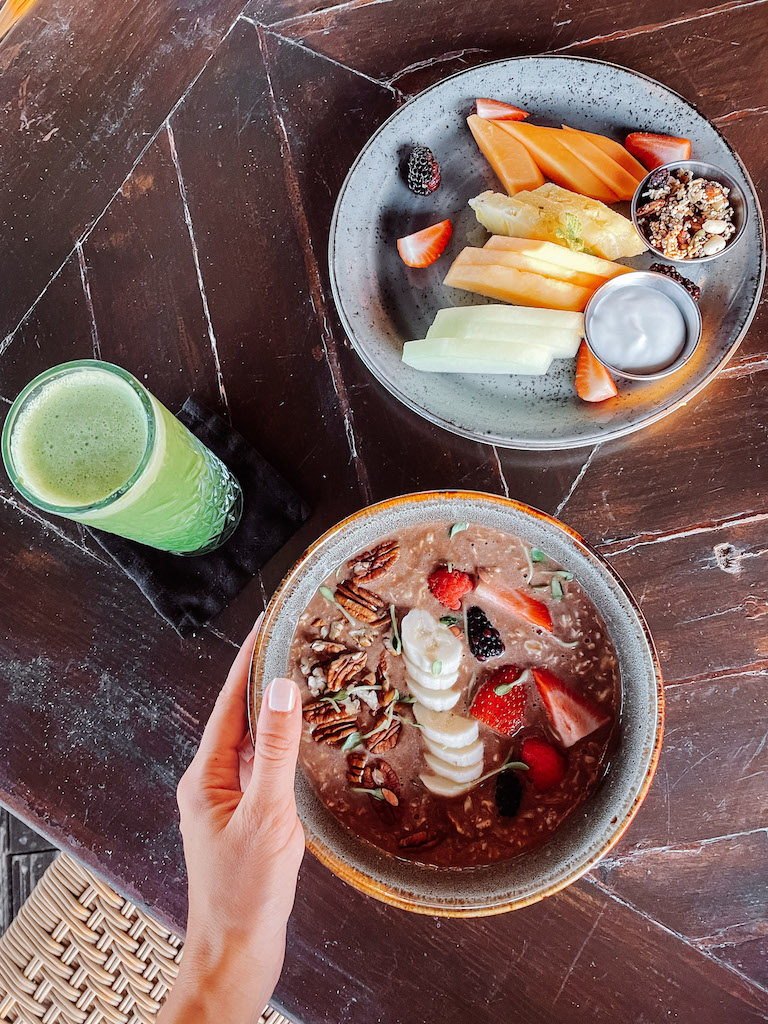
At El Ganzo you’ll find a private beach club reachable by a 1-minute boat ride, two swimming pools, and a fitness center. Pets are welcome as well!
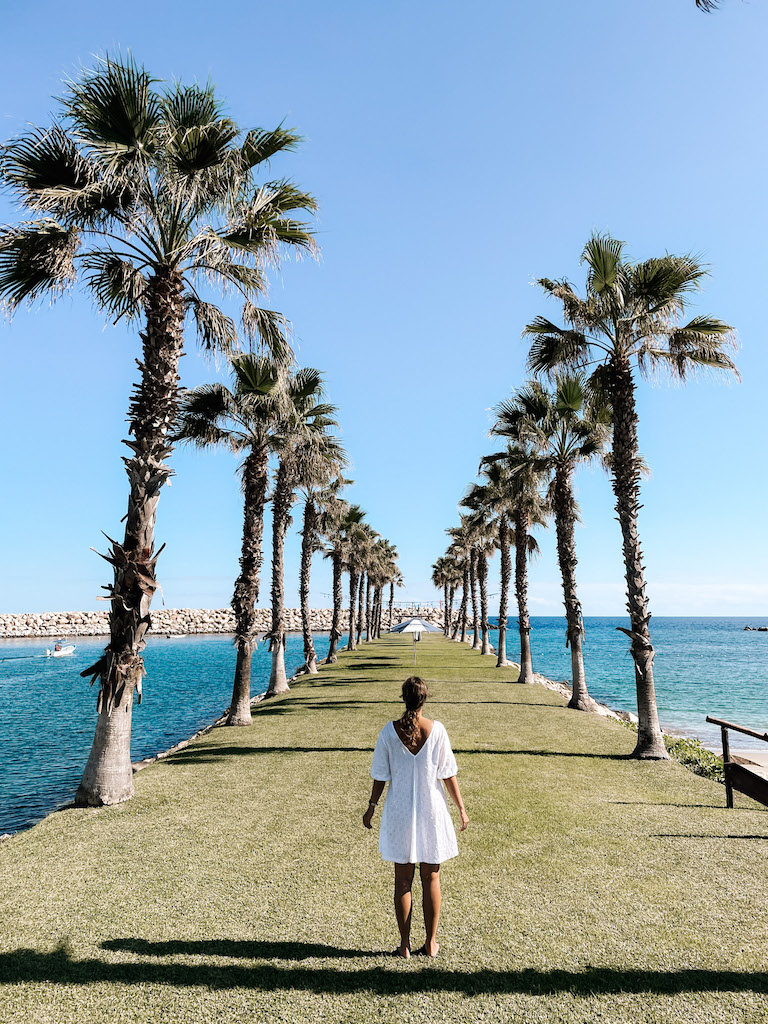
Its main rooftop pool is an infinity pool with incredible views over the San Jose del Cabo Marina, and a transparent jacuzzi in the middle of it. This must be the most Instagrammable pool in all of Los Cabos !

Besides luxurious rooms and suites, El Ganzo boasts a wellness & spa center where you can get anything from facials to massages, hydrotherapy, beauty treatments or yoga classes.
El Ganzo’s commitment to sustainability, though, is likely its main attraction if you’re reading this article. The hotel has in place an Environmental Management System that helps it monitor and reduce its waste .
The rooftop pool is heated with solar power, food waste is composted, single-use plastics have been eliminated, and guests’ carbon footprint impact is reversed by the purchase of carbon bonds.

El Ganzo also has a strong engagement with the community . It supports local businesses, provides a space for creativity and socialization at its Community Center, hires locally, and educates its staff during work hours.
The hotel also seeks partnerships with sustainable companies, like Water Matters, and encourages its guests to take part in the programs and support the eco-friendly projects it carries out.
CHECK RATES AND AVAILABILITY HERE
➤ Looking for something different? Other sustainable hotels in Los Cabos include Viceroy Los Cabos , Villa del Faro , Grand Velas , and The White Lodge .
Stefania Guglielmi is the founder of Every Steph. Originally from Bologna, Italy, she's been traveling full-time since 2016 and has visited over 50 countries across 6 continents. She believes sustainable travel and luxury travel can go hand in hand and has been advocating for responsible tourism since 2014. Stefania's advice and travel experiences have been featured in important publications such as Business Insider, Refinery29, and Yahoo Money.
Sign me up for the monthly newsletter!

Sustainable Tourism Options in Mexico – An Implementation of Hope
Are you wondering if there are sustainable tourism options in Mexico? Well, the answer is yes, absolutely! Mexico is forthcoming in sustainable and eco-tourism, with many amazing places to stay and activities that are respectful of the culture and environment!
Mexico is an increasingly popular tourist destination, known primarily for its beautiful white sand beaches, vibrant culture, and ancient Mayan history.
However, with the rise in awareness about sustainable travel options, many travellers wonder if Mexico offers sustainable tourism options.
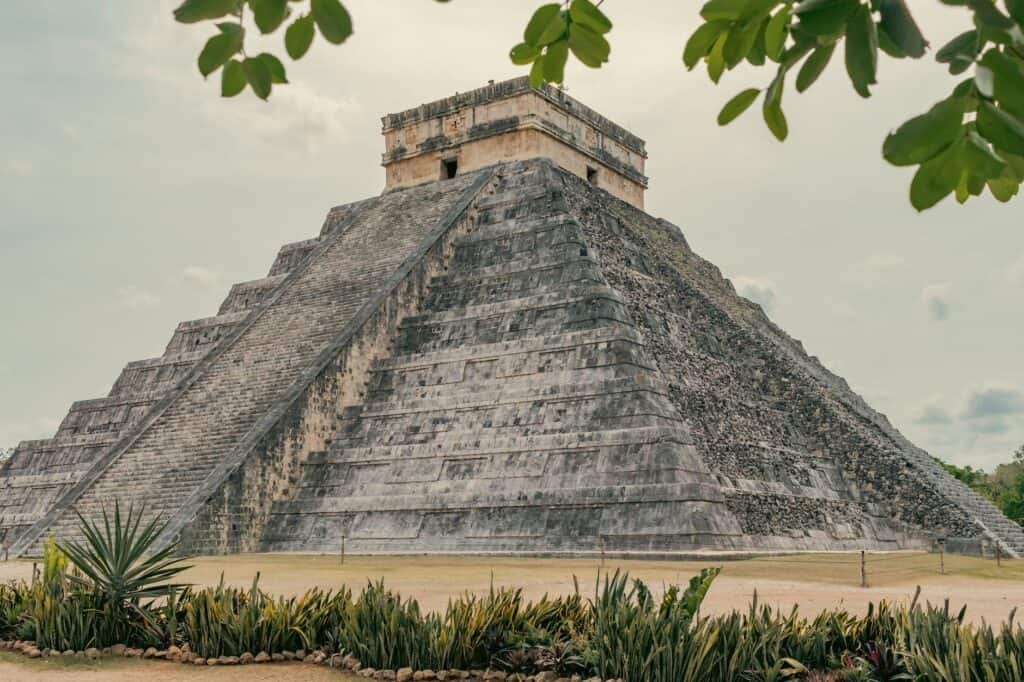
Sustainable tourism aims to minimise tourism’s negative impact on the natural environment, culture, and local communities while promoting conservation efforts and supporting the well-being of locals.
Mexico has made significant efforts towards sustainability in the tourism industry in recent years, implementing various initiatives and certifications.
In this article, we will explore the state of sustainable tourism in Mexico and discuss some of the sustainable travel options available to visitors.
Table of Contents
What is sustainable tourism.
Sustainable tourism, also known as responsible or eco-tourism, is a type of travel that prioritises environmentally and socially responsible practices. This includes minimising natural resources, reducing pollution and waste, supporting local economies and communities, and promoting cultural heritage.
Sustainable tourism aims to preserve the environment and protect vulnerable ecosystems while providing positive economic and social benefits.
Sustainable tourism can also enhance visitors’ overall travel experience by promoting travellers’ education and awareness of the importance of responsible travel.

By interacting with and supporting local communities, travellers gain a more profound, richer, and more authentic understanding of the culture and traditions of their destination. This type of travel allows tourists to impact the places they visit while creating unforgettable memories positively.
Read our post on CAN CULTURE SURVIVE WESTERNISATION? Here
Sustainable Tourism in Mexico:
Mexico has long been a popular travel destination. As such, the country has faced challenges balancing tourism growth with environmental conservation and community well-being. However, in recent years, Mexico has made significant efforts to promote sustainable tourism.
In 2014, Mexico launched the National Sustainable Tourism Program (PNST) to promote responsible practices and sustainable development in the tourism sector.
The PNST has established guidelines and standards for sustainable tourism, including environmental protection, cultural preservation, and economic benefits for local communities.
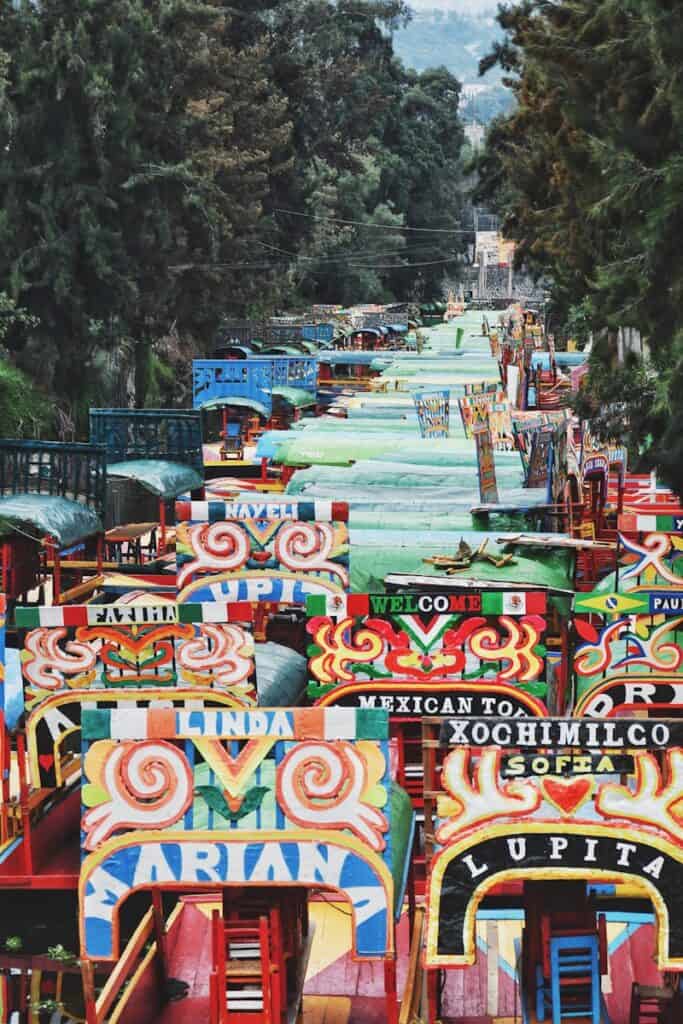
Additionally, Mexico has received various certifications for sustainable tourism initiatives, such as the Sustainable Tourism Certification (CST) and Green Globe Certification.
These certifications recognise destinations demonstrating a commitment to sustainability and responsible tourism practices.
Moreover, Mexico has implemented conservation efforts in popular tourist destinations such as Cancun, Tulum, Mexico City , and Cozumel to protect marine life and fragile ecosystems.
The government also encourages eco-friendly transportation options, such as electric buses and bicycles, to reduce carbon emissions and promote sustainable travel.

Sustainable Tourism Options in Mexico :
Fortunately, Mexico has various sustainable tourism options. Eco-tourism activities such as hiking, birdwatching, and wildlife viewing allow travellers to appreciate Mexico’s natural beauty while supporting conservation efforts.
Additionally, cultural tourism experiences such as visiting indigenous communities and participating in traditional ceremonies can provide economic benefits for local communities while promoting the preservation of their cultural heritage .
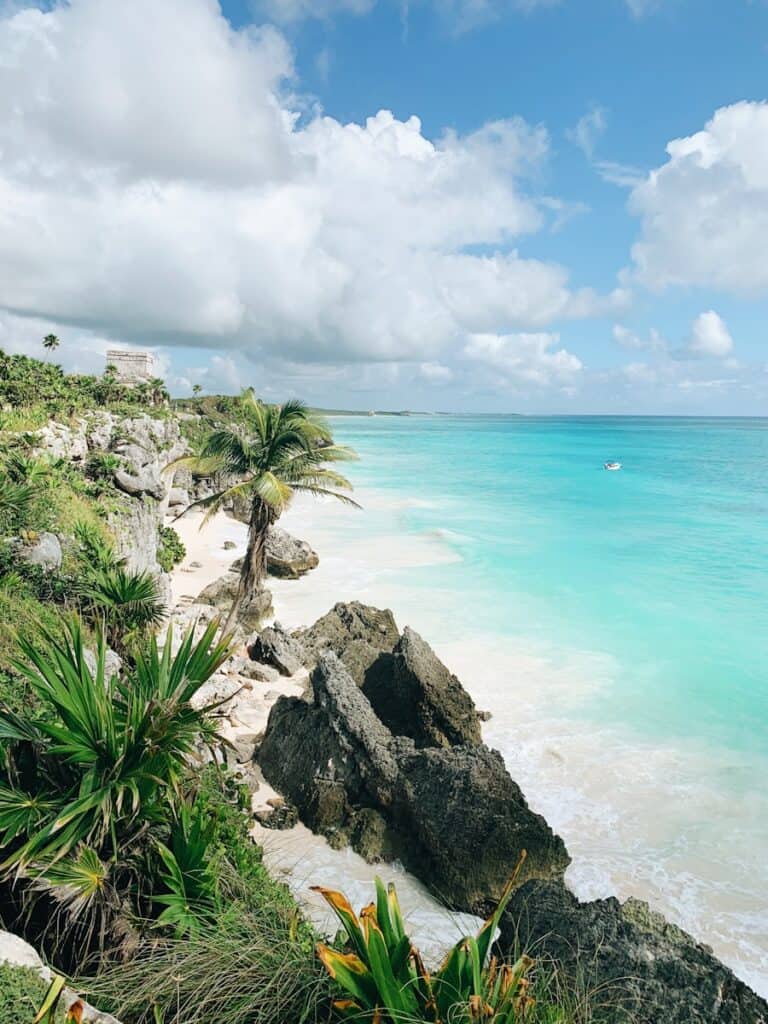
Furthermore, sustainable accommodation options such as eco-lodges and green hotels offer visitors a chance to stay in environmentally friendly properties that support local communities and use renewable energy sources.
CHECK OUR BLOG ON THE BEST ECO-TOURISM STAYS IN MEXICO
The number of sustainable tour operators in Mexico has also increased recently. These operators offer responsible tourism experiences, such as community-based tourism, volunteer vacations, and agrotourism. These options allow travellers to connect with local communities and contribute positively to their development.
Also, many restaurants in Mexico have begun using locally sourced and organic ingredients, promoting sustainable food practices. Some tour companies offer carbon offset options when booking tours or activities for those who want to offset their carbon footprint.
Effect of Increasing Sustainable Tourism Options in Mexico :
The efforts towards increasing sustainable tourism options in Mexico have shown positive results. In addition to enhancing environmental and social responsibility, sustainable tourism has provided economic benefits for local communities by creating job opportunities and supporting small businesses.
Moreover, the conservation efforts in popular tourist destinations have helped protect ecosystems and marine life, preserving these natural resources for future generations.
Sustainable tourism also promotes cultural preservation. Visitors are encouraged to respect and appreciate local traditions and customs, which can help preserve Mexico’s diverse cultural heritage for years.
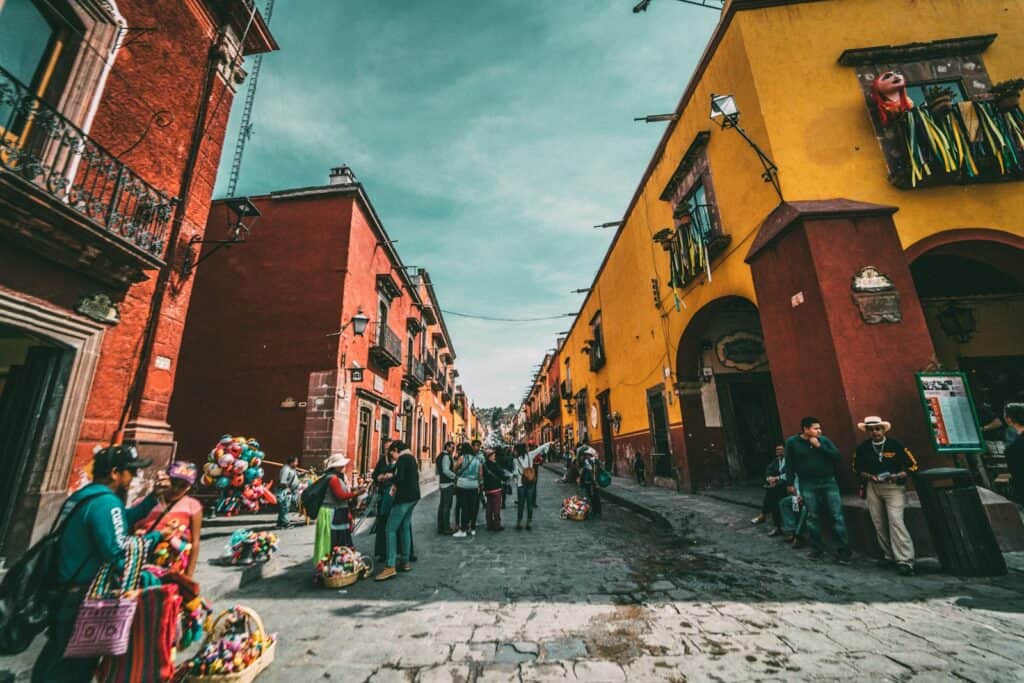
By choosing sustainable travel options, tourists can contribute positively to Mexico’s development while creating unforgettable memories. So, it is essential to continue promoting and supporting sustainable tourism practices in Mexico for a more responsible and enjoyable travel experience.
Tourists must also educate themselves on sustainable travel, make conscious choices to minimise environmental impact and support local communities. Together, we can ensure that Mexico remains a beautiful and culturally rich destination for generations.

Things to do as a responsible tourist in Mexico
As a responsible tourist in Mexico, there are many ways to support sustainable tourism and positively impact your travels.
- Choose eco-friendly accommodations : Look for hotels or lodges with sustainability initiatives such as energy-efficient practices, recycling programs, and use of renewable resources. (Read our Blog on Recommended Eco-Tourism places to stay)
- Use eco-friendly transportation options : Instead of renting a car, use public transportation or eco-friendly options like electric buses, bicycles, or walking to explore your destination.
- Support local businesses : Shop at local markets and support small businesses instead of buying from large corporations. This helps stimulate the local economy and supports the livelihoods of community members.
- Participate in responsible tourism activities : Choose responsible tour companies that promote sustainable practices and support local communities.
- Respect the environment : Follow guidelines and leave no trace when visiting natural areas. Avo id buys souvenirs made from endangered species or contributes to activities that harm the environment.
- Respect local cultures and customs : Educate yourself about the local culture and respect their traditions and customs. Ts helps preserve cultural heritage and promotes mutual understanding and respect.
- Reduce, reuse, recycle : Be mindful and considerate of your waste production and reduce it by using reusable products or properly disposing of trash in designated areas.

By following these simple tips and making responsible choices, you can help support sustainable tourism options in Mexico and contribute positively to the country’s development.
Can sustainable tourism be implemented in other countries?
Sustainable tourism practices can and should also be implemented in other countries. Every destination has unique environmental, social, and cultural aspects that require specific sustainability measures.
However, the principles of sustainable tourism remain the same: promoting responsible travel that benefits local communities and protects natural resources for future generations.
By implementing sustainable tourism practices globally, we can create a more equitable and sustainable tourism industry that benefits tourists and local communities.
Countries must work together towards sustainable tourism, which positively impacts the environment and communities and enhances visitors’ overall travel experience.
By choosing responsible travel options, tourists can positively impact while creating unforgettable memories worldwide.
Mistakes to Avoid in Sustainable Tourism :
While sustainable tourism is crucial for preserving the environment and supporting local communities, there are some common mistakes that tourists should avoid.
- Greenwashing : Greenwashing refers to businesses’ misleading or false claims of sustainability. Researching and choosing certified eco-friendly accommodations and tour operators is essential.
- Overtourism : Overtourism occurs when too many tourists visit a destination, damaging the environment and overwhelming local communities. It is essential to choose off-the-beaten-path goals and respect carrying capacity guidelines.
- Lack of respect for cultural customs : Not respecting local customs can negatively impact the community and cultural heritage. It is crucial to educate oneself about the culture and be respectful of local traditions and customs.
- Ignoring environmental guidelines can have severe consequences, such as littering or damaging natural areas. I must follow rules and regulations to protect the environment for future generations.
- Failing to support local communities : Supporting local businesses and initiatives is crucial for sustainable tourism. Failing to do so could negatively impact the community’s economy and livelihoods.
By being mindful of these mistakes, tourists can ensure their travels positively impact the environment and local communities. Sustainable tourism requires responsible choices and actions from tourists and businesses to succeed.
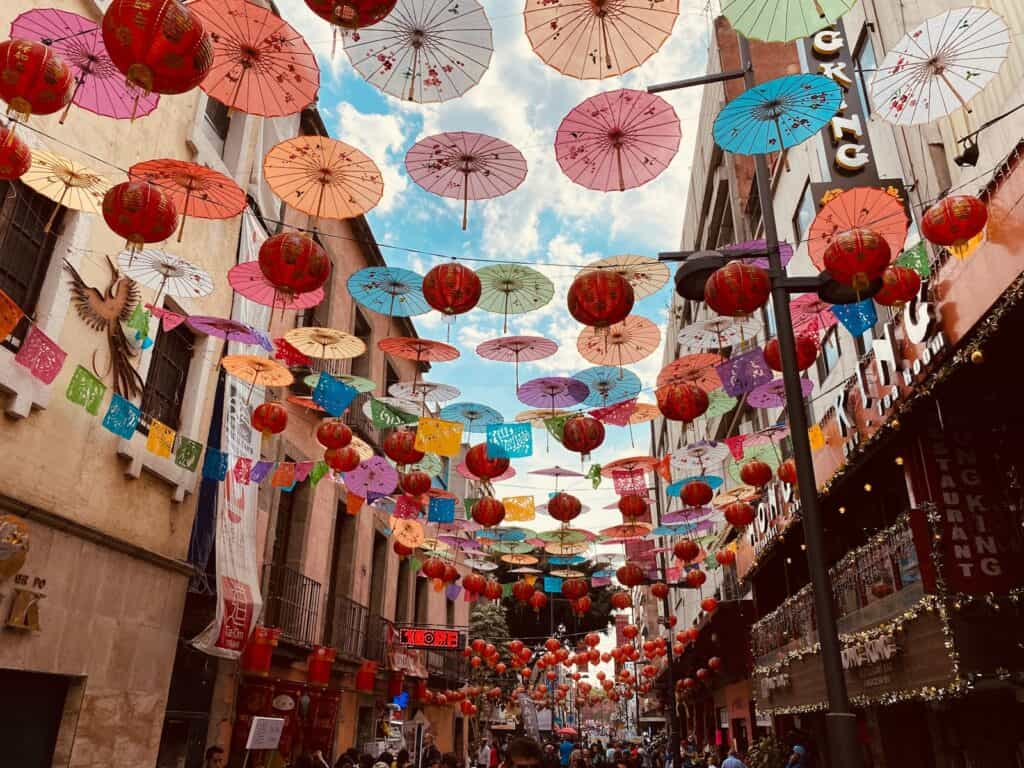
Can tourists make a difference in sustainable tourism?
Yes, tourists can make a significant difference in promoting and supporting sustainable tourism. Tourists can contribute positively to the environment and local communities by making responsible choices and supporting eco-friendly initiatives.
What are some benefits of sustainable tourism?
Some benefits of sustainable tourism include preserving natural resources and cultural heritage, economic development for local communities, and enhanced travel experiences for tourists.
How can I find responsible tour companies?
You can research and look for certifications such as the Global Sustainable Tourism Council (GSTC) or search for eco-friendly tours on websites like Responsible Travel or Ecotourism.org.
Is sustainable tourism expensive?
Sustainable tourism does not have to be expensive. It can save money by choosing eco-friendly transportation options, supporting local businesses, and reducing waste.
However, it is essential to be mindful of greenwashing and do research to ensure that you are truly supporting sustainable practices.
Sustainable tourism is crucial for protecting the environment, preserving cultural heritage, and supporting local communities. The increasing sustainable tourism options in Mexico is not only a good indicator of hope, but inspires more countries to do the same. Places like Bali could really take a leaf out of Mexicos book right now.
By making responsible choices and avoiding common mistakes, tourists can contribute positively to sustainable tourism in Mexico and other destinations worldwide.
We can create a more sustainable and equitable travel industry for future generations through collaboration between tourists, businesses, and governments.
Let’s all do our part to promote responsible travel and positively impact the world through sustainable tourism. So, when planning your next trip, remember to think sustainably! Happy travels!
RECENT POSTS on Sacred Footprints

Similar Posts
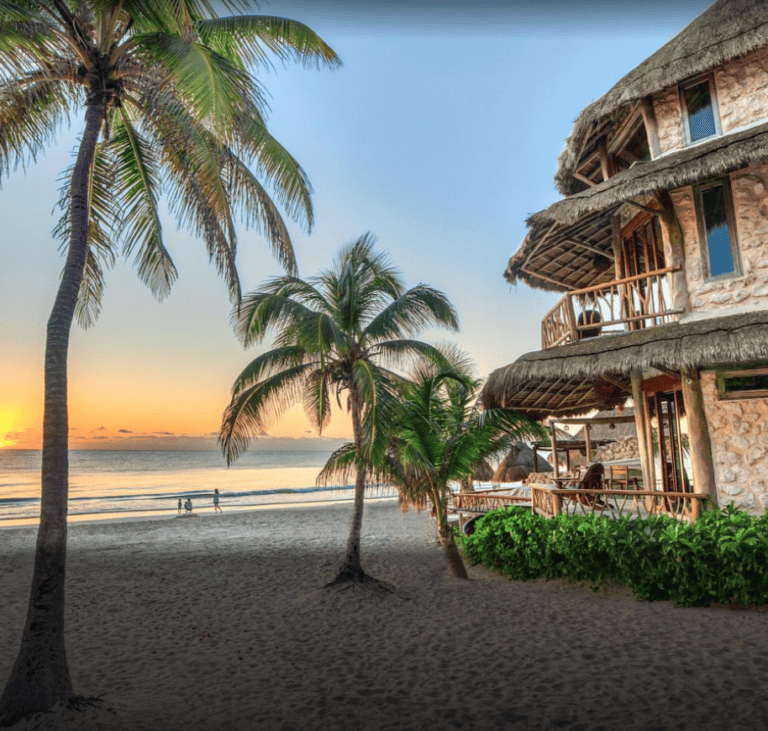
The Best Sustainable Eco-Tourism Places to Stay in Mexico 2024 – Beautiful & Unique Stays
Looking for the Best Eco-Tourism Places to Stay in Mexico? Well, we have got you covered. The quest for sustainable travel experiences has never been more significant in a world where environmental consciousness is growing. On my travels around the world in previous years, the increase in tourism (and not the sustainable kind!) is unfortunately…

Mexico Spirituality Explored: Beautiful Ancient Culture and Genuine Traditional Practices.
Mexico’s spirituality is a beautiful blend of ancient traditions, Catholic influences, and modern practices. It revolves around a deep connection to nature and the cosmos. It’s a land where the spiritual and the cultural unite in a dance of colours and beliefs. At the heart of Mexican spirituality lies a deep connection to nature and…

22 Ancient Mayan Ceremonies: Wisdom and Inspiration For Everyday Life
The ancient Mayan civilization, nestled in the heart of Mesoamerica, left an indelible mark on history with its advanced knowledge of astronomy, mathematics, and intricate city-states. Beyond their architectural marvels and scientific achievements, the Mayans were deeply spiritual people who engaged in many ceremonies to connect with the divine, honour their ancestors, and maintain harmony…

Destinations
Contact info.
- Sacred Footprints Enterprise House Wilmslow, Cheshire
Copyright© 2023 | Sacred FoodPrints | All Rights Reserved.
- Sandos Caracol
- Sandos Playacar
- Sandos Cancun
- Sandos Finisterra
- Sandos Atlantic gardens
- Sandos Benidorm Suites
- Sandos El Greco
- Sandos Monaco
- Sandos Papagayo
- Travel Tips
- Sustainability
- Playa del Carmen
Sandos Hotels & Resorts
Ecotourism in Mexico, a world of possibilities
Suppose you are tired of seeing buildings, concrete, and steel everywhere in the city and want to connect with nature again. In that case, it is time for you to give ecotourism a chance in Mexico, a way of traveling that allows you to reconnect with yourself while you get away from the hustle and bustle and daily stress of big cities.
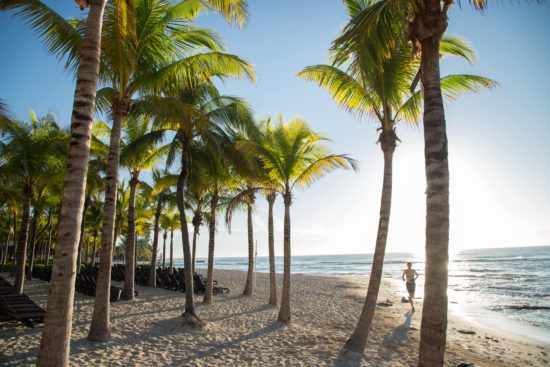
By delving into nature during your next vacation, not only will you be enjoying the natural attractions, but you will also be promoting the care of resources while helping the development of local species, who often depend on ecotourism to survive.
For Sandos, it is very important that you not only experience the ultimate vacation experience and taste the wonderful gastronomy of our restaurants, but we also want to encourage you to explore our destinations and experience everything they have to offer up close, especially when it comes to ecology.
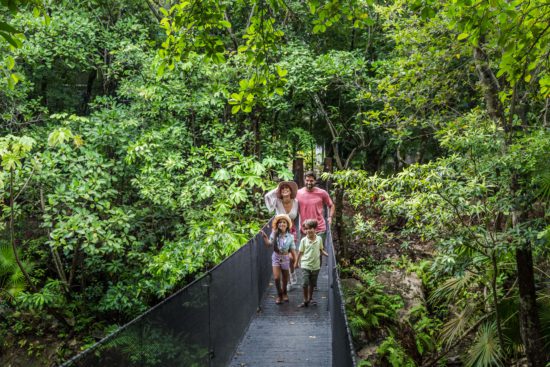
Mexico offers experiences in an infinity of ecological zones where you can relax, connect with your loved ones, and even embark on an extreme adventure. From north to south, the diverse ecosystems flora and fauna change, making it so rich that our country has earned the status of megadiverse. For this reason, no matter which region you visit, you will always find a corner where you can practice ecotourism activities and where you can take actions that allow the care of endangered species.
The Best Eco Friendly Vacation Spots
The best example of a sustainable ecofriendly resort is not in Hawaii, Cabo San Lucas or Puerto Vallarta it is in Playa del Carmen, Mexico.
Sandos Caracol is the first all-inclusive hotel that not only conserves the biosphere reserve surrounding the resort but also promotes sustainable travel (responsible travel) and long-term conservation.
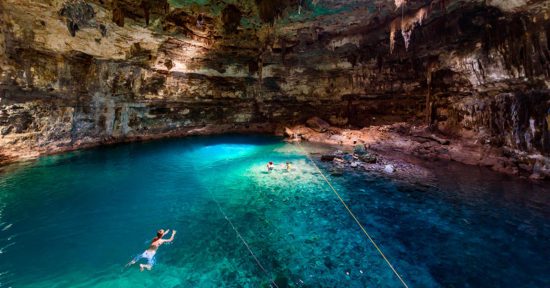
Sandos Caracol employs local guides and marine biologists to ensure that the natural areas such as the cenote and river system are treated with respect and kept pristine to maintain a healthy balance with the surrounding ecosystems.
The resort is just a short flight away from Mexico City and people in the US can fly direct to Cancun from a number of cities including Chicago. The eco hotel is popular with wildlife lovers who flock here to see spectacles such as the monarch butterfly migrations, and watch the howler monkeys, peacocks, spider monkeys, that are found on the grounds daily. Gusts can also take part in a number of eco tours and day trips.
If whale watching is on your bucket list then heading to Sandos Finisterra during the winter will allow you to spot whales from your beachfront suites, or you can organize a tour through our concierge.
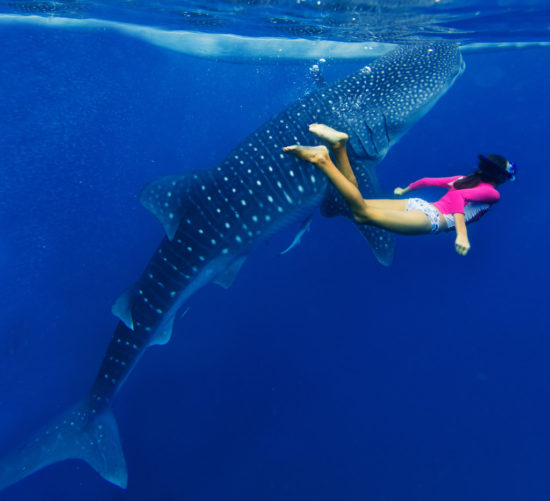
One of the most complete and diverse areas of Mexico is the Riviera Maya, where you will find all kinds of recreational activities to get closer to nature in ways that will change your perspective of the world. Imagine seeing the birth of a turtle or realizing how small the human being is when swimming with the sea’s titans , such as the whale shark; imagination is the only limit.
Ecotourism In The Riviera Maya
This southern region is home to three of our resorts, with a strategic location, perfect as a starting point for any of the excursions you decide to do in the area. Whether you want to spend a quiet day observing endemic birds , admire the beauty of the sea turtles up close, get lost in the jungle while swimming in a legendary cenote, or simply rest very comfortably in front of the sea a few steps from the jungle, Sandos Cancun, and Sandos Playacar will welcome you with open arms.
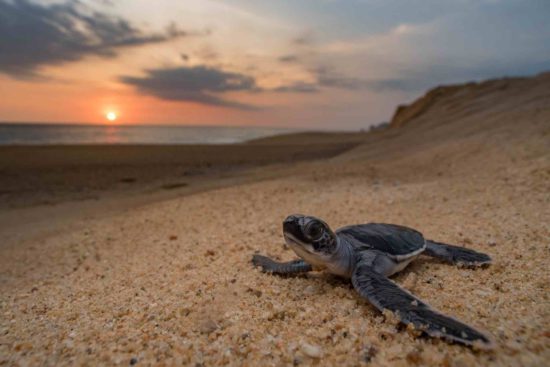
At the Riviera Maya, you will find our star of the jungle, Sandos Caracol. This hotel offers a magical experience with nature. Little by little, discover the exhilarating secrets that the jungle tucks away, from a water park for the whole family to natural wonders such as cenotes. Let yourself be carried away by the All Nature Experience program.
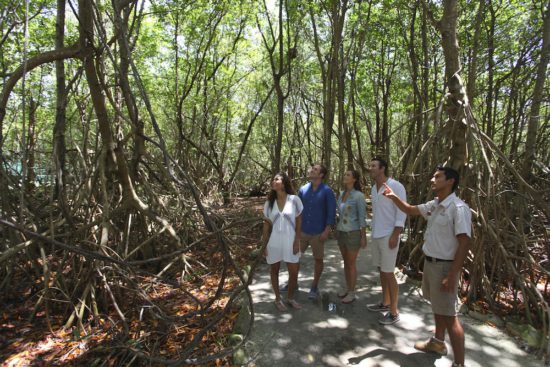
Regardless of your age, you can fully enjoy activities as simple as planting a tree and as exciting as crossing a mangrove river. It is also the perfect setting for romance; you can start the day by kayaking or cycling, while at sunset, a romantic boat ride that makes you feel like you’re in a movie. If you need reasons to visit Sandos Caracol, this complete program is guaranteed to give you plenty.
Ecotourism In Los Cabos
Los Cabos tourist corridor in the southern part of Baja California Sur is the door to a vast and wonderful marine life, unique in the world. In this paradise that combines a desert ecosystem with the Pacific Ocean’s secrets, you will find activities that you will undoubtedly remember for a lifetime.

Do not miss the opportunity to explore the coast and meet friendly sea lions resting on the rocks, or admire the arrival of the humpback whales either from the top of the mountain or aboard a boat if you want to experience their greatness up close.
Sandos Finisterra is the ideal place for an adventure in Los Cabos, as it is not only located a few steps from emblematic sites such as El Arco, but the situation also provides easy access to the entire tourist corridor, offering an unsurpassed view of the Sea of Cortez.
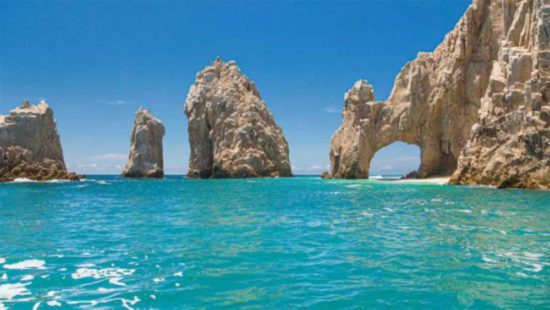
Don’t think twice and start planning your next ecotourism adventure in Mexico; you have many paces to choose from; the only thing you have to do is pick a point on the map and start exploring all of the possibilities around it.
If you have any questions or want to consult with the professionals, meet with our Seek & Go representatives upon arrival, they will gladly give you a variety of activities in nature to choose from that you can enjoy comfortably, but above all safely.
Share this article
Recent News Slideshow
The best activities to take part in this day of the dead, sandos hotels & resorts: giving guests more reasons to smile , the benefits of booking your vacation early, most commented posts.
- Most commented
Subscription
Book with Confidence - we want you to be as confident as possible when planning your next vacation. Learn More >>

SUSTAINABILITY
Journey Mexico is committed to low impact, environmentally, and socially sensitive travel that prioritizes community participation. Our experience has shown that supporting local businesses that protect pristine natural areas helps to ensure their sustainable future. We have never been more aware of the need for conscious living and this extends to all aspects of our lives. We actively work with local communities and non-profit organizations with missions based in conservation and sustainable development to make good on the promise of ecotourism as a catalyst for sustainable development; we invite you to learn more about our efforts to protect the pristine coasts, mountains, canyons, and jungles of Mexico.
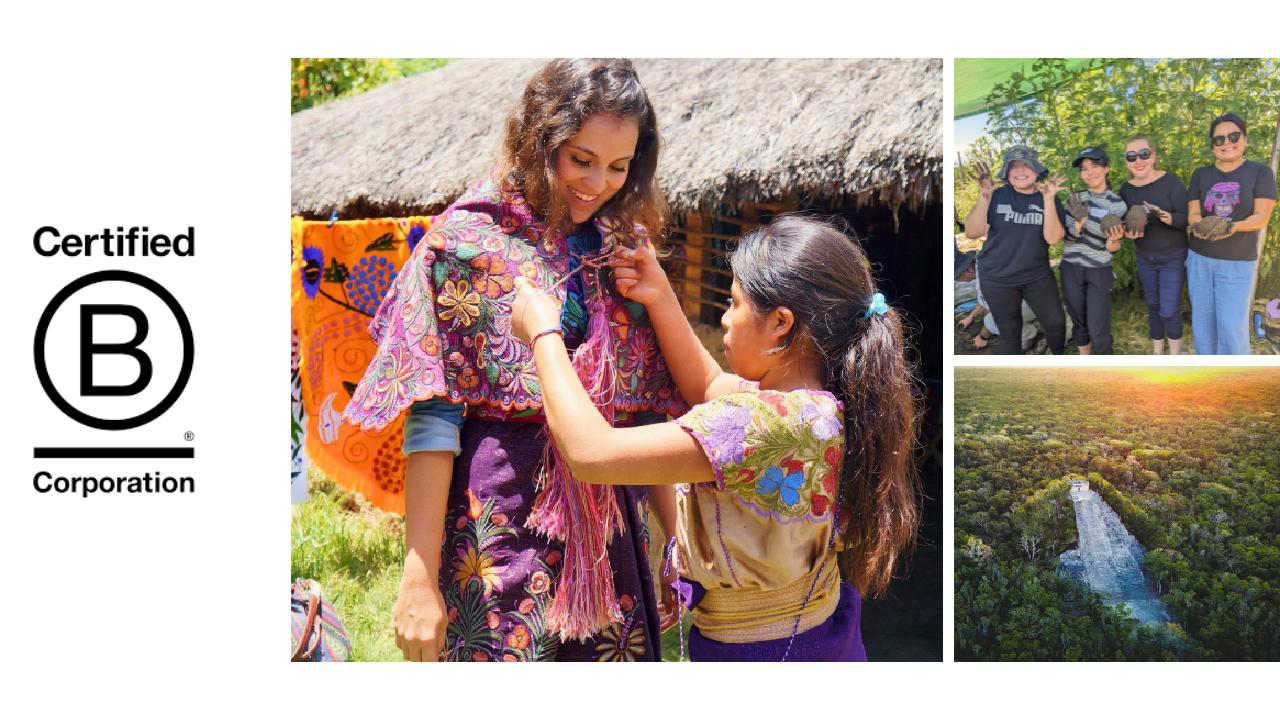
OUR POSITIVE IMPACT PARTNERS
Journey Mexico´s Responsible Travel Fee directly support the below NGOs in Mexico. Each of the civil societies we support have been chosen because of their tangible impact on the biodiversity, traditions, and communities that make Mexico so special.
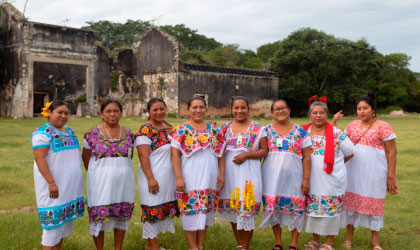
Mundo Maya Hacienda Foundation
Where: Yucatán, Campeche and Quintana Roo states
The foundation strives to strengthen the capacities and skills of the residents of Mayan communities in the Yucatán Peninsula, generating microregional development hubs with the participation of residents as promoters of their own projects. This helps to promote the identity, recognition, and preservation of Maya culture whilst working towards eradicating poverty and the social marginalization of the communities. Their projects include: rescuing traditional Mayan medicine and herbalism, strengthening the overall health of families and improving access to primary care; access to education constructed by the community members, integrating cultural elements specific to Mayan culture; and improved housing in rural communities through a Self-Construction Housing and Infrastructure program – the foundation provides materials and oversight while families manage the construction process themselves.
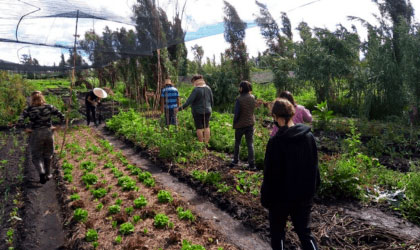
Where: Mexico City
REEDUCA has a strong commitment to the conservation of Mexico´s natural resources, biodiversity, and ecosystems. Their multidisciplinary team of biologists and educators runs and collaborates on several campaigns in Mexico City and the Pacific Coast including bird and sea turtle conservation projects, organizing events, workshops and training related to the conservation of natural resources, and a project called “Chinampas en Movimiento” which focuses on reactivating pre-Hispanic, agroecological crop cultivation techniques in Xochimilco`s chinampas (man-made plots of fertile land) & cleaning the habitat of the endandered axolotl salamander.
RESPONSIBLE TRAVEL FEE
Total donations, $1,200.00 usd.
as of June 01, 2024
PURPOSEFUL TRAVEL EXPERIENCES
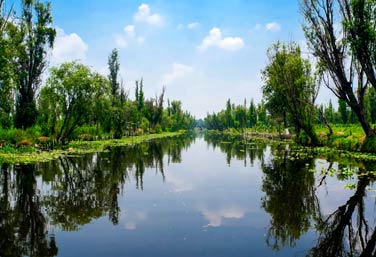
Discover the Enchanting World of Axolotls and Chinampas in Xochimilco
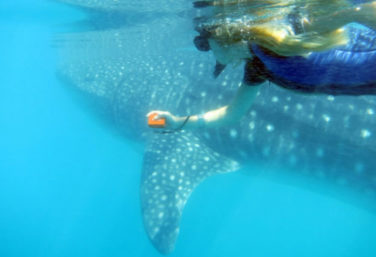
Researcher For a Day with The Whale Sharks of Baja California Sur
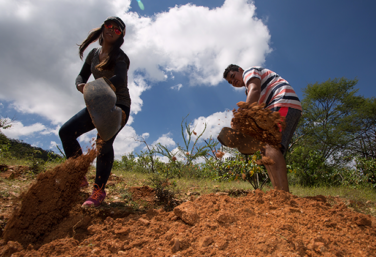
Reforesting Sierra De La Laguna Biosphere Reserve
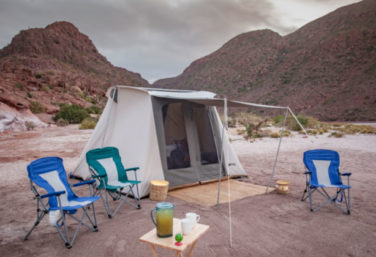
Sea Turtle Conservation Expedition in Baja California
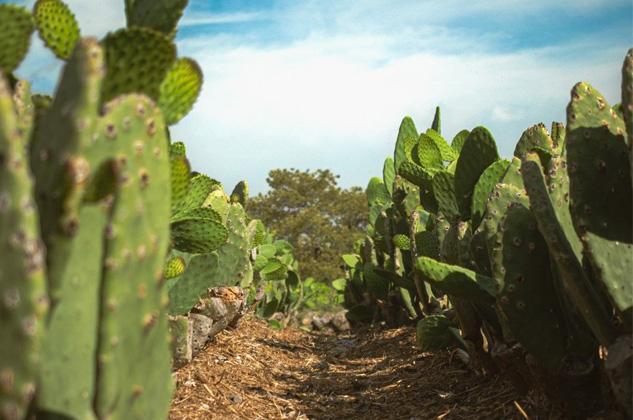
Sustainable Culinary & Agricultural Delights at Milpa Alta
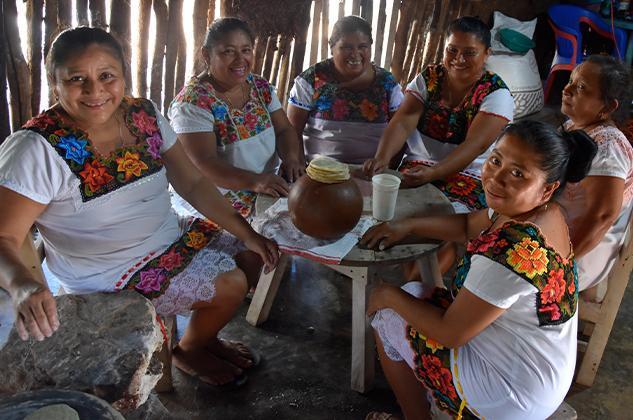
Exploring Mayan Horticulture & Tradition Gastronomy in the Granada Community
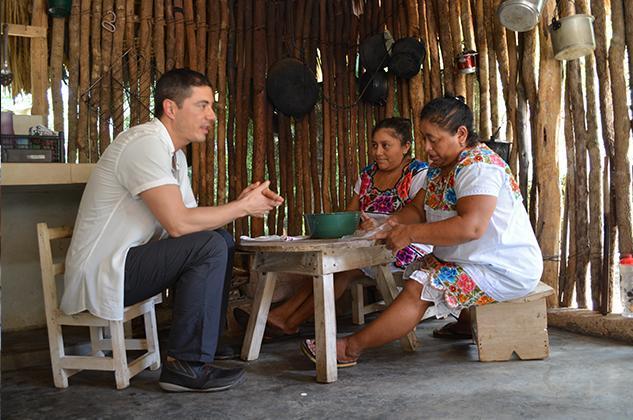
Yaxunah Community: Mayan Horticulture & Traditional Gastronomy with Cooking Session

Dive into La Paz’s Coral Restoration Initiative
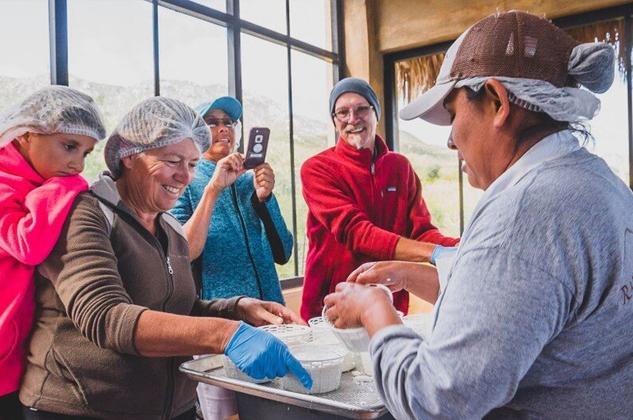
Hands-On Cheese Workshop at Rancho Cacachilas
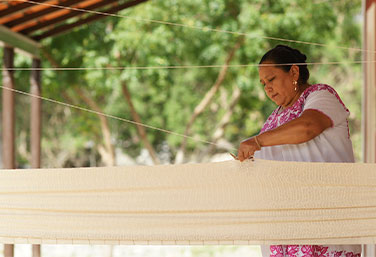
Experience the Artisan’s Hammock Workshop in Tixkokob
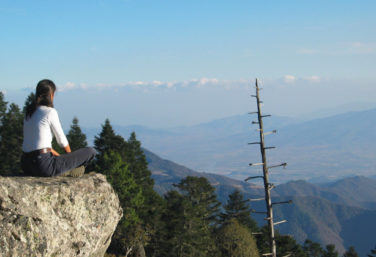
Exploring the Majestic Sierra Norte Mountains
Our stories #journeygivesback.
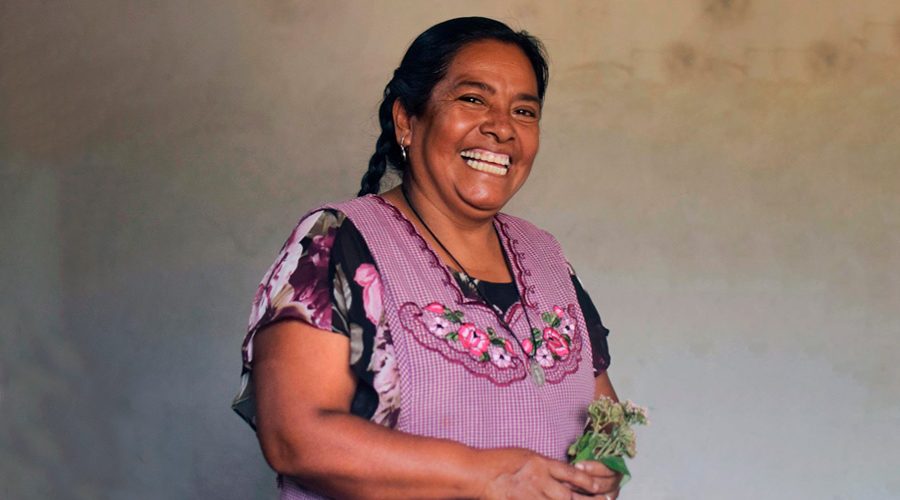
OUR RESPONSIBLE TRAVEL FEE: WHAT IT IS AND WHO IT BENEFITS
Responsible travel fee: what it is and who it benefits.
We´re thrilled to be implementing Journey Mexico´s Responsible Travel Fee
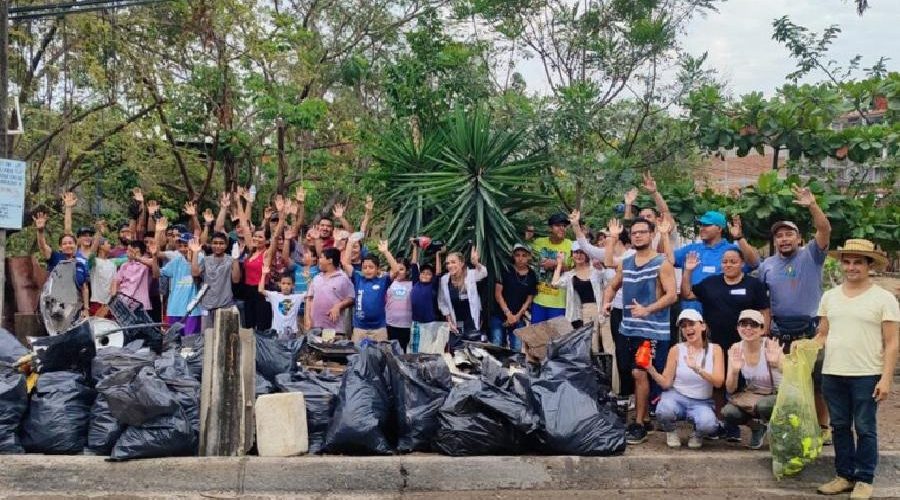
PUERTO VALLARTA RIVER CLEAN UP
Puerto Vallarta Ecology Department and Casa Hogar Emmanuel Children’s Group Home.
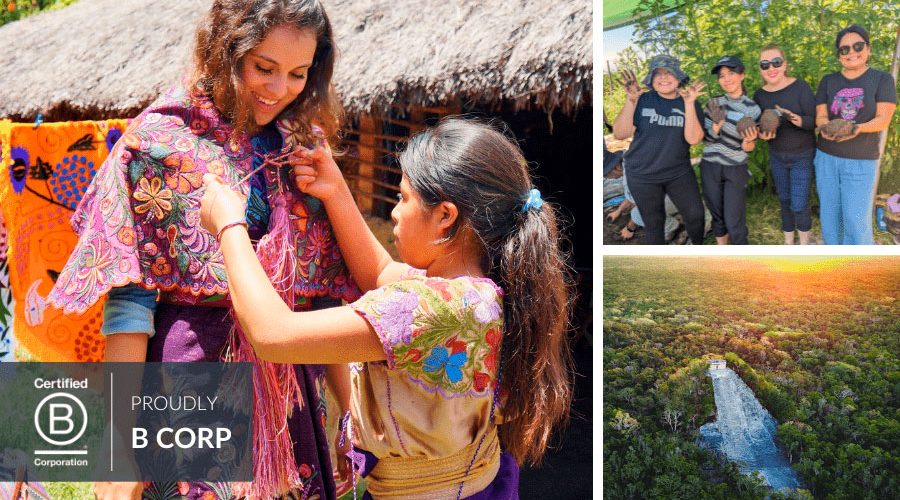
JOURNEY MEXICO B-CORP CERTIFIED
Journey Mexico is now officially B-Corp Certified!
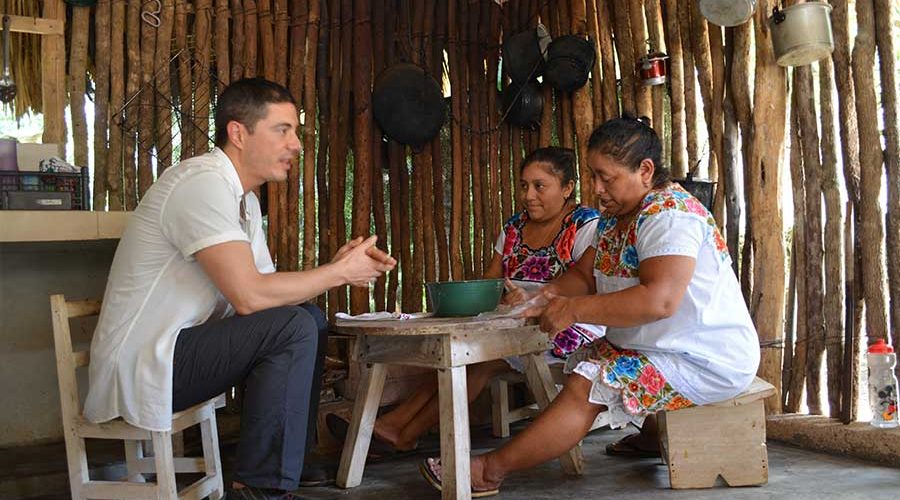
COMMITMENT TO SUSTAINABILITY AND COMMUNITY IMPACT
Travel can and should support local communities and environmental projects.

UNCOVER THE MAYAN TRADITION OF HANAL PIXÁN
Hanal Pixán incorporates rituals like creating an ofrenda alongside their favorite objects.
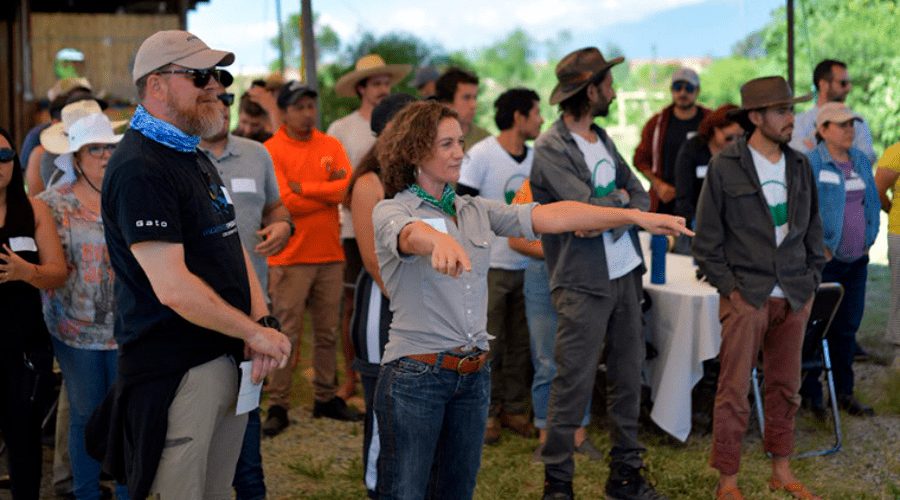
JOURNEY MEXICO’S SUSTAINABILITY COMMITTEE
It´s crucial to align all our operations to the principles of responsible travel.
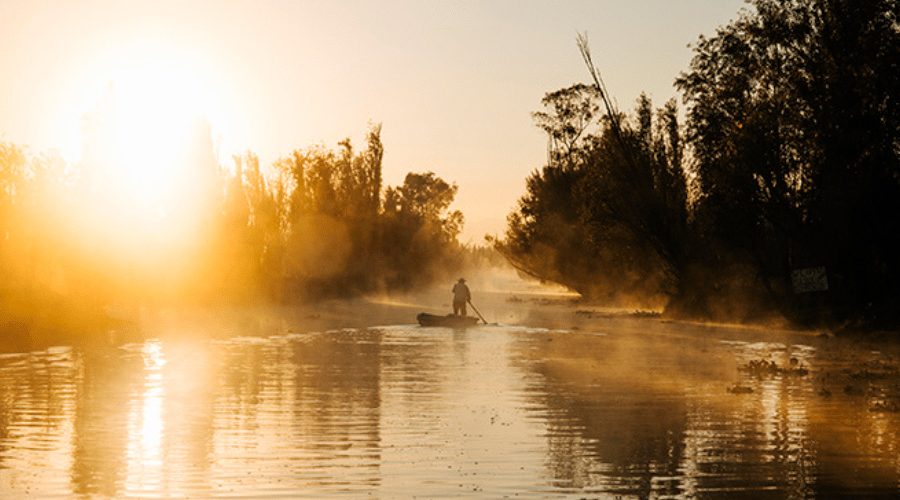
ANCESTRAL AGROECOLOGY IN MEXICO CITY
Our aim with these articles is to spread the word, share knowledge, and inspire action.

- Baja California
- Mexico City
- Pacific Coast
- Colonial Mexico
- Yucatan Peninsula
- Riviera Maya, Tulum, & Cancun
- San Miguel de Allende
- Puerto Vallarta & Punta de Mita
- Copper Canyon & N. Mexico
- Guadalajara & Tequila
- Off the Beaten Path
- Romance & Honeymoon
- Art & Native Crafts
- Active Adventures
- Nature & Wildlife
- Landscapes of Mexico
- Food & Wine
- Air Expeditions
- Family Vacations
- Executive Retreats
- Private Villas
- Weekend Escapes
- Summer Travel
- Day of The Dead
- Luxury Hotels & Resorts
- Private Villas & Residences
- Chable Hotels
- Special Offers
- Why Journey Mexico?
- Why Custom-Made Itineraries?
- Testimonials
- Travel Safety
- Sustainable Tourism
- When to visit

IMAGES
VIDEO
COMMENTS
This concept germinated in the 1980s when Mexico started promoting sustainable tourism to conserve its diverse ecology and rich cultural heritage. Top Ecotourism Destinations in Mexico. Mexico offers vast ecotourism destinations promising physical beauty and immersive experiences. Visit the whale nurseries in the Baja California Peninsula, the ...
Defining Eco-Tourism In Mexico. But, first, what does "eco-friendly" actually mean? While the definition varies slightly depending on who you ask, the Global Sustainable Tourism Council explains it as a niche segment of tourism in natural areas that particularly focuses on ethical, low-impact, locally-oriented trips.. It's easy to confuse eco-friendly tourism with sustainable travel, as ...
Now that you have an idea of what to expect at an eco resort, read on to discover our picks of the top 15 eco-friendly resorts in Mexico! Each of these places offers the chance for a relaxing escape from daily life amid peaceful, natural surroundings. 1. The Overall Best Eco Resort in Mexico - The House in the Woods. $$.
Sustainable Travel & Ecotourism in Mexico. Mexico's ecological diversity is among the broadest of any country in the world, with an abundance of ecosystems ranging from the northern deserts to the central conifer forests, and the southern tropical rainforests. Mexico also supports 111 million people and welcomes more than 20 million visitors ...
1. Sian Ka'an Biosphere Reserve, Quintana Roo. Sian Ka'an, meaning "Origin of the Sky" in the Mayan language, is one of Mexico's most impressive protected areas, boasting a UNESCO World Heritage designation. This sprawling 1.3 million acre reserve is home to an incredible variety of flora and fauna, including over 350 bird species ...
Explore Mexico's ecotourism and discover sustainable adventures in nature. From ancient ruins to stunning national parks, embark on an unforgettable journey through Mexico's eco-friendly destinations. Experience the vibrant wildlife and breathtaking landscapes while preserving nature.
Sustainable tourism is a hot topic, with the travel pause enforced on us by the coronavirus pandemic giving us the opportunity to reflect on our lifestyles. ... Consider ditching headliners Mexico City and San Miguel Allende in exchange for the chance to get acquainted with under the radar places such as Taxco and Guanajuato. Support locally ...
Mexico. Sustainable travel in Mexico. Sustainable tourism in Mexico is a natural fit. With vast landscapes, an abundance of wildlife, and a culture interlinked with nature, the country makes the perfect eco-friendly destination. Snorkel on the Great Mesoamerican Barrier Reef, the second-largest reef in the world, trek through one of the 40 ...
Examples of sustainable tourism in Mexico. In our country there are a series of examples of sustainable tourism. Some of these include: Rural tourism: This allows travelers to enjoy the nature and culture of rural areas, contributing to the economic and social development of these areas. For example, the Mexican government's "Pueblos Mágicos ...
We Are Sustainable Tourism. Sustainable tourism, often called eco-tourism, is all about traveling thoughtfully. Our approach ensures minimal environmental impact, prioritizes your well-being, preserves cultural heritage, and boosts local economies and social benefits in the communities we treasure. Sustainable Travel with The Green Maya Project:
How One Lagoon Is Becoming a Hub for Sustainable Tourism in Mexico. Three new boutique hotels are serving as templates for turning the town of Bacalar—and its iconic lake—into Mexico's most ...
Mexico has made significant progress in promoting sustainable tourism and offers numerous opportunities for travelers to engage in responsible and eco-friendly travel experiences. From sustainable accommodations to responsible tourism activities, Mexico provides a range of options for those who wish to minimize their environmental impact.
Collaborations with WWF, SEMERNAT, Adventure Travel association, Ecotourism Society, and The Smithsonian School to create environmental protection plans. Awareness campaigns about the ecosystems of Mexico and how to help rehabilitate them. A few of their best tours: Whale Sharks Cancun Tour. Length: 5-8 hours.
Fortunately for Mexico, its sustainable tourism hotspots and forward thinking outlook were key to helping it recover from the economic slowdown faster than it otherwise would have. Mexico's Sustainable Attractions. Mexico has countless tourism attractions that are eco-friendly and socially sustainable.
Officially San Francisco, this slow-paced, hippy town is located in the neighboring state of Nayarit. The town is host to fantastic eco-friendly accommodation options, delicious vegan restaurants, and a tight-knit community with a passion for its people and the environment. By supporting this smaller-scale tourism industry, your tourist dollars ...
Consumption. Buy local products: Purchase crafts and products made in the region you visit, promoting the local economy and reducing the impact of transporting products. Avoid single-use plastics: Carry your reusable water bottle, cutlery and cloth bags with you to minimize the consumption of disposable plastics. 5.
The proposals generated by the communities themselves were strengthened with a pilot model of sustainable tourism that recovered the strengths of Airbnb together with the UNESCO Mexico guide, which built six selection and management criteria for the initiatives, such as sustainable social impact and local economic flow, and encourage visitors ...
Seizing the opportunity represented by the fourth edition of the Sustainable & Social Tourism Summit in September 2020 (hereinafter, "the Summit"), the most important sustainable and social tourism event in Ibero-America, which is held yearly in Mexico, the organizations La Mano del Mono and Sustentur co-facilitated a virtual meeting in which ...
When Los Cabos Tourism invited me to explore the sustainable side of Los Cabos, I had to say yes! Los Cabos is, in fact, one of the leading ecotourism destinations in Mexico, and its sustainability efforts, combined with the glorious natural attractions it possesses, make it an unrivaled spot for a vacation.
What are the key features to look for in the best sustainable eco-tourism places to stay in Mexico? When searching for sustainable eco-tourism places in Mexico, prioritise accommodations that integrate renewable energy sources, promote local conservation efforts, practice waste reduction and recycling, and offer educational experiences on ...
Sustainable Tourism in Mexico: Mexico has long been a popular travel destination. As such, the country has faced challenges balancing tourism growth with environmental conservation and community well-being. However, in recent years, Mexico has made significant efforts to promote sustainable tourism.
The Best Eco Friendly Vacation Spots. The best example of a sustainable ecofriendly resort is not in Hawaii, Cabo San Lucas or Puerto Vallarta it is in Playa del Carmen, Mexico. Sandos Caracol is the first all-inclusive hotel that not only conserves the biosphere reserve surrounding the resort but also promotes sustainable travel (responsible ...
Journey Mexico is committed to low impact, environmentally, and socially sensitive travel that prioritizes community participation. Our experience has shown that supporting local businesses that protect pristine natural areas helps to ensure their sustainable future. We have never been more aware of the need for conscious living and this ...